

Croatia in April: What It’s Really Like, Weather & Tips
By Author Jurga
Posted on Last updated: February 2, 2024
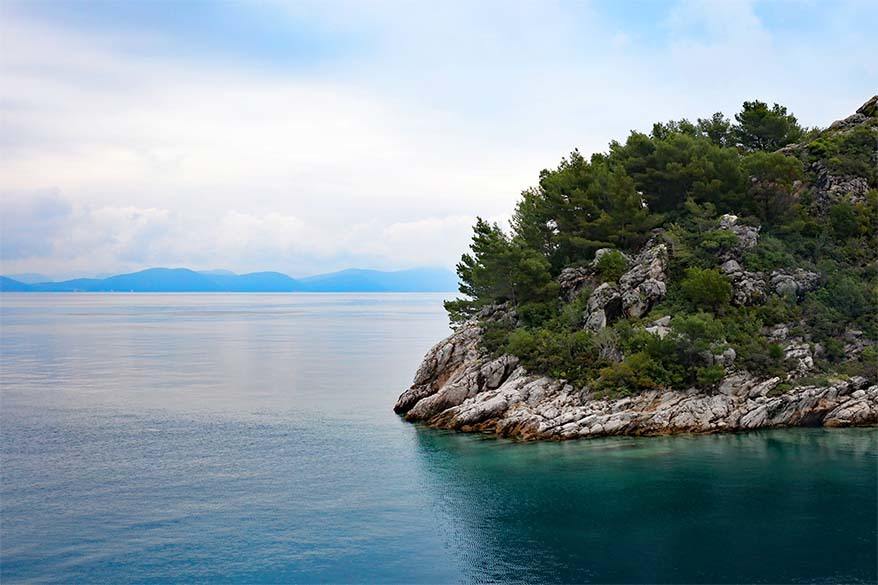
Are you considering a trip to Croatia in April and wondering what it’s really like and if April is a good time to visit Croatia ? This post should answer all your questions.
We always heard that the best time to visit Croatia is from May to September. However, since we could only travel to Croatia in April, we figured there wouldn’t be that much difference between April and May… We couldn’t have been more wrong.
We visited Croatia during Spring Break, just before Easter. In this article, I’m sharing our experience and the advantages and disadvantages of visiting Croatia in April .
You can also read what it’s really like to visit Dubrovnik, Split, Plitvice, or Croatian islands in April . Find out!
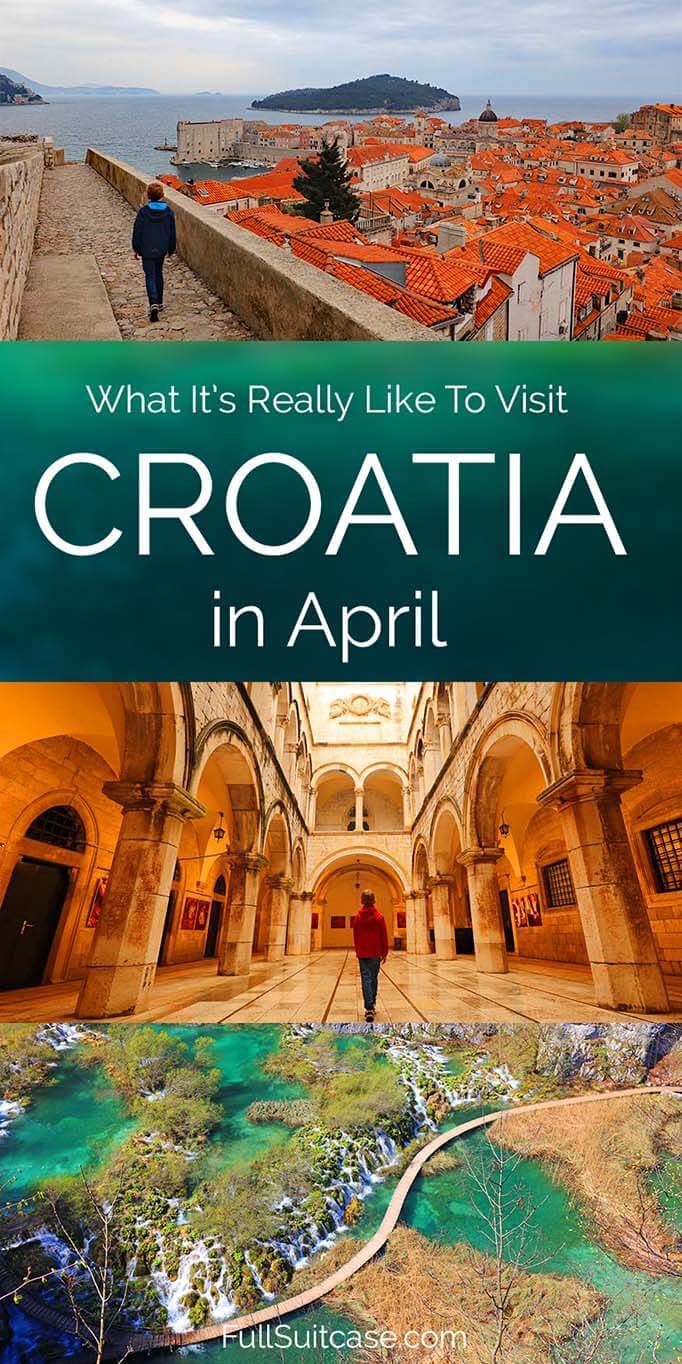
What is the weather like in Croatia in April?
The weather in Croatia in April varies a lot and also depends greatly on which part of Croatia you visit. Since it’s a bit of a shoulder season, you can really expect all kinds of weather in Croatia in April .
We had 20°C (68 F) sunny weather on some days and also many days when it was just 10-12°C (50-54 F) and lots of rain. Most days we had a bit of everything – rain and sunshine and temperatures between 8 and 22°C (46-72F).
Two days before we arrived at Plitvice Lakes NP, it was snowing there, and temperatures were just above the freezing point. Whereas now we had sunny weather and 18°C (64 F). Yes, this was all in the same week.
We were told by the locals that while it’s not uncommon to have warm and sunny weather in April, it’s just as likely to have cold rainy weather. Whereas May weather is much more stable and chances are high that you’ll have warm and sunny weather during your entire vacation if you visit Croatia in May.
So to summarize, if you visit Croatia in April, you should be ready for every type of weather.
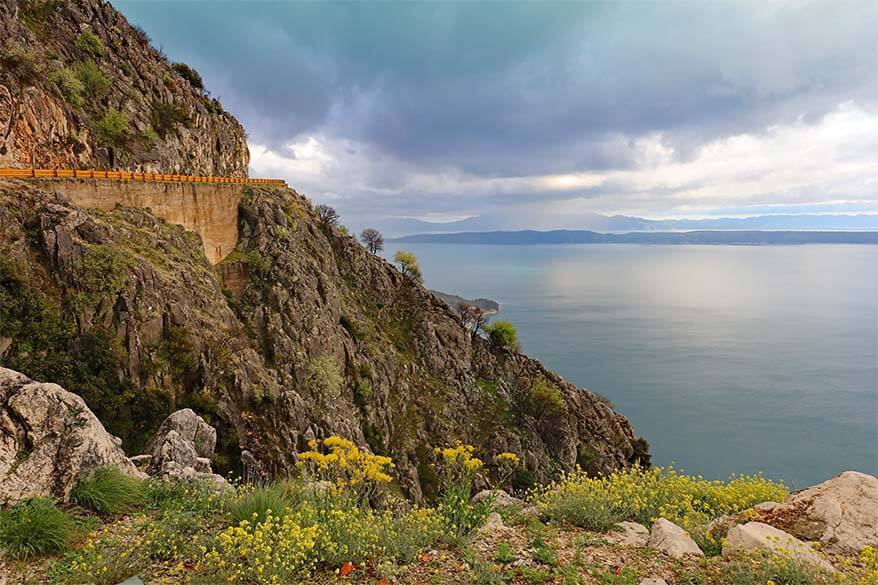
Biggest advantages of visiting Croatia in April
Don’t despair – there are actually many advantages of traveling to Croatia in April, as opposed to high season months. Here are some of the main things that we liked about Croatia in April:
1. There are fewer tourists in Croatia in April than in summer
One of the reasons we chose to visit Croatia in low season was the hope to avoid the crowds. We heard that Croatia is extremely busy in summer and places like Dubrovnik and Split can get so crowded that you can’t even pass the City Gates without risking your lives…
While there are some cruise ships in Croatia in April, it’s nothing compared to the summer months.
I have to say that if you want to avoid the crowds, then visiting Croatia in April was definitely the right choice. We had so many amazing and popular tourist attractions all to ourselves. For example, we met a total of 5 other people on Dubrovnik City Walls. We were the only tourists in Mljet National Park. Also on Brac island we didn’t meet any other tourists…
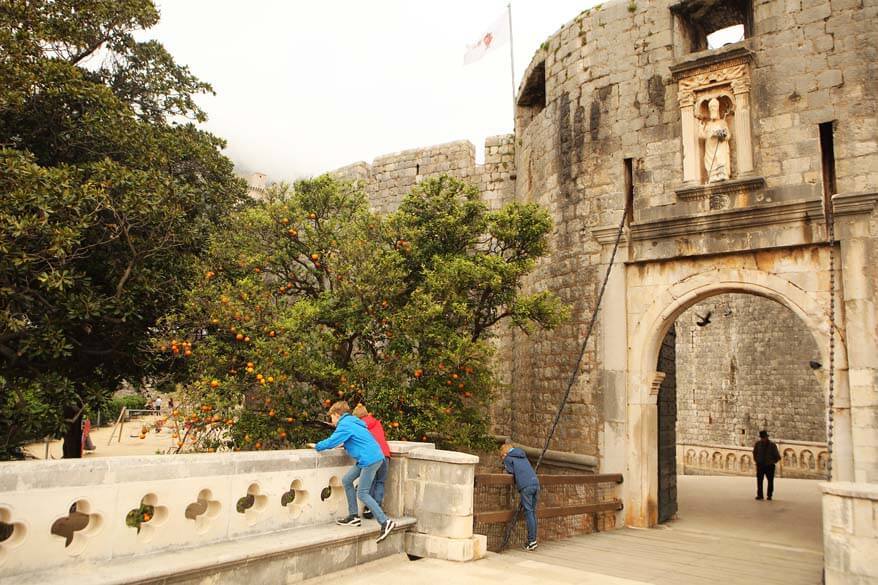
2. Many places are already open in April
While April isn’t a very popular month to visit Croatia, some businesses start to slowly open after the winter. So, compared to the winter months, April is a much better month to visit Croatia than, for example, February or March.
Some day trips and boat tours that aren’t available between November and March, start running again in April. Some bars and restaurants that are closed in winter, are already open for business in April. Some tourist attractions that close for the winter season, start to operate again in April…
For example, April was the first month when some companies started to run boat tours, which enabled us to visit the Blue Cave from Split .
At the same time, please keep in mind that many places aren’t yet open in April and will only open in May, some only in the second half of May…
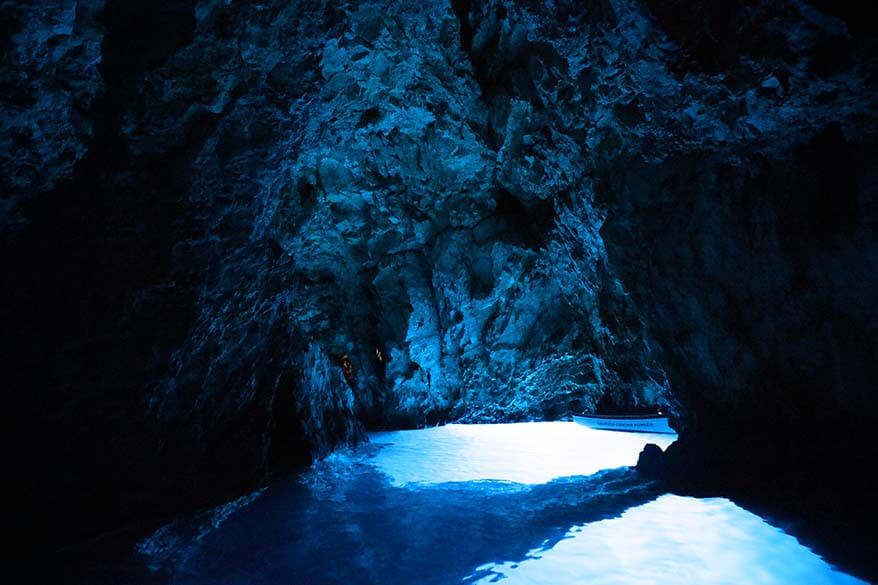
3. It’s cheaper to visit Croatia in April than in summer
Croatia is an extremely popular tourist destination in summer. Accommodation prices skyrocket in July and August. In April, you’ll often pay about 30-50% less for your accommodation than in July. Furthermore, many places have minimum stay requirements in high season, whereas in April we could just book one-night stays that suited our itinerary best.
Renting a car is also much cheaper in April than in the summer. For example, we paid less than 17 EUR/ day for a big rental car for our family. There is no way you can find the same deal in summer! We use and recommend this car rental website to find the best car rental deals when we travel – check it out and book your car asap – prices go up significantly if you book close to your travel dates.
Needless to say – the flights are also much cheaper in the low season than in summer. In our case, coming from Belgium, the price difference between April and July was over a thousand euros for our family of five (we paid less than a thousand to start with).
Some tourist attractions are cheaper or even completely free in low season . In general, there doesn’t seem to be that much difference between admission prices in low or high season, but some places do offer discounted rates in low season. For example, Sponza Palace in Dubrovnik was free to enter when we visited, whereas in summer you have to pay .
The same was true for some sea cave visits on the earlier mentioned Blue Cave tour; caves and beaches that require a fee in summer were free of charge in April.
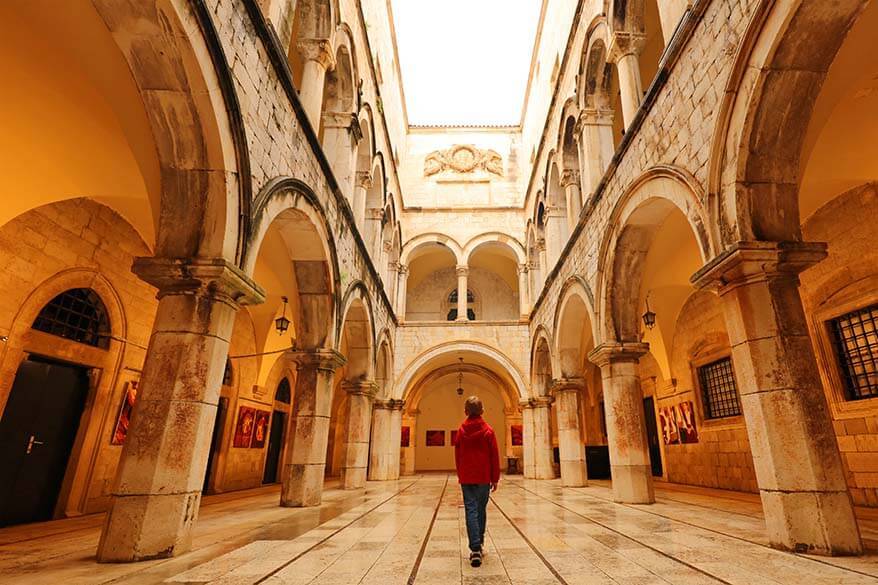
4. The weather is ok for sightseeing
Since summers are usually really warm in Croatia, it is often too hot to do much sightseeing if you are traveling in the high season. Every guidebook we read had warnings about the heat and advised to visit the most popular outdoor attractions early in the morning.
This was not really a problem in April at all. Even the warmest sunny days during our trip were just perfect for sightseeing . No need to worry about getting sunstroke on the city walls of Dubrovnik in April.
Visiting places like Dubrovnik, Split, Kotor, Mostar, Zadar, and many other smaller towns in April was as good as it gets. Not too hot, not too busy, and just lively enough to be enjoyable.

Main disadvantages of visiting Croatia in April
Despite all the positive sides of visiting Croatia in April, there are also quite some negative ones. Find out!
1. Unpredictable weather
We found that the biggest disadvantage of traveling to Croatia in April is the unpredictable weather. It was changing all the time! Usually, we had all kinds of weather in one day, with a torrential downpour one moment and beautiful sunny weather just minutes later…
This isn’t that much of a problem in towns as you can always enter a church or a museum if the weather gets too bad. But if you are visiting Croatian islands and National Parks, it’s really no fun to be there in the pouring rain or heavy fog and 10°C (50 F).
Take a look at the two pictures below. They were taken in the same place, within less than half an hour. It was raining so hard that we didn’t feel like getting out of the car when we arrived in Mljet National Park. Luckily for us, the rain stopped and so we could visit the park just as planned.
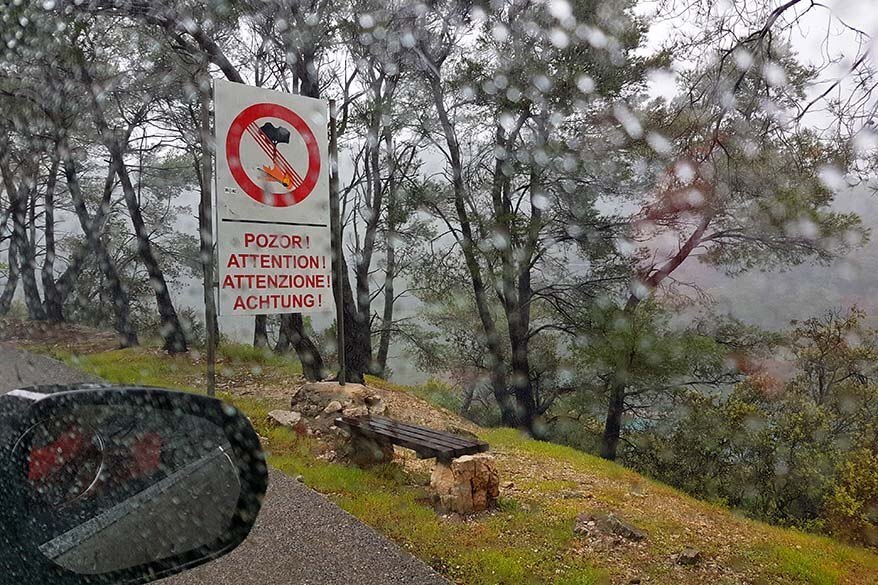
2. It’s too early for swimming
Even if the weather is warm, seawater and swimming pools are too cold for swimming in April in Croatia.
When we visited, we saw signs in Krka National Park that you can only swim from the first of June till the end of September. However, please note that swimming at the waterfalls in Krka National Park is now completely forbidden, no matter the season.
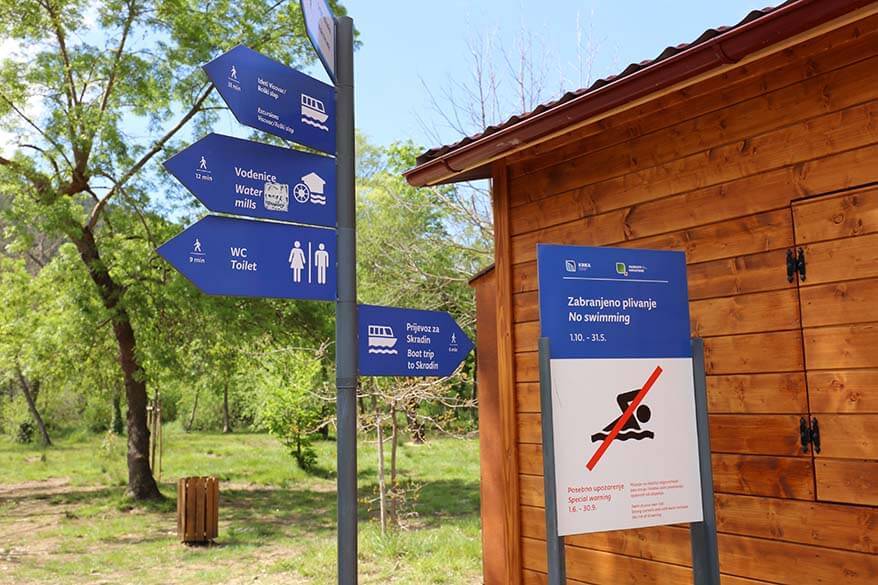
3. It’s too cold for the beach
All the beaches that we visited in Croatia in April were deserted. Even on the days when it was warm, there was nobody around and all the beach bars and other facilities were still closed for winter.
We were told that some places start to open up in May, but most only in the second half of the month.
So if you are planning to go to the beach, April is definitely not the best month for that in Croatia.

4. Nature isn’t awake yet
Croatia is a big country, so there are quite big differences in temperatures and weather. While we had several days with temperatures of around 20°C (68 F) at the coast, that same week it was snowing with temperatures around the freezing point in Plitvice Lakes National Park.
Even though the temperatures rose to 18°C (64 F) the day we visited, nature wasn’t awake in Plitvice Lakes Nation Park yet. The trees were completely grey and everything just looked really sad after the long winter.
Instead of being the highlight of our trip, visiting Plitvice Lakes in April was quite a disappointing experience.

5. Many places are closed for the season or for maintenance
We experienced this several times during our trip in Croatia in April – quite some places were still closed for winter. In Hvar, it took some serious dedication to find some ice cream, and on Mljet island there was just one tiny restaurant with three tables that was serving food in April…
And on Brač island we stood in front of a closed door of a museum we wanted to visit…
However, by far the most disappointing experience was the closure of the Lower Canyon – the nicest part of Plitvice Lakes National Park. So not only were the trees grey and leafless, but also the most impressive waterfalls weren’t accessible…
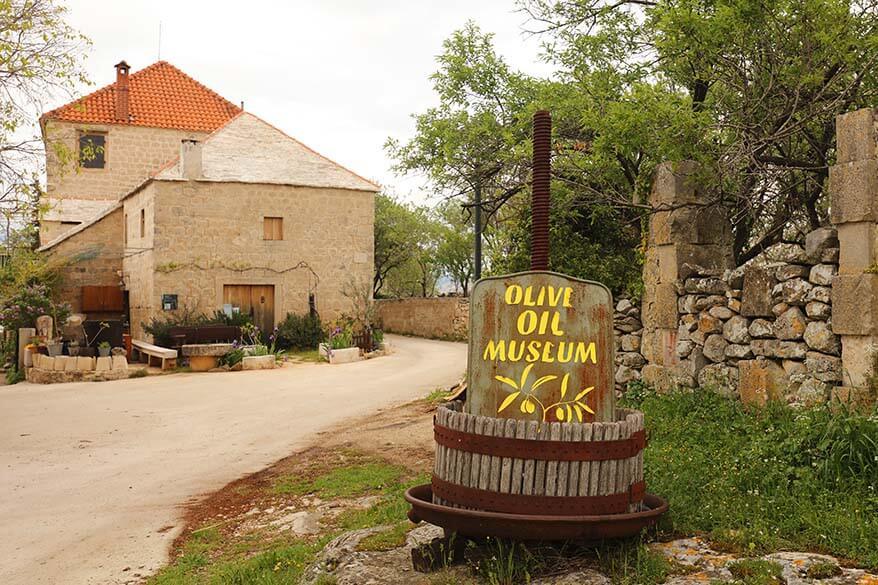
Dubrovnik in April
Dubrovnik is a place that you could visit year-round, but April is probably one of the best months for exploring the city . It’s not too busy yet and, although cruise ships already start to arrive in the area, we didn’t see any of them in the three days that we stayed in Dubrovnik.
Also, the weather in April is perfect for a city that is located by the sea (windy in winter) and is made of stone (hot in summer).
All the museums, churches, and monasteries were open in Dubrovnik in April. There were also plenty of restaurants, cafés, and bars which were nice and lively, but it was never an issue to find a free table for lunch or dinner.
The only activity that wasn’t yet available in Dubrovnik in April was kayaking. Also boats and tours running to the nearby towns and islands were scarce in Dubrovnik in April.
Dubrovnik accommodation, the most expensive of all the places we stayed in Croatia, was still very affordable in April. We paid about 165 EUR per night for a very big 3-bedroom apartment close to the Old Town.
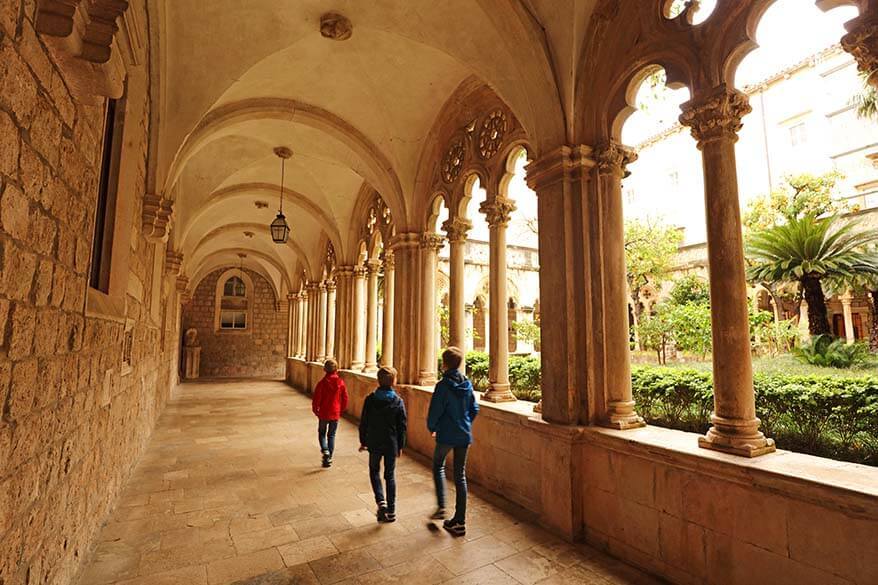
Split in April
Just like Dubrovnik, Split is ready for the season and every place we wanted to visit was open in April .
However, the day we left Split there were 4 (!) cruise ships in town, so Split can get really busy in April already. On the other hand, in the two days that we were there, the city wasn’t busy at all.
So it might be worth checking cruise ship schedules and plan to visit Split on a quieter day (the same goes for Dubrovnik).
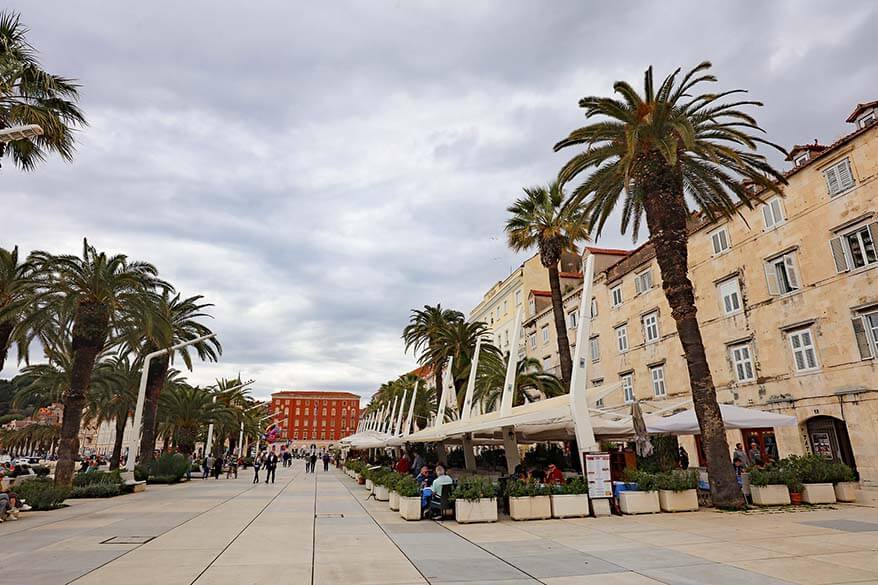
Hvar, Brač, Mljet, and other Croatian islands in April
We visited quite a few islands in two weeks in Croatia and they all had one thing in common – lots of places were still closed and the tourist season had clearly not started yet.
Hvar , the most popular of all the Croatian islands, felt the most ‘awake’ in April already. Quite some restaurants were open, but you could feel that the town was just waking up after winter.
Mljet island was completely deserted in April. We were glad to find a restaurant where we could have lunch.
In Brač , some places looked more lively than others, but just a few restaurants were open and some museums were closed. Despite the lower season, we still really enjoyed our visit to this beautiful island! Here you can read more about visiting Brač Island and all the amazing things you can do there.
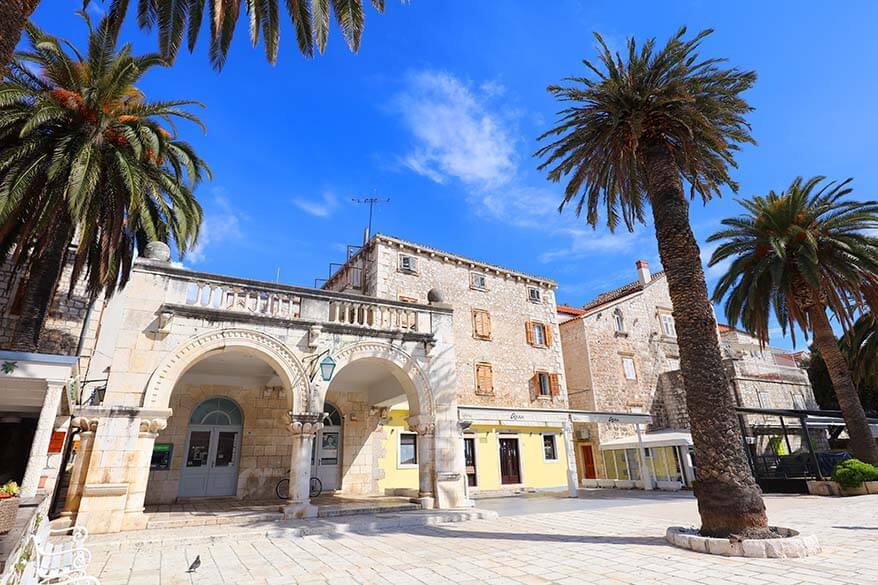
Plitvice Lakes NP in April
As already mentioned above, April is really not the best time to visit Plitvice Lakes National Park . It is located higher up in the mountains and you can still have snow there in April. It was snowing in Plitvice two days before we visited.
We had fantastic sunny weather in Plitvice but nature just wasn’t at its best yet.
Big crowds of school groups and tourists (yes, also in April) and the fact that part of the park was closed definitely didn’t help.

Krka National Park in April
Krka National Park was absolutely beautiful in April . Contrary to Plitvice, everything was green and the waterfalls were as beautiful as they ever get.
The only negative side was that there were lots of big groups of schoolkids, so it was quite busy at the main waterfall, Skradinski Buk.
As far as the number of tourists go, it wasn’t overly busy or crowded in Krka in April, but there were a lot of people. Much more than we expected at that time of the year… We had to wait a long time for the boat that brings you to the waterfalls. So on the way back, we decided to walk rather than take a boat.
We really enjoyed our visit to Krka, but it made us wonder how busy it gets there in summer…

Above you could read all the advantages and disadvantages of visiting Croatia in April and learn what to expect when traveling to Dubrovnik, Split, and other popular destinations in Croatia in April. However, what’s the conclusion…
Is it worth it to visit Croatia in April? Read on to find out what we think!
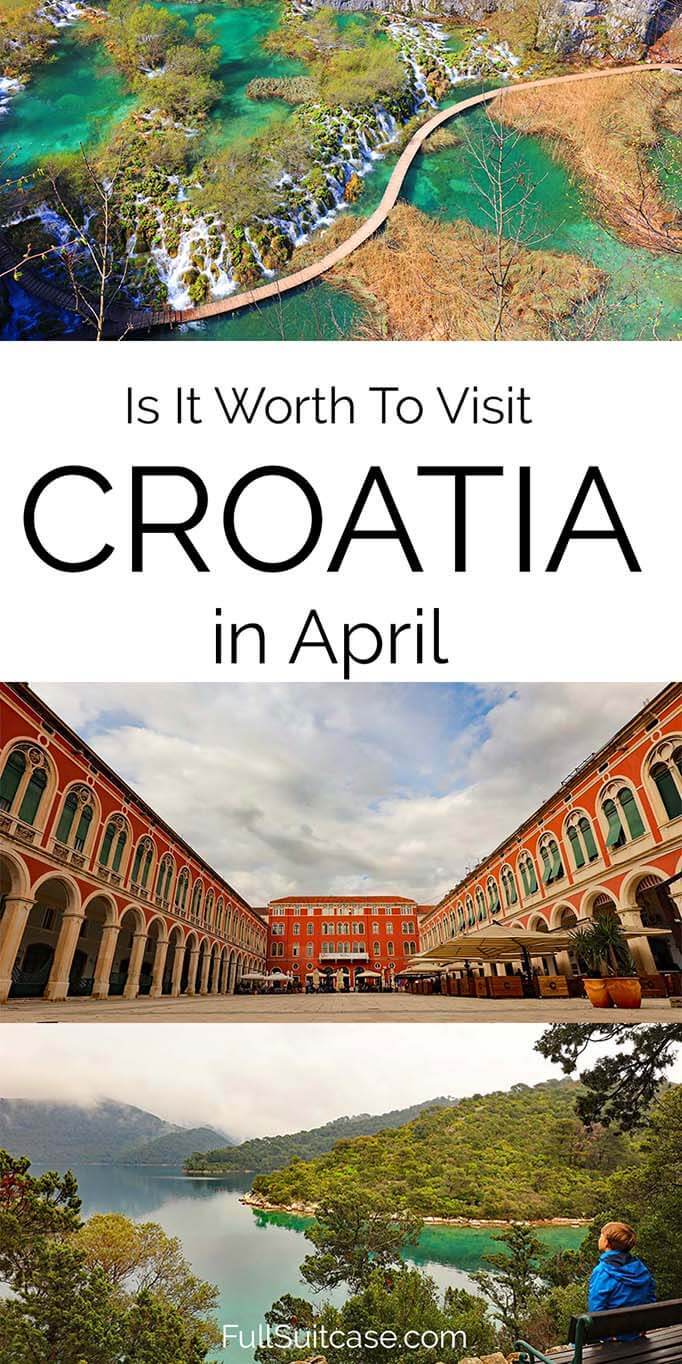
Croatia in April – conclusion
Observations in this article are based on our experience with visiting Croatia in April. The answer to whether it’s worth visiting Croatia in April is just as nuanced as the weather in Croatia in April.
Here’s what we think you should consider when planning to visit Croatia in spring:
If you are traveling to Croatia for sightseeing, are visiting towns, and want to avoid the crowds while having a chance for nice temperatures, then you’ll absolutely love Croatia in April. Croatian cities are among the best spring destinations in Europe .
If, however, you are looking to visit the islands and National Parks or hit the beach, it’s better to visit Croatia between mid-May and the end of September.
READ ALSO: Croatia itinerary – a very detailed guide that covers all the ‘musts’
If you found this post helpful, don’t forget to bookmark it and share it with your friends. Are you on Pinterest? Pin this image!
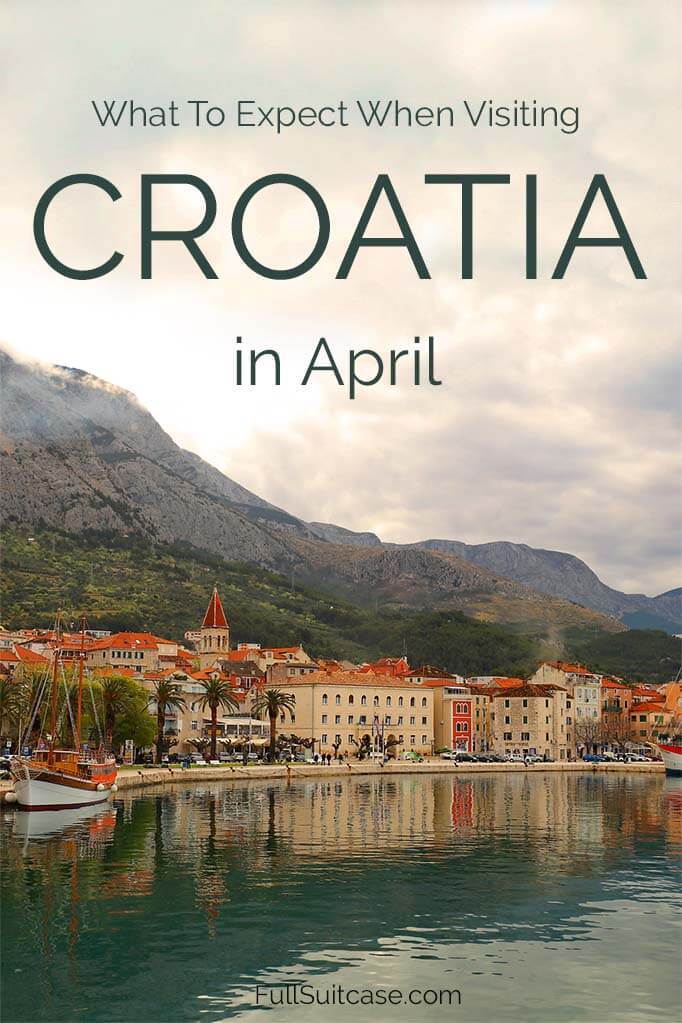
This site uses Akismet to reduce spam. Learn how your comment data is processed .
Wednesday 6th of March 2024
This was a very helpful article. Thank you so much. We will be there beginning April 20 so the packing list is underway !!
Thursday 7th of March 2024
Glad to help. Have a wonderful trip!
Friday 2nd of February 2024
Hi Jurga! Thanks for all your insight for visiting Crotia in April - I found it very informative! We are travelling from Brisbane, Australia to Europe for 2 months. We have booked a 7 day cruise of Croatia beginning on 20 April 2024. Last year we were on a Med cruise that stopped in Dubrovnik for 1 day in early September - it was very hot and very crowded so I'm really looking forward to less heat and fewer tourists!
Friday 8th of March 2024
See you on the cruise
@Debra, Hi. Debra, are you on the Azamara cruise? We are and this information helped so much. Thank you Jurga !!
Hi Debra, I hope it all works out as you expect. Just keep in mind that traveling by cruise (and definitely if it's a big ship), it may not be easy to avoid the crowds everywhere ;). Have a great trip!
Donna Montgomery
Saturday 20th of January 2024
Jurga, thank you for your highlights in Croatia. We have a flight booked and ready to see this beautiful place. We will be visiting in April 7th - 13th and staying in Dubrovnik, Split, Zadar and looking forward to checking out the national parks. Loved reading your blog and again thanks for all the tips definitely will be bringing long sleeves and a jacket just in case the weather comes upon us!
Monday 22nd of January 2024
Glad to help, Donna. Hopefully, you get fantastic weather! Have a great trip!
Sunday 14th of January 2024
Hi Jurga, I booked a flight to visit Split in early April and afterwards came across your blog. Now I'm even more glad that I booked around that time after reading about your experiences. Thank you for writing and happy more travels for you and your family!
Monday 15th of January 2024
Glad to help, Maggie. Have a great time in Croatia!
Tuesday 24th of October 2023
Hi Jurga thank you for a really interesting write up. Looking to go to Dubrovnik March/April next year. I've found flights but it is on the 31st so Easter Sunday. Just wondering about the restrictions that might impose travelling from airport to centre buses etc, shops and restaurants being open? Is everything likely to be closed on the Easter Monday too? I did wonder why I'd managed to find things quite cheap - family of five also! Thanks
Wednesday 25th of October 2023
Hi Nina, we travel around Easter all the time (also on Easter Sunday and Monday and - for that matter - on Christmas too) and we never experienced any notable issues. Obviously, many places will be closed, but there is always something open in the tourist areas and airports function as usual. If you want to visit a specific attraction, then it's best to check the opening hours on the official website of each place. Have a great trip.

The Purposely Lost
- Get In Touch
- FREE Travel Planner
- Shop My Favorites
- Story Archives
Find Lyndsay's Favorites

History Travel + Local Experiences
March 9, 2023 By Lyndsay
Best Time To Visit Croatia: Month To Month Breakdown (2024)
- 1.1 Best Time to Visit Croatia to Avoid Crowds
- 1.2 Best Time to Visit Croatia on a Budget
- 1.3 Best Time To Visit Croatia for the Beach
- 1.4 Best Time to Visit Croatia for Partying
- 1.5 Best Time to Visit Croatia for its National Parks
- 1.6 Best Time to Visit Croatia for its Festivals
- 1.7 Best Time To Visit Croatia For Sightseeing
- 2.1 January
- 2.2 February
- 2.9 September
- 2.10 October
- 2.11 November
- 2.12 December
- 3.1 Best Time to Visit Zagreb
- 3.2 Best Time to Visit Pula
- 3.3 Best Time to Visit Split
- 3.4 Best Time to Visit Dubrovnik
- 4 Weather in Croatia
- 5 Why visit Croatia?
- 6.1 What is the cheapest month to go to Croatia?
- 6.2 What is peak tourist time in Croatia?
- 6.3 What are Croatia’s hottest months?
- 7 Best Time To Visit Croatia: Wrap-Up
This post may contain affiliate links! I will receive a commission, at no extra cost to you, if you purchase something recommended here.
If you’re anything like me, you’re constantly seeking out your next adventure, craving the thrill of discovering new places and experiencing different cultures.
And let me tell you, Croatia is a country that should definitely be on your radar.
From the ancient cities of Split and Dubrovnik to the breathtaking Adriatic coastline, Croatia is a destination like no other.
With lively cities, stunning mountains, and secluded islands all in one country, it’s no surprise that Croatia has become a popular tourist destination.
But when is the best time to visit this Adriatic paradise?
As someone who loves to travel, I always want to make sure I’m getting the most out of my trips, and timing is a crucial factor in that.
So, I did my research and discovered that the best time to visit Croatia can depend on a few different factors, like weather, crowds, and events.
After spending several months exploring Croatia with a local family, here I’ll be sharing my insights and tips on when to visit Croatia based on my own experiences and those of my local friends.
Whether you’re looking for budget-friendly activities or want to experience some of Croatia’s exciting events and festivals, read on to find the best time to visit Croatia!

Grab your Travel Planner
Planning your next adventure can become overwhelming. Stay organized with this free, printable travel planner!
You can unsubscribe anytime. For more details, review our Privacy Policy.
You have successfully joined our subscriber list.
Overall Best Time To Visit Croatia
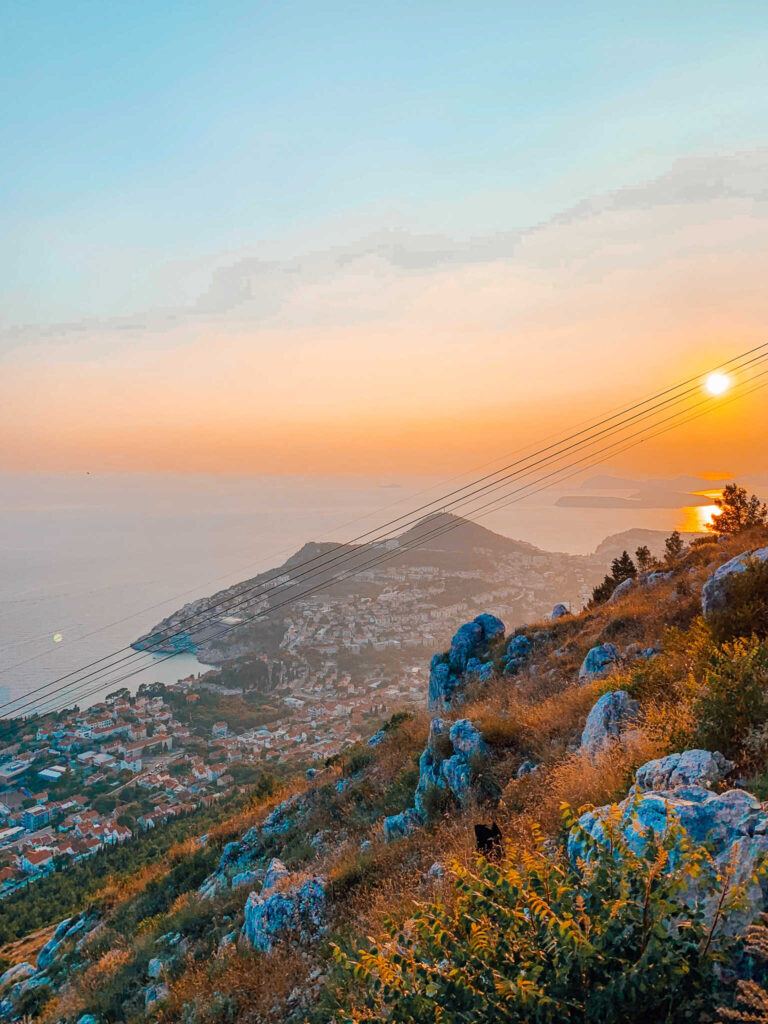
Croatia is a stunning destination; there’s no wrong time to visit this Mediterranean paradise.
However, if you’re looking for the best time to visit Croatia, the overall best time is during the shoulder seasons.
Between April and June or September and October, you’ll find the temperature is still warm enough to swim in the crystal-clear Adriatic Sea.
Still, you won’t be surrounded by the swarms of tourists that descend during summertime.
However, the best time to visit Croatia truly depends on your preferences.
Best Time to Visit Croatia to Avoid Crowds
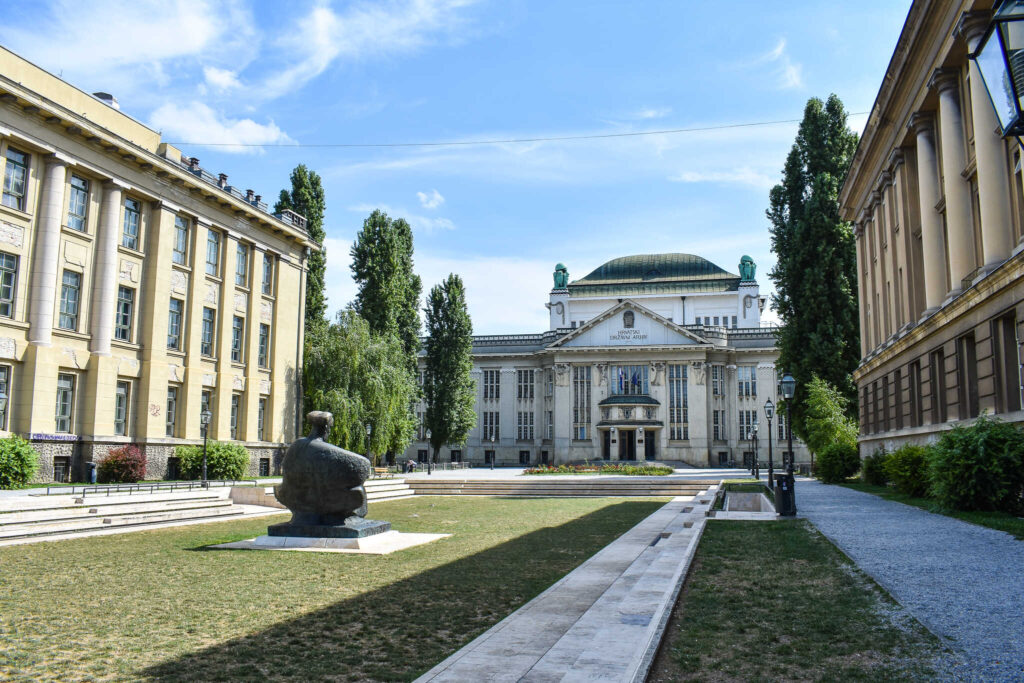
If you’re interested in experiencing Croatia without crowds, you must visit during the shoulder seasons.
The late spring and fall offer similar wonderful weather to the peak summer season.
Temperatures are still mild from April to May and September to November, and the tourist season has died down significantly.
This means you can experience Croatian culture more peacefully and authentically.
You’ll still be able to swim in the sea, hike through the national parks, and wander the historic cities–just with fewer tourists.
Best Time to Visit Croatia on a Budget
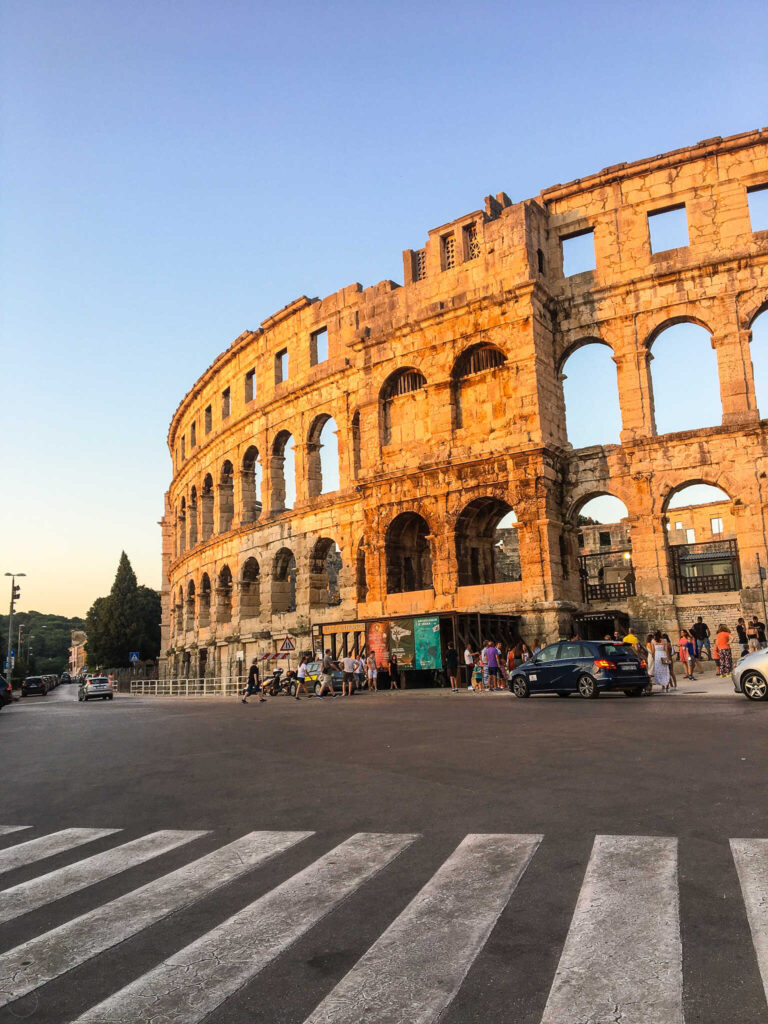
If you’re looking to explore Croatia on a budget, the best time to visit is in early spring or late fall.
From May through June and October through November, you’ll find lovely weather and fewer crowds, which is great if you’re looking to save on hotel costs and activities such as island hopping or exploring Plitvice Lakes National Park or Krka National Park.
Best Time To Visit Croatia for the Beach

If you’re all you want to do on your Croatian vacation is go swimming, snorkeling, sailing, or any other type of activity that involves the Adriatic Coast.
The summer months are your best bet.
From June to September, temperatures are warm, and the sky is almost always sunny, making it an excellent time to indulge in all Croatia’s water-based activities.
The peak season runs from July through August, with temperatures reaching their highest point.
Best Time to Visit Croatia for Partying

From mid-July to mid-August, some of Croatia’s coolest cities–Pag, Hvar, Brac, Dubrovnik, and Split–light up with travelers looking for an unforgettable party.
Specifically in Split, the Ultra Europe Festival is a must-attend event that lights up Split’s nightlife and runs for three days every July, offering world-class DJs and amazing vibes.
Best Time to Visit Croatia for its National Parks
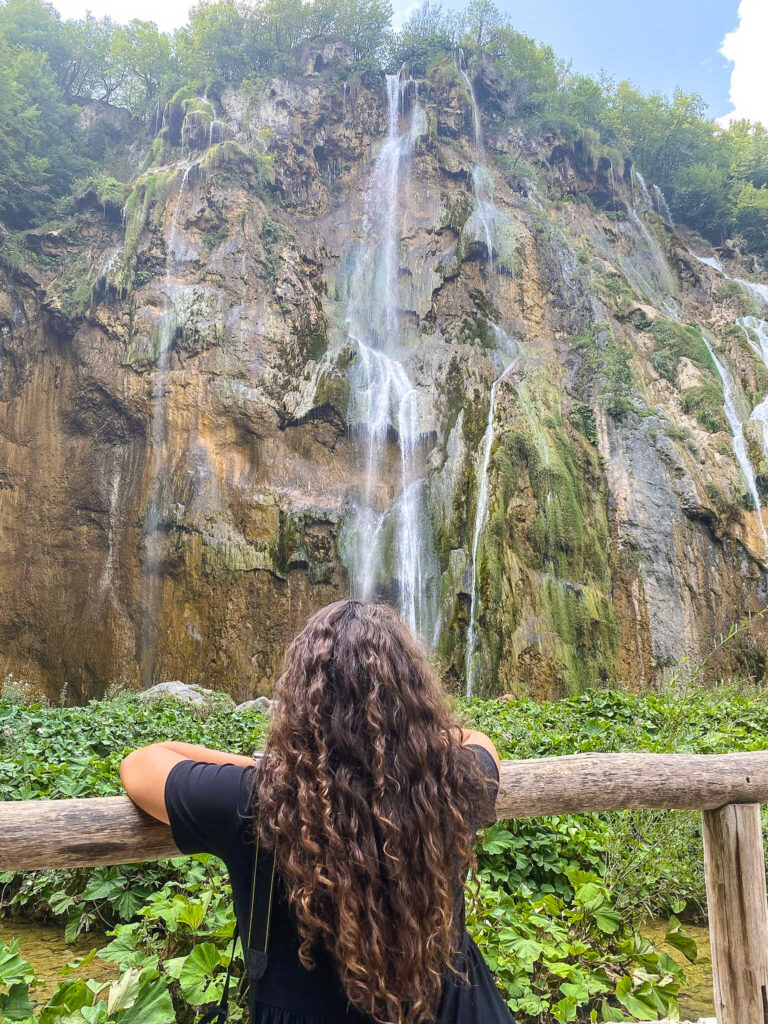
From the spectacular Plitvice Lakes National Park to Krka National Park and Mljet National Park, this stunning corner of Europe offers visitors a chance to explore some of the most breathtaking natural wonders.
When deciding the best time to visit Croatia’s national parks, springtime is definitely your best bet.
With temperatures hovering around a pleasant 70°F (21°C) and fewer crowds than during peak season, spring offers an ideal balance of sunshine and tranquility.
You’ll see nature in full bloom, and the waterfalls are at their fullest due to snow runoff–making it an unparalleled opportunity for visitors looking to really soak up nature’s beauty.
Best Time to Visit Croatia for its Festivals
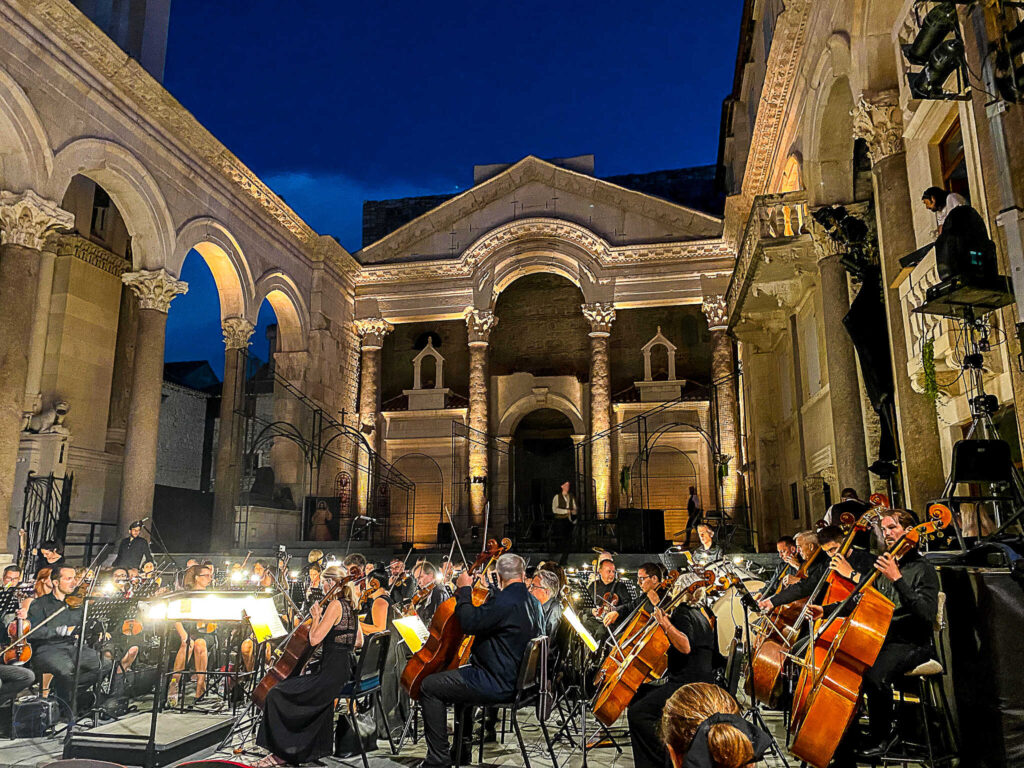
Croatia is a country full of exciting events throughout the year, but the top festival seasons are spring and summer.
During this time, you’ll enjoy some of Croatia’s most popular outdoor events and performances, like the Split Summer Festival, the Days of Diocletian, and the Festival of Flowers.
Best Time To Visit Croatia For Sightseeing

Summertime in Croatia is simply the best time to visit. Why?
As long as crowds aren’t an issue for you, peak tourist season from June through mid-August is perfect for exploring the country’s incredible attractions.
During this period, the weather is warm and sunny–you’ll want to bring sunscreen, sunglasses, and a hat, as temperatures can reach up to 31°C (87°F) in Split.
Best Time To Visit Croatia: Month To Month

Croatia is a beautiful destination, no matter the time of year.
However, for those looking for the perfect time to visit, some months may be better than others, depending on what you’re looking for.
Although Croatia is most famous as a summer destination, it also has some great winter activities!
Museum Night is an annual event where museums nationwide open free admission on the last Friday in January.
Croatia even has some excellent ski resorts in the Gorski Kotar mountains.
However, even though you’ll find some great deals, remember that not all restaurants and accommodations will be open during these months.
In February, the weather in Croatia is still relatively cold. Still, it’s not unbearably cold like in the more northern European countries.
Average temperatures range from highs of 11°C (52°F) to lows of 3°C (38°F) throughout the month.
Along with skiing, February brings several exciting festivals.
Early in the month, Dubrovnik has a massive celebration in honor of its patron saint, Saint Blaise.
Later, you can find Carnival celebrations in the cities of Rijeka, Zadar, and Dubrovnik.
As we finally leave winter weather for a hint of spring, March is an excellent choice if you like exploring countries without the typical crowds.
The winter crowds are gone, and the weather is mild and sunny, making it great for outdoor activities and sightseeing.
You can also score some excellent deals on hotel prices in March since it’s before the peak summer season rush.
April is not just a great month for the weather; it’s also an excellent month for sightseeing.
The weather is mild and enjoyable, with temperatures still averaging from 9°C (49°F) to 18°C (64°F).
Since it is less crowded, travelers can easily explore Croatia’s stunning beauty without feeling overwhelmed by too many people visiting at once.
And I can guarantee that you will be happy taking advantage of this spell of peacefulness and taking in all the sights without having to stand in long lines or wait on crowded tour buses.
In May, the crowds have yet to hit their peak, which means it’s the perfect time to visit Croatia.
With temperature highs around 22°C (72°F) and lows of 13°C (56°F), it’s a great time for outdoor activities.
And many prices are slashed; tourists benefit from early season discounts as restaurants and attractions come alive with activity throughout springtime in Croatia.
With most major attractions still open but many beaches yet to be crowded, visiting Croatia in May can give you an outstanding balance of exploration and relaxation at the same time.
Summertime in Croatia is the most magical season.
June brings sun-filled days and warm evenings, making it the perfect time of year to explore Croatia’s stunning beaches and ancient towns.
With average highs of 26°C (79°F), summer is ideal for outdoor adventures like hiking through national parks and touring coastal towns on a bike or kayak tour.
There is something special about visiting Croatia in July.
With warm temperatures and clear skies, it’s the perfect month for outdoor activities like swimming in the Adriatic Sea or exploring forest trails.
The days are long, so you can make the most of your stay by making early-morning or late-night trips.
Well, if you want to experience the country at its finest, then there’s no better time than August!
It’s the perfect time of year for swimming and hiking. The weather is typically sunny and warm, with temperatures reaching as high as 31°C (87°F) in Split.
September is the perfect time to explore Croatia’s stunning islands, from Hvar and Brac to Vis and Korcula.
The hot summer days are ending, but the weather remains mild, with plenty of sunshine.
This makes it an ideal time for swimming in crystal clear waters, relaxing on a beach, or exploring the many cultural attractions of these picturesque islands.
Come October, the temperature cools down, and the islands are in harvest season. Fewer tourists are around, so you can enjoy the last days of warm weather before the end of the year.
However, ferries start running on their reduced winter schedules in October. You might find many hotels and restaurants closed for the winter.
November allows travelers to explore Croatia’s beautiful cities and local culture without the price surge that summer tourists see.
Temperatures usually hover around 14°C (58°F) for the high and 8°C (46°F) for the low, making this ideal for sightseeing without feeling chilled.
Tis the season for Christmas markets, and Croatia has some beautiful ones! Most notably, the Zagreb Christmas Market is the most extensive in the country.
The inland, northern region of the country even offers snow-covered mountains ideal for winter activities such as skiing, snow-shoeing, and snowboarding, providing an extra layer of appeal during the festive season.
Best Time to Visit Croatia’s Top Cities

Croatia is a fantastic destination for any traveler with its stunning coastline, picturesque rivers, and lush rolling hills.
From the vibrant capital of Zagreb to the beautiful city of Split, plenty of places exist for you to explore.
But when is the best time to visit these cities?
Best Time to Visit Zagreb
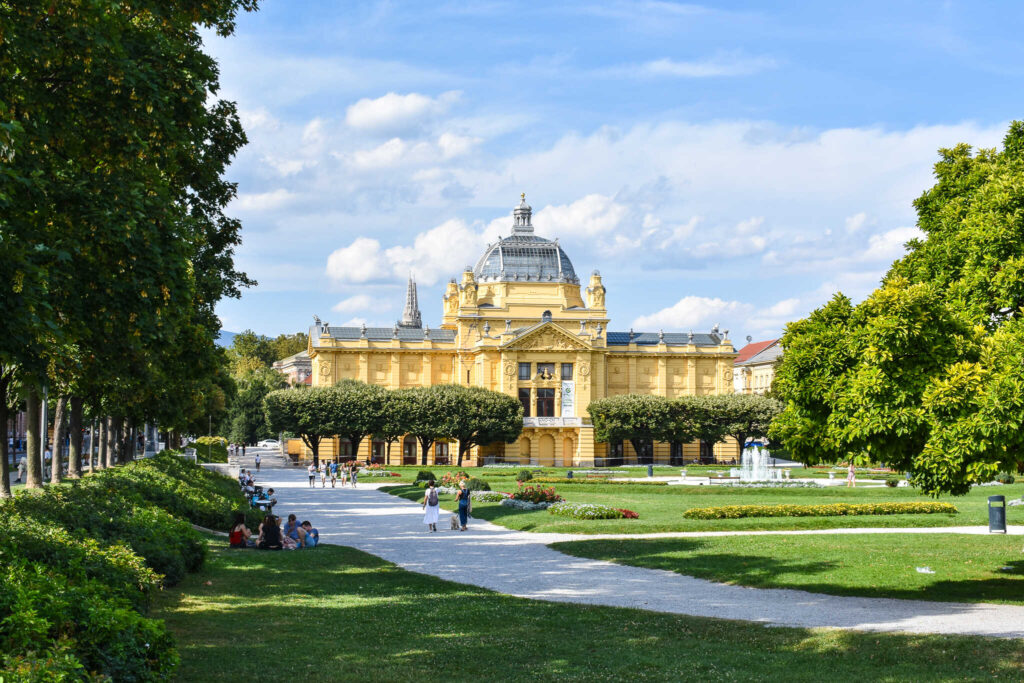
Zagreb, the capital city of Croatia, is a delightful mix of history, culture, and contemporary life.
The city’s charm is evident in its streets, parks, museums, and historical landmarks– you should definitely consider visiting !
While the city is beautiful year-round, the best time to visit Zagreb is from June to August.
During this period, the weather is warm, sunny, and perfect for outdoor activities such as picnics in the park, sightseeing, and concerts.
The Zagreb Botanical Gardens is all in bloom this season, perfect for a leisurely walk in the sun.
One of the coolest Croatian summer events here is The Grič Evenings, one of Zagreb’s oldest summer music festivals.
Visitors can also explore the museums and galleries with special summer exhibitions during this time, like the Museum of Broken Relationships, a quirky and unconventional museum showcasing mementos and stories of failed relationships.
Best Time to Visit Pula

Pula, a beautiful coastal city in Croatia, is a must-visit destination for those seeking history, nature, and Italian-style architecture.
The best time to visit Pula is during the summer months, from June to September.
The weather during these months is sunny and warm, with temperatures averaging around 26°C.
This makes it ideal for spending time on the city’s beautiful beaches , which offer a relaxing atmosphere and a variety of water activities such as swimming, snorkeling, and boating.
In addition to enjoying the beaches, there are so many other things to do in Pula throughout the summer, like exploring the city’s historical landmarks.
The most famous attraction is the Pula Arena, an ancient Roman amphitheater that dates back to the 1st century AD.
During the summer, you can enjoy concerts, film festivals, and historical reenactments in the Arena.
Another must-see attraction is the Temple of Augustus, a well-preserved Roman temple in the city center.
The temple houses an impressive collection of ancient artifacts and statues, allowing visitors to learn about Pula’s fascinating history.
And with ferries running regularly along the Adriatic coastline, it’s easy to take a day trip from Pula to places like Venice , Italy, or Rovinj or Poreč, Croatia.
You can check out my guide to t he best way to spend 3 days in Pula for more ideas!
Best Time to Visit Split
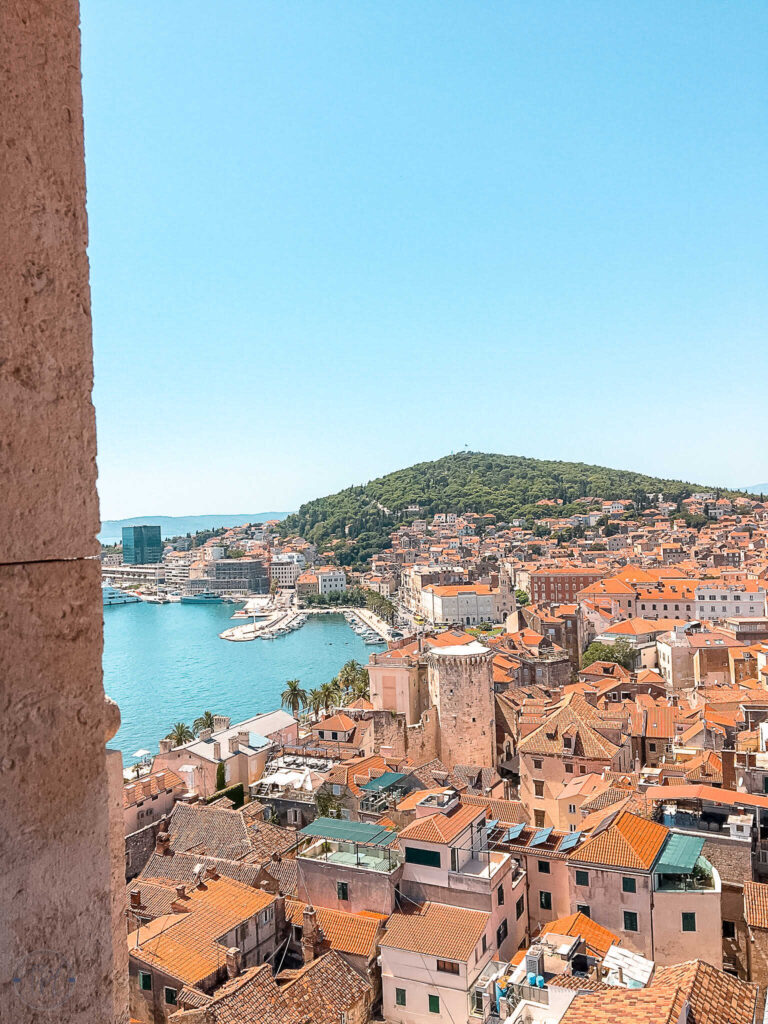
Split, a beautiful coastal city on Croatia’s Dalmatian coast, is rich in culture and history.
The best time to visit Split is during the summer, from late May to early September, when the weather is warm and sunny.
This season offers the perfect opportunity to enjoy the city’s stunning photo spots , crystal-clear waters, and numerous outdoor activities.
One of the must-do activities during the summer months is to visit the city’s famous Diocletian Palace .
The palace, built in the 4th century AD, is a UNESCO World Heritage site and offers a glimpse into the city’s rich history.
Several outdoor summer festivals, such as jazz and drama, are held within the palace.
Another one of the best things to do in Split during this period is to hike Marjan Forest Park, located on the hills above the city.
The park offers jogging and walking trails, offering amazing views of the city, making it a perfect spot for an evening stroll or an afternoon picnic.
Beach lovers can enjoy the numerous Split beaches with clear waters that line the coast. Bačvice Beach, the closest and most popular, is covered in fine sand and offers many water sports, like paddle boating.
You can find several local restaurants and cafes, which offer the perfect place to relax and enjoy the warmth of the summer months.
And it’s easy to take all the incredible day trips from Split to different cities nearby, like Šibenik , Trogir , and Omiš.
I have a whole guide on how to spend the perfect 3 days in Split –but you could easily stay for longer!
Best Time to Visit Dubrovnik
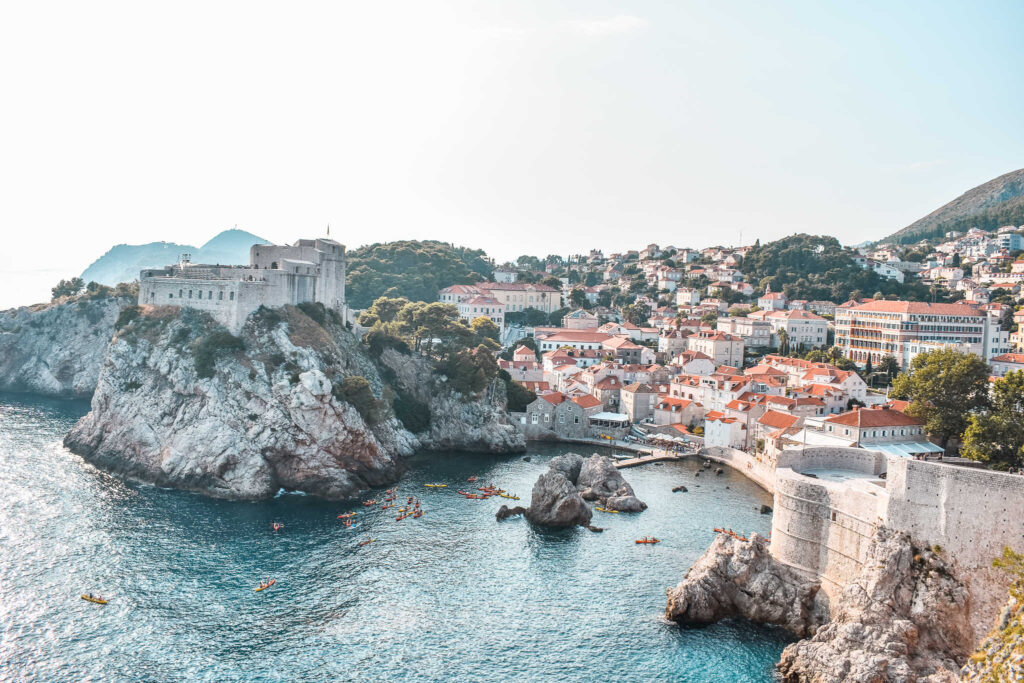
Dubrovnik is one of Croatia’s most beautiful cities and popular destinations– definitely worth visiting if you have a chance !
While Dubrovnik can be enjoyed year-round, the summer months of May to September are the best time to visit Dubrovnik because of the perfect weather that the season offers.
Visitors can enjoy the warm temperatures, sunshine, and long days during this period.
They can enjoy the beautiful beaches and a host of outdoor activities such as kayaking, snorkeling, and swimming.
Additionally, summer is a beautiful time to stroll around Dubrovnik’s historic city walls.
Built in the 13th century, the city walls stand to this day. Visitors can witness the stunning views of the sea and the historic city below while walking around the 1.94 kilometers (1.2 miles) loop.
The Dubrovnik Summer Festival is held from mid-July to late August. It offers concerts and performances within the city walls.
For food lovers, there is no better time to visit Dubrovnik than in the summer.
Dubrovnik offers an overwhelming choice of seafood specialties and fresh local fruit and vegetables.
Weather in Croatia
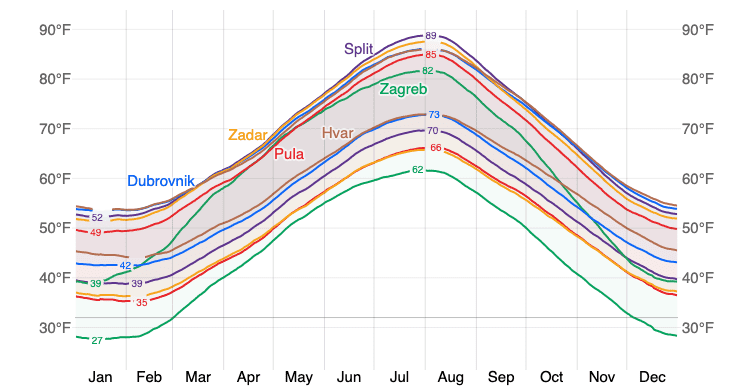
The weather in Croatia is generally pleasant, with mild temperatures throughout the year.
Its coastline has a Mediterranean climate, which means it’s hot and sunny throughout the summer and mild in the winter.
Inland, you’ll find a continental climate, which means it has hot summers and cold winters.
In summer, the average high temperature ranges from 26°C (79°F) in June to 29°C (84°F) in August, making it an ideal place to soak up some sun and explore the stunning coastline.
In winter, the average low temperature stays around 11°C (51°F) from December until February.
The hottest months are July and August, while the coldest months are December and January.
Rainfall is generally higher during autumn, especially in October and November. Pack a raincoat if you visit during this period!
If you’re looking for something a little more extreme, winter can also be an excellent time for skiing or snowboarding in one of Croatia’s many ski resorts.
Why visit Croatia?
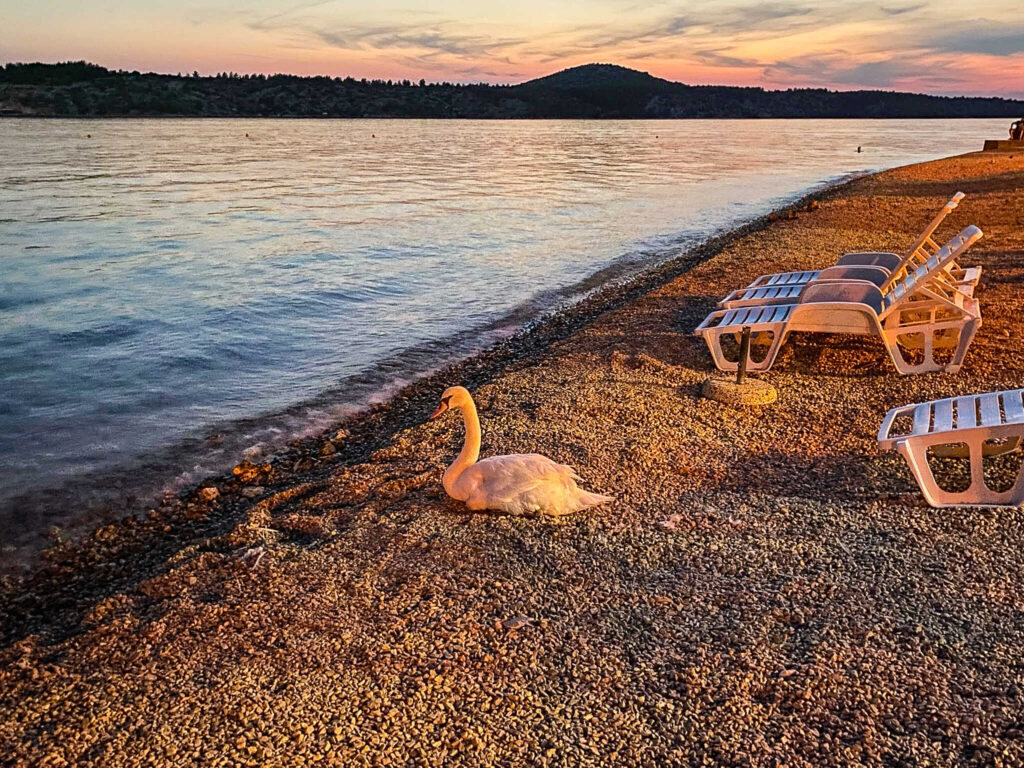
Whether you’re looking for a romantic getaway or an adventure-filled holiday, you’ll find it in Croatia!
The country spans the beautiful Adriatic coast, with stunning beaches and bustling cities. At the same time, the interior is home to lush national parks and majestic mountains.
There are many cultural events throughout the year, including delicious cuisine and excellent wines.
From the moment I stepped foot in Croatia for the first time, I was absolutely blown away by the sheer natural beauty that surrounded me completely.
The freshest seafood, taken out of the sea that morning and on your plate by lunchtime.
The clearest, cleanest blue water I’ve ever swam in, and I had to watch out for sea urchins to ensure I didn’t prick my feet.
And every night, the sky becomes a brilliant, brand-new painting as the sun sets and washes the whole world with color.
Visiting Croatia: FAQs
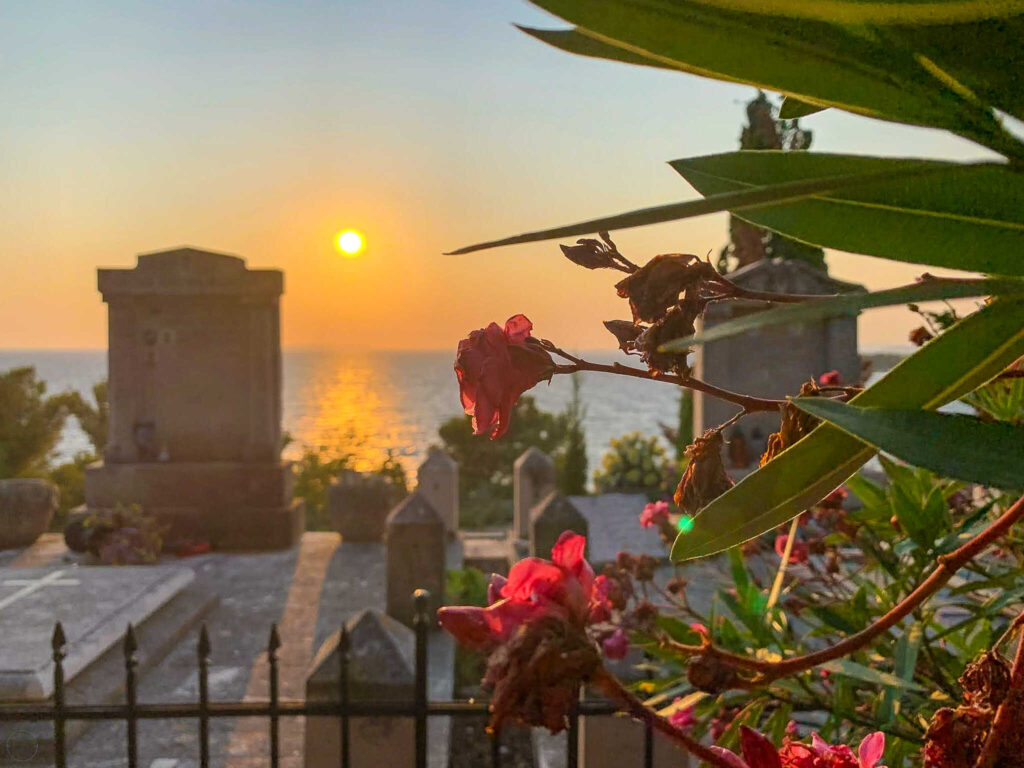
What is the cheapest month to go to Croatia?
Visiting Croatia on a budget is definitely possible! The cheapest month to go to Croatia is usually April or October.
April has the advantage of being one of the shoulder seasons, meaning you won’t have to deal with the higher prices and overcrowding that come with peak season.
You’ll still enjoy a surplus of sunshine and warm temperatures during this time, making it perfect for exploring all Croatia has to offer.
In October, you can also benefit from lower prices and fewer crowds.
Plus, you’ll also experience some cultural festivals during this time, like Istrian Truffle Days held in towns all over the Istria region and the Chestnut Festival in the city of Lovran.
It’s worth noting that this is also one of the rainiest months in Croatia, so make sure you pack a raincoat if you’re visiting at this time!
What is peak tourist time in Croatia?
Peak tourist time in Croatia is generally during the summer months of July and August.
It’s hot and sunny most days, and the restaurants that are closed for the winter months are open and filled with guests.
Temperatures are at their highest, which is great when you want to spend endless days on the beach.
Plus, if you’re a fan of music festivals, then you will want to experience Ultra Europe in Split!
However, this is also when Croatia sees its largest influx of tourists.
Due to demand, prices tend to be higher during these months, so be sure to research your accommodation beforehand to get the best deals.
What are Croatia’s hottest months?
Croatia’s hottest months are typically July and August when temperatures reach an average of 29°C (84°F).
During these months, there’s tons of sunshine, making it the perfect time to explore Croatia’s stunning beaches along the Adriatic Coast.
However, it’s important to note that this is also peak tourist season, so if you’re looking for a holiday experience where you have the beaches and historical landmarks to yourself, then visiting outside of the summer months may be preferable.
Best Time To Visit Croatia: Wrap-Up
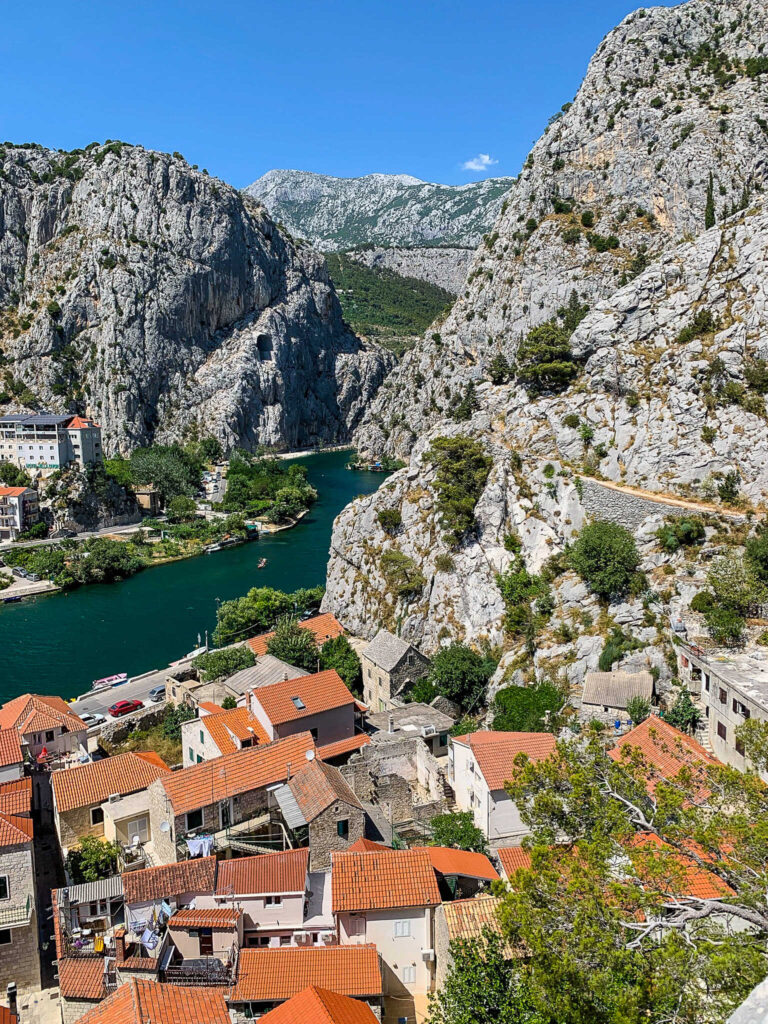
It’s hard to pick the “best” time to visit Croatia because each season offers something unique and beautiful.
However, while the winter brings fewer crowds, holiday markets, and cozy traditions, the summertime offers long days, beautiful beaches, and warm temperatures to this coastline country.
If you want to explore the Croatian islands, beaches, and cities, you must come in the summer.
Although each traveler will have their own preferences and priorities when visiting Croatia, one thing is certain–Croatia’s natural beauty and varied history make it a must-see destination.
No matter when you decide to visit, Croatia will undoubtedly leave a lasting impression on you.
From stunning national parks to vibrant cities and towns, this beautiful country has something you won’t want to miss.
So, whether you’re planning a summer beach vacation or a winter getaway, don’t hesitate to explore all Croatia offers!
- The Best Beaches in Šibenik, Croatia
- The Best Beaches in Trogir, Croatia
- How to Travel in Italy Without a Car: The Ultimate Guide
- Extraordinary Non-Touristy Places to Visit in Italy
- Outstanding Wine & Prosecco Tours from Venice, Italy
- Your Guide to 2 Days in Salzburg, Austria
- Amazing Gifts for History Buffs They’re Sure to Love
- Best Travel Necessities: A Women’s Guide to Vacation Essentials
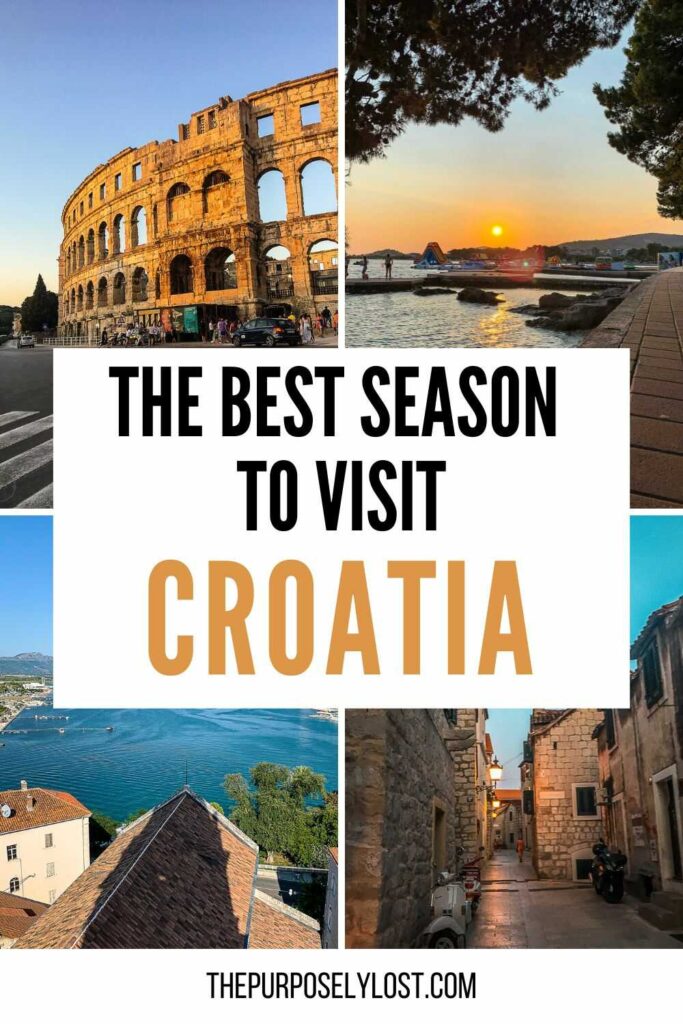
You've successfully joined our subscriber list.
You’ll Also Love

15+ Crazy Things to do in Split, Croatia at Night

Become Purposely Lost
I'm Lyndsay! Thank you so much for joining me here at The Purposely Lost.
Latest on Instagram
- Affiliate Disclaimer
- Cookie Policy
- Privacy Policy
- Terms and Conditions
- Accessibility Statement
- United States
- Travel Tips
Copyright © 2024 The Purposely Lost · Theme by 17th Avenue
Copyright © 2024 · Mia On Genesis Framework · WordPress · Log in
Privacy Overview
Best Time to Visit Croatia: For Good Weather and More!
Adventurous Kate contains affiliate links. If you make a purchase through these links, I will earn a commission at no extra cost to you. Thanks!
When’s the best time to visit Croatia? You deserve a fantastic trip to Croatia — and that includes timing your trip perfectly! Croatia is one of the most beautiful bucket list destinations in all of Europe.
Croatia is one of my all-time favorite countries, and I’ve spent months traveling the country extensively. Not every time of year in Croatia is the same, and you’ll have a lot more fun in September than January.
Most people travel to Croatia in the summer months — and for good reason. Croatia has arguably the most beautiful coastline on the planet, with roads curving around mountains, tiny white stone villages topped with orange roofs, and hidden pebble beaches leading to bright teal water. Summer in Croatia is like turning the volume up to 11.
But summer isn’t the only option in Croatia. For certain kinds of travelers, the shoulder season might be even better for you than summer.
You can have fun in Croatia year-round! Even in January! But a lot of what makes Croatia wonderful — swimming in the Adriatic, hiking through national parks, dancing at music festivals — is very seasonally dependent.
Read on for the best time of year to visit Croatia!
Table of Contents
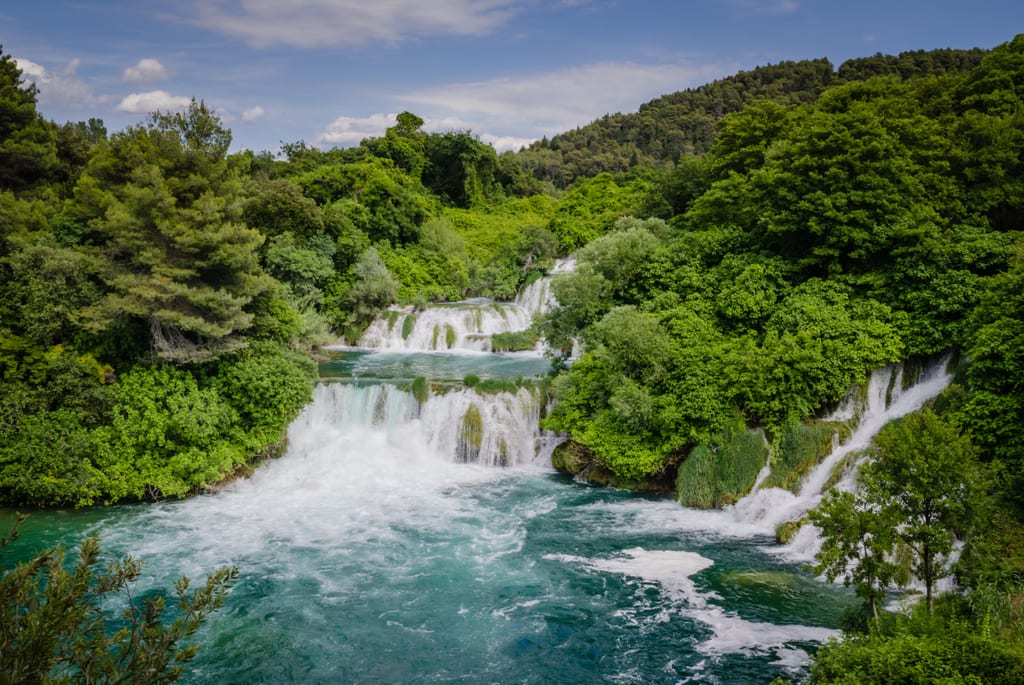
Best Time to Visit Croatia
Most travelers come to Croatia during the summer months to enjoy the beaches and islands. And while peak summer can be a bit too busy, you can enjoy yourself in the shoulder season as well.
Most people visit Croatia during the summer months , from June through September, so they can enjoy the beaches, islands, and warm days with very little rain.
In my opinion, September is the best month to visit Croatia , ideally late September. You get summer weather, fewer crowds, and the water is much warmer than in June.
You can visit Croatia year-round with kids . The summer months are your best options for a beach holiday, but spring and fall are excellent times for exploring Croatia’s culture.
Dubrovnik is best in June and September , when the weather is warm and summer-like but there are far fewer large cruise ships and tourists.
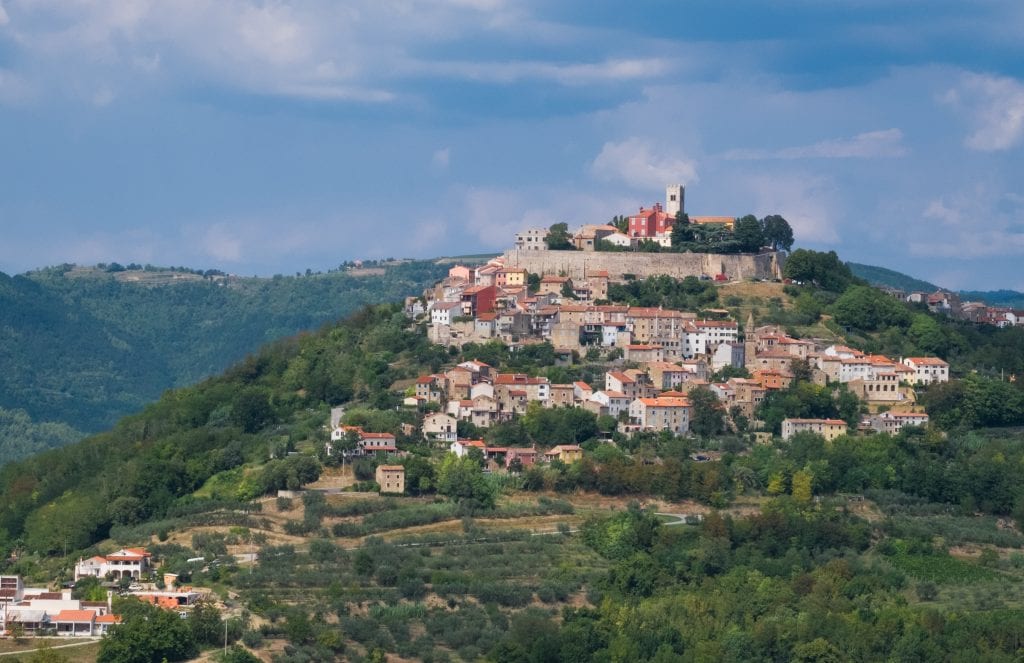
Croatia Weather
Croatia has an Adriatic climate, generally speaking, which is not surprisingly quite like a Mediterranean climate. Even so, the country doesn’t have one universal climate. There is a lot of variation within the country when it comes to weather.
Most Croatia travelers come to visit the Dalmatian coast in southern Croatia — including places like Dubrovnik, Hvar , and Split. This is the warmest and sunniest part of Croatia with a long summer season that runs from late May to early October.
Istria, the Italian-flavored peninsula in Croatia’s northwest, isn’t quite as sunny or as warm as Dalmatia, but you still have hot summers with slightly cooler springs and falls and a shorter summer season overall.
Zagreb is further inland and it can get both quite hot and quite cold here — and it snows most winters. Shoulder season is when Zagreb is at its best.
Slavonia, the off-the-beaten-path region in the far northeast, has more extreme temperatures than the rest of the country. Expect stiflingly hot summers and bitterly cold winters.
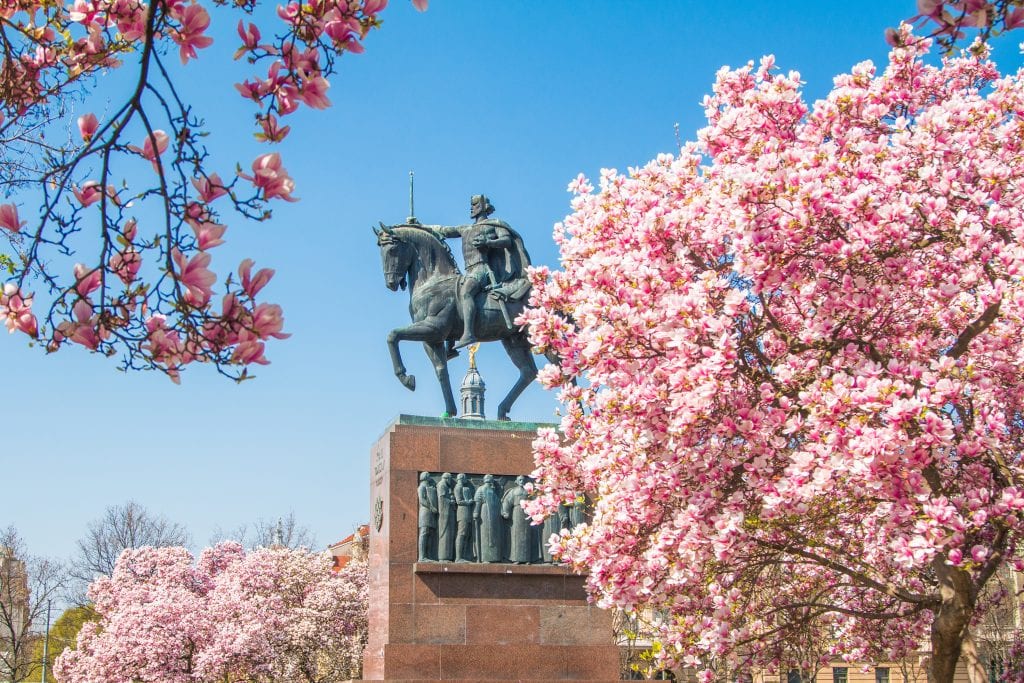
Spring in Croatia
Spring is when Croatia bursts into bloom. The weather starts to warm in early March in Dalmatia and later March in regions further north like Istria and Zagreb. Flowers dot the landscape in April and continue into May, making it a beautiful time to visit Croatia.
Croatia is a deeply religious country and Easter is the major holiday of the spring. Many Croatians take Easter week as a mini-holiday to enjoy the coast before the tourists arrive. Spring is also a popular time for cultural festivals.
Spring can be a particularly nice to visit the Plitvice Lakes and Krka National Park, as the waterfalls are extra flush with snowmelt.
Spring in Croatia lasts until late May. By that point, Jadrolinija (Croatia’s ferry line) starts up its summer schedule and people will be sunning on the beach in Dalmatia. The heat slowly creeps northward.
Overall, spring can be a lovely time to experience a beautiful and warm Croatia without the tourist crowds — but I would recommend visiting in April or May rather than March.
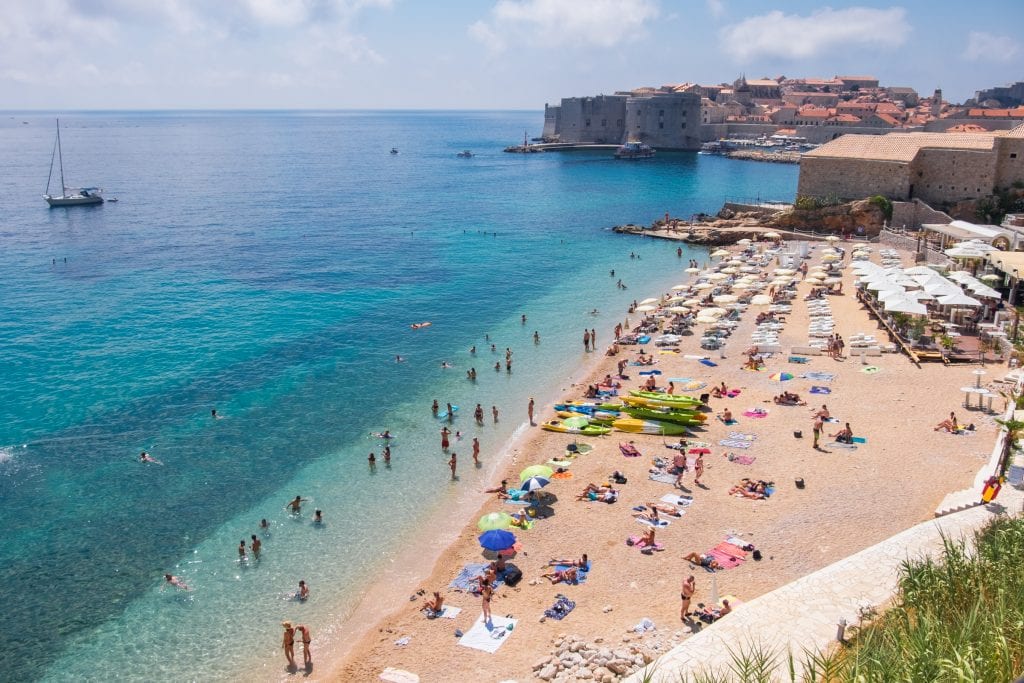
Summer in Croatia
Summer in Croatia is a sizzling time of year. This is when the Adriatic Coast comes to life! Summer is what most travelers have in mind when they visit Croatia, and summer is when Croatia receives most of its tourists from abroad.
Summer is a wonderful time to visit the Dalmatian Coast because it’s sunny and hot with very little precipitation. However, there tends to be one mega-thunderstorm once every summer, so know that it could happen during your visit! (I was in Pelješac for the 2020 storm. It rained so hard it felt like the world was ending. But a few hours later it was over!)
Summer is also when cruise ships are at their peak — particularly in late June, July, and August. Dubrovnik’s old city in particular is crammed with cruise ship tourists during the day, and for this reason I recommend avoiding the old city during the heat of summer days and sticking to visiting at dusk and at night.
Summer can also be quite hot in inland parts of Croatia, like Zagreb and the Slavonia region. Summer also brings tourists to the coastal areas of Istria, which don’t have quite as long a season as those in Dalmatia, so tourism is a bit more condensed here.
Summer brings you the Croatia of your dreams — but because it’s so busy, it’s a good idea to plan your trip ahead of time, especially accommodation, which can book out quickly. I find that early June and late September are better times to enjoy the best of Croatia’s summer while avoiding the worst of the crowds.
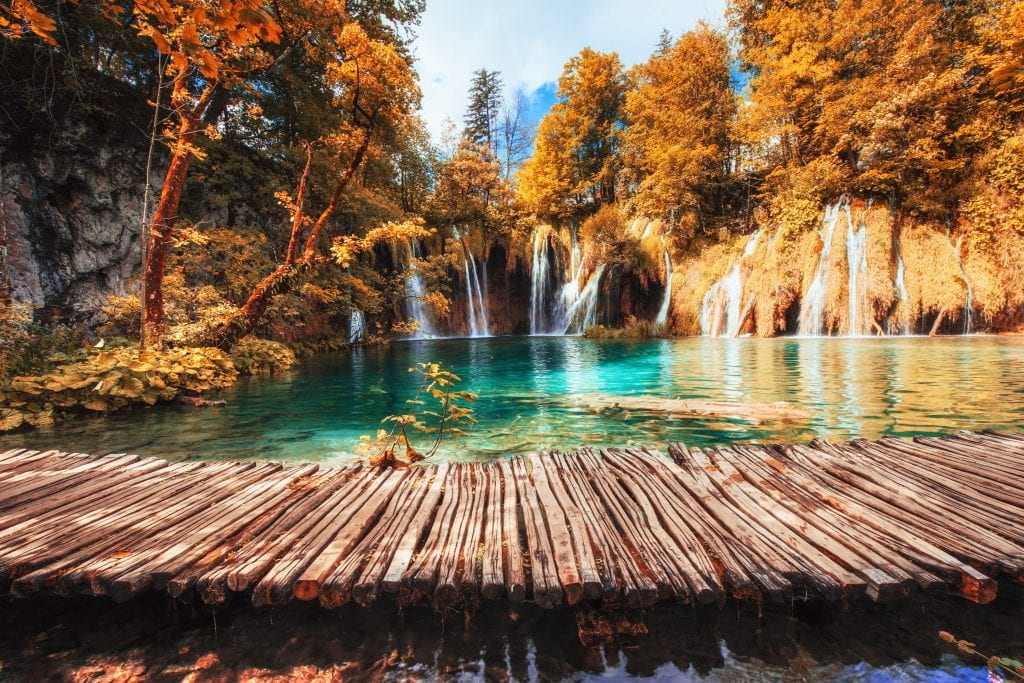
Fall in Croatia
Fall in Croatia — or autumn in Croatia — varies quite a bit based on where you are. In Dubrovnik, you’re enjoying summer weather into October; in Zagreb, Motovun, and Slavonia, October is when things start to get chilly. Either way, it can be a welcome relief from the summer heat and tourist crowds.
When does fall begin in Croatia? Usually in October, as September is still very much the summer months. The further north you go, the earlier the fall begins.
Croatia does get some fall foliage, and this can be a beautiful time to photograph the Plitvice Lakes and other national parks.
Fall is especially a wonderful time to visit Istria, where you can enjoy the bounty of the harvest, truffle hunting, and newly released wines.
Fall can also be a rainy time in Croatia and the rainiest months of the year are November and December. Make sure you bring your umbrella and have a plan for when the sun isn’t shining!
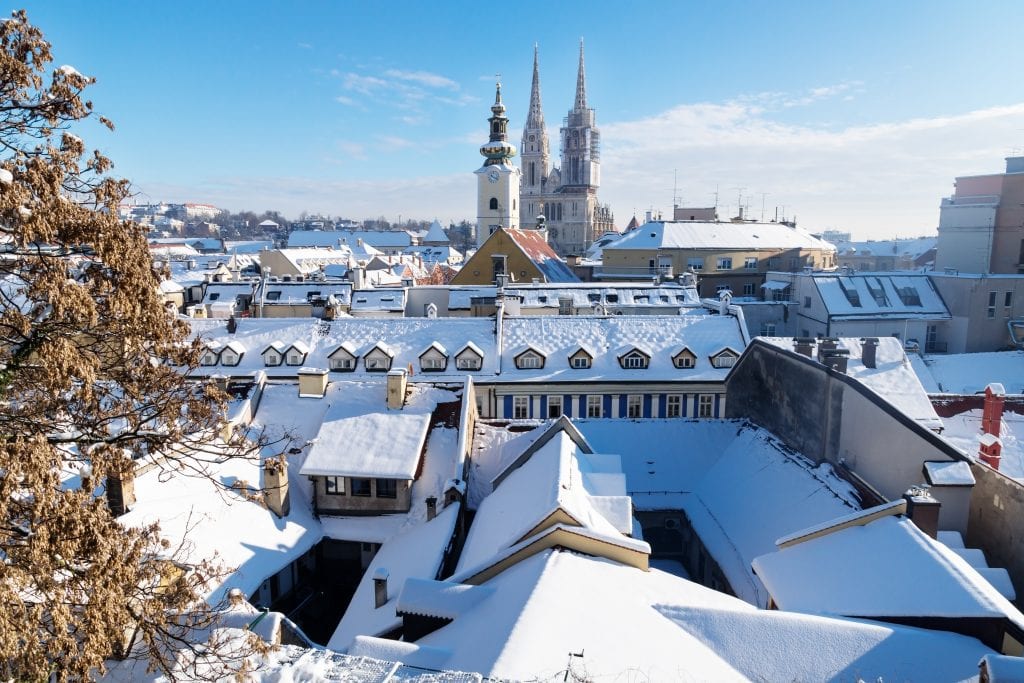
Winter in Croatia
From December through February, Croatia is engulfed in the winter months. In Zagreb, Slavonia, and mountainous parts of Croatia, you can see snow. In warmer parts of the country, like Dalmatia, you’ll have chilly temperatures and rain. It snows in Dubrovnik once in a blue moon.
Is winter a good time to visit Croatia? Generally, I don’t recommend it.
The exception would be if you’re spending time exploring Zagreb, which of course is a year-round city; visiting the Plitvice Lakes to photograph them in the snow; or perhaps spending time in a city like Zadar, which is very quiet but not shut down.
That said, there are a few big winter events in Croatia that deserves mention: Carnival, or Maškare , which takes place mostly in February, and Advent in Zagreb , Zagreb’s Christmas market celebration that lasts the full month of December. Both of these events are well worth your time.
Just understand that visiting Croatia in the winter is a very different experience.
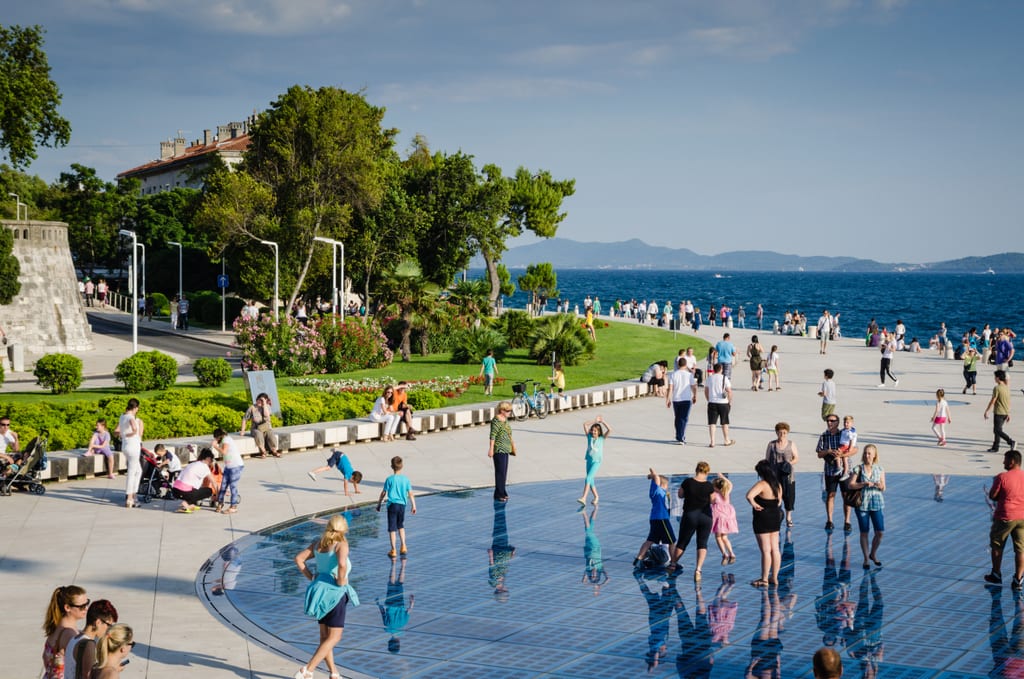
High Season and Low Season in Croatia
High season in Croatia is during the summer months, particularly in Dubrovnik and along the Dalmatian coast, from June through September. This is when prices and temperatures are at their highest and crowds are at their worst.
The absolute peak of high season in Croatia is during the months of July and August, and these months are when most of the cruise ships are docked in ports. While June and September are still technically considered high season, there is a world of difference in crowd levels in places like Split and Dubrovnik.
Shoulder season in Croatia is April to May and late September to October. During this time you have decent prices, few crowds, and zero cruise ships. Most resorts along the Dalmatian coast operate from May through October.
If you’re looking for more of a cultural trip and less of a lie-on-the-beach trip, this can be an excellent time to travel in Croatia. Shoulder season is also my favorite time to travel in Zagreb, Istria, and Slavonia.
Low season in Croatia is during the cold months of the year, from November through March. There are deals to be had during these months, particularly in the larger cities, but much of the Dalmatian coast and more resort-y towns and islands mostly shut down.
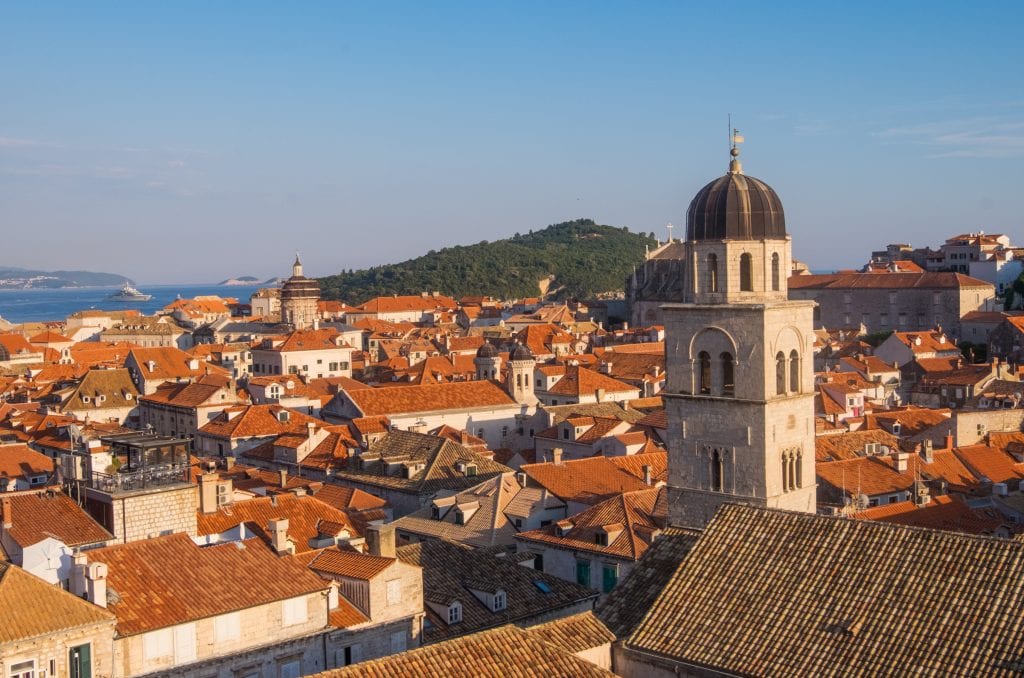
Best Time to Visit Dubrovnik, Zagreb, Rovinj, and More
Croatia may be a small country, but the weather can vary quite a bit. One of my favorite experiences in Croatia is driving from the Zagreb area to Split and the Dalmatian coast, because you drive through mountains under a cloudy sky, go through an enormous tunnel, and when you come out, it’s bright and sunny, like you’ve entered a new country!
That’s how different Dalmatia is — and that’s how different Croatia’s climates can be.
Best Time to Visit Dubrovnik
Dubrovnik is one destination in Croatia where I recommend timing your trip with precision, and the best time to visit Dubrovnik is during September or October. During these months you’ll enjoy warm weather and beach time, and the water will be warm enough for swimming, but you’ll avoid the worst of the cruise ship crowds that arrive in July and August.
Late May and June is another nice time to visit Dubrovnik, but the water won’t be as warm for swimming. If you’re not a swimmer, or you don’t mind cold water, go ahead! You might actually enjoy that more than September.
Dubrovnik Summer Festival takes place during July and August and features concerts, performances, and events in and around the city.
Good Food Festival , either in late September or early October, is a fabulous food celebration in Dubrovnik.
Winter in Dubrovnik is extremely local and very quiet. Locals celebrate the Feast of St. Blaise, Dubrovnik’s patron saint, on February 3 with performances, costumes, and dancing.
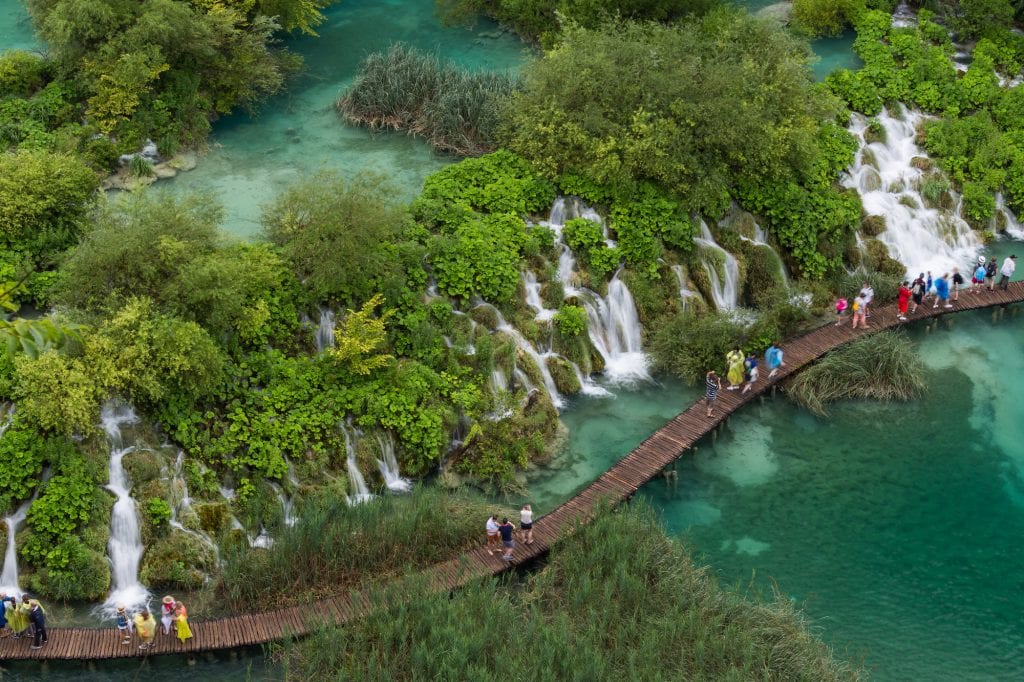
Best Time to Visit Plitvice Lakes
The Plitvice Lakes with their iconic waterfalls are one of the most stunning natural sights in all of Croatia. And because of that, they are a joy to photograph year-round!
In the spring you get extra-flush waterfalls due to snowmelt, plus flowers and budding trees. In the summer you get full, lush greenery. In the fall you get changing colors. And if you time your visit right in the winter, you can experience snow and frozen waterfalls — images that are coveted among many nature photographers.
No matter what time of year you visit, be sure to dress for the weather. The Plitvice Lakes aren’t outfitted with many indoor stations to take a break from the outdoors.
Like the rest of Croatia, July and August are the busiest months at the Plitvice Lakes and host lots of cruise ship shore excursions. It can get very crowded during this time, particularly at the Lower Lakes, so if you’re looking to avoid the worst of the crowds, I would recommend avoiding these two months.
And if you enjoy the Plitvice Lakes, don’t miss Krka National Park !
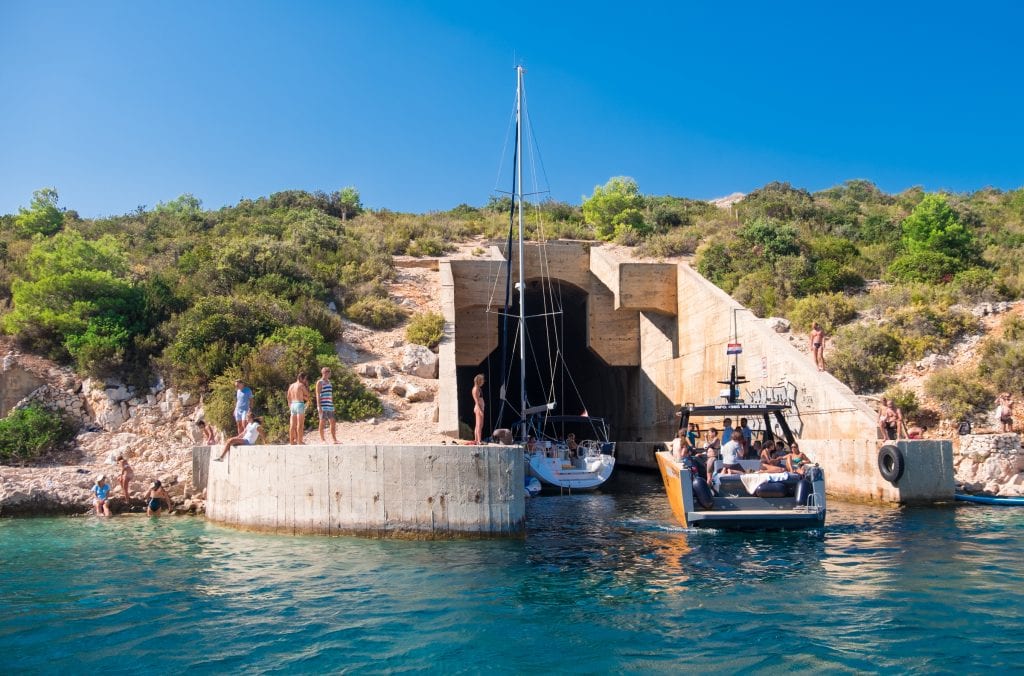
Best Time to Visit the Dalmatian Coast
The Dalmatian coast is blessed with a long and languorous high season. Summer is when this part of Croatia is at its best. You can enjoy summer-like temperatures from late May through early October (though the water is much warmer in September than June).
Whether you’re visiting the relaxing city of Zadar or the endlessly interesting island of Korčula , enjoying the forests and saltwater lakes of Mljet or hiding away in remote Vis, there is plenty to enjoy along the Dalmatian Coast in the summer.
However, I recommend avoiding July and August if possible. This is when tourism is at its peak along the Dalmatian Coast, and some destinations like Dubrovnik are overrun with cruise ship tourists.
My personal favorite month to visit the Dalmatian coast is September.
Shoulder season can be a nice time to visit the Dalmatian coast, but know that some places are going to be closed. I recommend sticking to April, May, and October — months when places are a bit more likely to be open.
In the winter, much of the Dalmatian coast shuts down. Accommodation closes, restaurants close, and ferries run less often. Honestly, I don’t see much of a reason to visit the Dalmatian coast during this time of year.
Split has a lot of festivals. April brings Gast Fair , Croatia’s largest culinary festival. May brings the Feast of St. Dominius, Split’s patron saint, and lots of celebrations leading up to it. Mediterranean Film Festival Split takes place each July. Split Summer Festival is similar to Dubrovnik Summer Festival and brings all kinds of concerts and performances in July and August.
In Ston on the Pelješac peninsula, the Festival of Oysters takes place on March 18, St. Joseph’s Day, and features lots of delicious oysters and wine. The mainland town of Šibenik celebrates Supertoon in July, a festival of animation. See below for more on music festivals.
The island of Korčula celebrates the Sword Dance Festival in June.
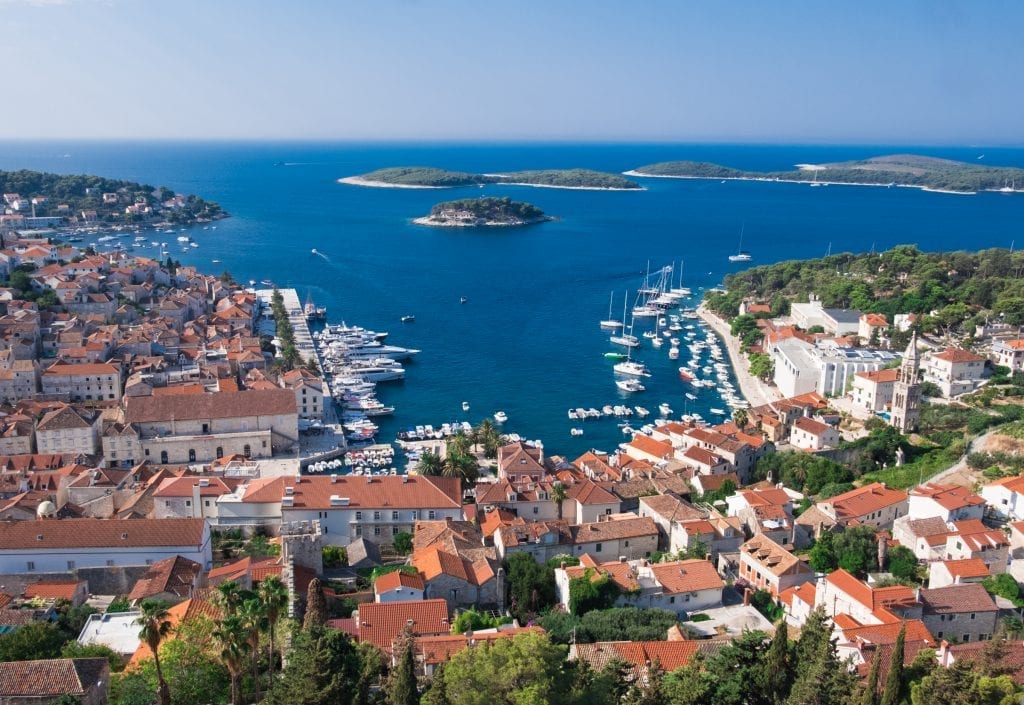
Best Time to Visit Hvar
Being on the Dalmatian Coast, Hvar is blessed with blissful summers — and locals like to say it’s the sunniest island in Europe. Hvar is very much a summer destination, but here summer can extend from late May into early October.
If all you’re looking for is sunshine and warmth, anytime between late May and early October is lovely.
If you’re looking to see Hvar’s famous lavender fields, aim for late June or early July. Lavender has a short season in Hvar.
But if you’re looking to visit Hvar specifically for the party scene, as many travelers do, the season is at its peak in July and August. You’ll pay in terms of crowds and prices, but that’s why you’re here, isn’t it? Being a party person in Hvar comes with a price tag.
In terms of festivals, Hvar celebrates the Feast of St. Prosper, its patron saint, on May 10 with traditional celebrations and a feast. Hvar Summer Festival puts on concerts, events, and performances throughout July and August.
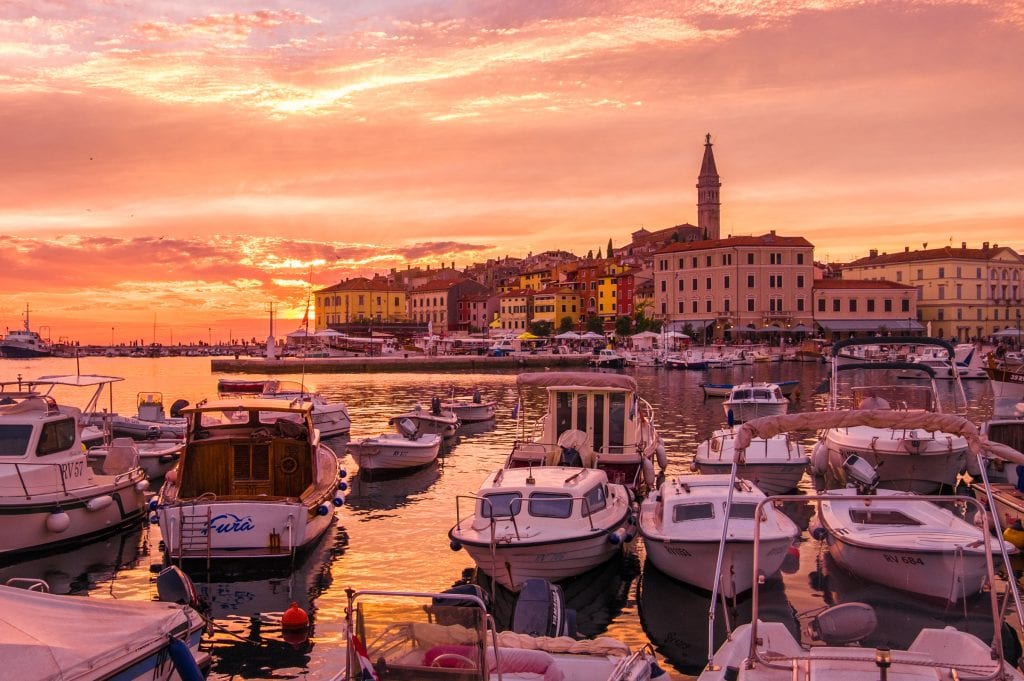
Best Time to Visit Rovinj and Istria
Most people visit Istria in the summer months, and like the Dalmatian coast, summer can be a wonderful time to visit Istria and cities like Rovinj and Motovun. But Istria is not as warm as Dalmatia, nor as sunny as Dalmatia, and the season doesn’t last as long.
If you’re looking to experience summer in Istria, I recommend aiming between mid-June and late September. Know that tourism will be at its peak in July and August.
But shoulder season is another wonderful time to visit Istria — you can visit quiet beach villages and interesting hill towns, all without the high temperatures or peak crowds.
Istria was once part of Italy, feels a lot like Italy, and has many of the same qualities that make Italy great — including a wonderful harvest season. For that reason, visiting Istria during the fall months can be a lot of fun.
Winter in Istria is quiet, particularly in resort towns.
Some festivals to keep in mind for Istria: Rovinj celebrates a three-day Easter Food Festival just before the holiday; the renowned Motovun Film Festival takes places in late July or early August; the Pula Film Festival takes place in July.
The Visualia Festival in Pula takes places in September, with light installations throughout the city; and Zigante Truffle Days in Livade, near Motovun, has events from September through November. Marunada , a celebration of chestnuts, takes place in Lovran, near Opatija, in October.
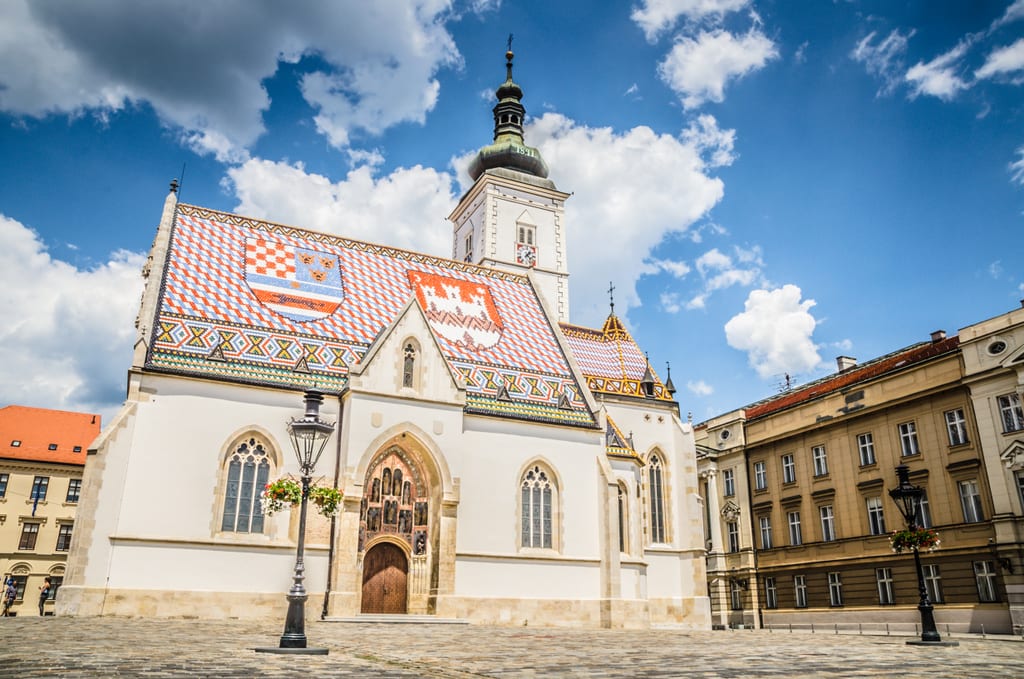
Best Time to Visit Zagreb
Zagreb is Croatia’s largest city, home to 800,000 people. As a result, this city is vibrant year-round. Zagreb has the most tourists in the summer, but it’s nowhere near the level of tourism in Rovinj, Split, or Dubrovnik.
Personally, I think the best time to visit Zagreb is during the shoulder season — April, May, October — to enjoy nice temperatures and city life.
Keep in mind that Zagreb gets much colder than the Dalmatian coast and gets snow in the winter!
March brings the Zagreb Festival of Lights , with light installations over the city. July brings the International Folklore Festival , one of the biggest celebrations of the year.
September brings the International Puppet Festival , with both Croatian and international artists showcasing their craft. Zagreb Film Festival usually takes place in early November.
Perhaps most impressive, though, is Advent in Zagreb — Christmas market season. Zagreb goes all out with decorations, art installations, an ice rink, and food stands featuring traditional Croatian Christmas treats. Unlike Christmas markets in other parts of Europe, this market lasts until January 1 rather than December 23.
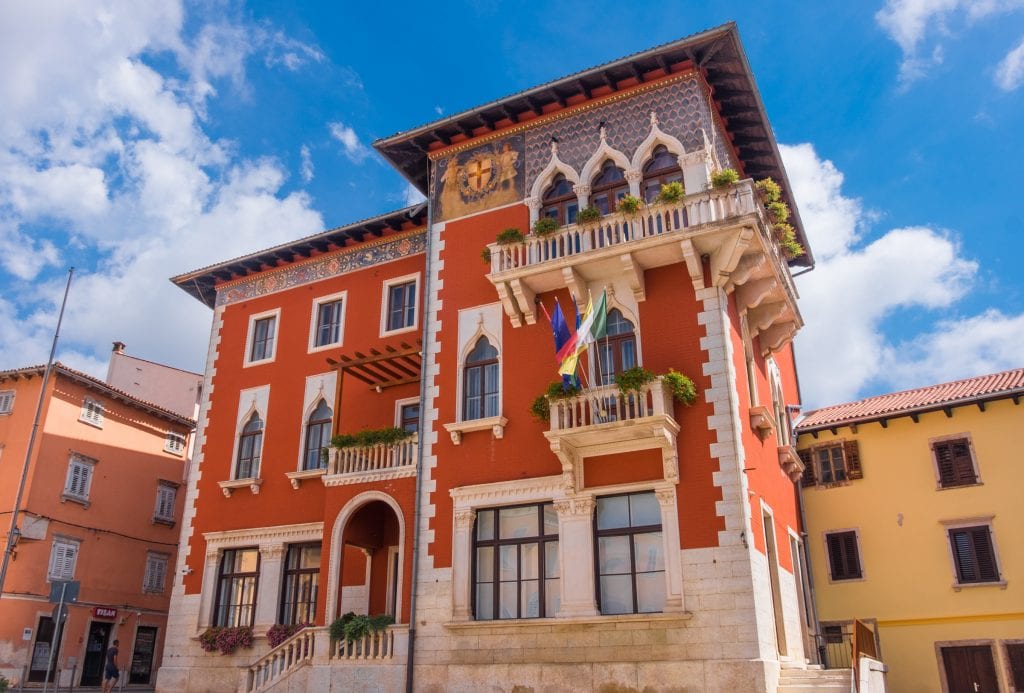
Best Time of Year to Visit Croatia
What is the best month to visit Croatia? Check out the overview here and find out which month is best for you.
January in Croatia
January is when you get the lowest temperatures of the year in Croatia. It will be cold, but there will be few other tourists around, and you’ll have many attractions to yourself — if they’re open, that is.
Some Carnival, or Maškare , celebrations begin in mid-January — particularly in the big Carnival cities like Rijeka.
Temperatures in Zagreb in January average from a low of 28 F / -2 C to a high of 37 F / 3 C.
Temperatures in Dubrovnik in January average from a low of 43 F / 6 C to a high of 54 F / 12 C.
February in Croatia
February is another similar month to January, with low temperatures and few tourists, but that’s okay — this month is when Carnival is at its peak!
Carnival, or Maškare , culminates in February with big celebrations. This is the time for costumed parades and parties. While Rijeka is the undisputed best place to celebrate Maškare, every place in Croatia puts their own spin on it in February.
Dubrovnik marks the Feast of St. Blaise, the city’s patron saint, on February 3 with local events and celebrations.
Temperatures in Zagreb in February average from a low of 32 F / 0 C to a high of 43 F / 6 C.
Temperatures in Dubrovnik in February average from a low of 43 F / 6 C to a high of 55 F / 13 C.
March in Croatia
March is when Croatia starts waking up to spring, with warming temperatures the first appearances of wildflowers. Like many countries, Croatia starts out firmly in winter and emerges into spring.
The Zagreb Festival of Lights takes place in March, with bright light installations representing the arrival of spring and a time of rebirth. In Ston on the Pelješac peninsula, the Festival of Oysters takes place on March 18, St. Joseph’s Day.
Temperatures in Zagreb in March average from a low of 37 F / 3 C to a high of 52 / 11 C.
Temperatures in Dubrovnik in March average from a low of 46 F / 8 C to a high of 57 F / 14 C.
April in Croatia
April is the first official full month of spring. Easter is a major holiday in Croatia and many Croatians take this time to travel domestically. International tourists begin trickling into Croatia in mid-to-late April.
In the days before Easter, Rovinj hosts an Easter Food Festival . Keep in mind that some years this can be in March. Enjoy traditional Istrian Easter dishes, listen to traditional brass bands, and enjoy chocolate eggs! In April, Split hosts Gast Fair , Croatia’s largest culinary festival.
Temperatures in Zagreb in April average from a low of 46 F / 8 C to a high of 61 F / 16 C.
Temperatures in Dubrovnik in April average from a low of 52 F / 11 C to a high of 63 F / 17 C.
May in Croatia
Early May and late May have very different feelings in Croatia. Early May is still firmly in spring with lots of flowers, and by late May, it feels like summer. Tourists are pouring in, hotels have raised their prices, and ferries are running on their summer schedule.
May 7 brings the Festival of St. Dominius, Split’s patron saint, and Split goes all out in celebrations.
Temperatures in Zagreb in May average from a low of 54 F / 12 C to a high of 70 F / 21 C.
Temperatures in Dubrovnik in May average from a low of 57 F / 14 C to a high of 70 F / 21 C.
June in Croatia
Hello, summertime! June is undisputedly the kick-off of summer throughout Croatia. Expect the crowds to swell and temperatures to get fiercely hot.
While you can see Moreška sword dancing throughout the summer in Korčula, June hosts the Sword Dance Festival . Dancers from all over Korčula and other islands come together to compete and perform.
Temperatures in Zagreb in June average from a low of 57 F / 14 C to a high of 75 F / 24 C.
Temperatures in Dubrovnik in June average from a low of 64 F / 18 C to a high of 77 F / 25 C.
July in Croatia
Hot, sweaty, and incredibly crowded. July in Croatia brings long days, lots of sunshine, and the most tourists of the year.
July is festival season in Croatia! Zagreb hosts the International Folklore Festival , featuring traditional music performances all over the city in traditional costume. Šibenik celebrates Supertoon , a festival celebrating animation, in July.
July is a big month for film festivals: Motovun Film Festival , Pula Film Festival , and Mediterranean Film Festival Split all take place in July.
July is also a big month for music festivals: see the music festivals section here .
On the Dalmatian Coast, Dubrovnik Summer Festival , Split Summer Festival , and Hvar Summer Festival bring concerts, events, and performances throughout the month of July.
Temperatures in Zagreb in July average from a low of 61 F / 16 C to a high of 77 F / 25 C.
Temperatures in Dubrovnik in July average from a low of 70 F / 21 C to a high of 84 F / 29 C.
August in Croatia
Yet another month of peak travel in Croatia. August is incredibly hot and one of the most crowded months of the year.
Music festivals continue into August. See the music festivals section here .
On the Dalmatian Coast, Dubrovnik Summer Festival , Split Summer Festival , and Hvar Summer Festival bring concerts, events, and performances throughout the month of August.
Temperatures in Zagreb in August average from a low of 61 F / 16 C to a high of 77 F / 25 C.
Temperatures in Dubrovnik in August average from a low of 70 F / 21 C to a high of 82 F / 28 C.
September in Croatia
Welcome to the sweet spot. September is my personal favorite month fo the year in Croatia, where you can enjoy summer temperatures, warm water, and far fewer tourists than July or August. Early September is still busy (though most families have left), but late September, particularly in Dalmatia, is warm, airy, and divine.
September brings Visualia Festival in the Istrian city of Pula, where light shows take place all over the city and the cranes at the water’s edge light up in bright colors. Zagreb hosts the International Puppet Festival . Zigante Truffle Days in Livade, near Motovun, has events beginning in September.
Temperatures in Zagreb in September average from a low of 55 F / 13 C to a high of 70 F / 21 C.
Temperatures in Dubrovnik in September average from a low of 64 F / 18 C to a high of 77 F / 25 C.
October in Croatia
October can vary quite a bit through Croatia. In Dalmatia, early October feels like an extension of summer, but as you head further north, it’s a time for pleasantly cool temperatures, a bit more rainfall, and the food harvest.
Good Food Festival takes place in Dubrovnik (though occasionally in September). Zigante Truffle Days in Livade, near Motovun, has events throughout October. Marunada , a celebration of chestnuts, takes place in Lovran, near Opatija in Istria, in October.
Temperatures in Zagreb in October average from a low of 46 F / 8 C to a high of 59 F / 15 C.
Temperatures in Dubrovnik in October average from a low of 57 F / 14 C to a high of 70 F / 21 C.
November in Croatia
November is when it cools down throughout the country — and it’s also at its rainiest time of year. You can enjoy some clear days in November, but be prepared for all kinds of weather.
Zagreb Film Festival usually takes place in November. Zigante Truffle Days in Livade, near Motovun, has events concluding in November.
Temperatures in Zagreb in November average from a low of 37 F / 3 C to a high of / 48 C.
Temperatures in Dubrovnik in November average from a low of 50 F / 10 C to a high of 63 F / 17 C.
December in Croatia
Croatia has firmly cooled down by December, and there’s still some rain carryover from November. Zagreb and Slavonia might see the first snow. Christmas celebrations begin throughout the country.
Zagreb explodes with Christmas markets through the month of December for Advent in Zagreb , one of the most underrated city-wide Christmas celebrations in Europe.
Temperatures in Zagreb in December average from a low of 30 F / -1 C to a high of 39 F / 4 C.
Temperatures in Dubrovnik in December average from a low of 46 F / 8 C to a high of 57 F / 14 C.
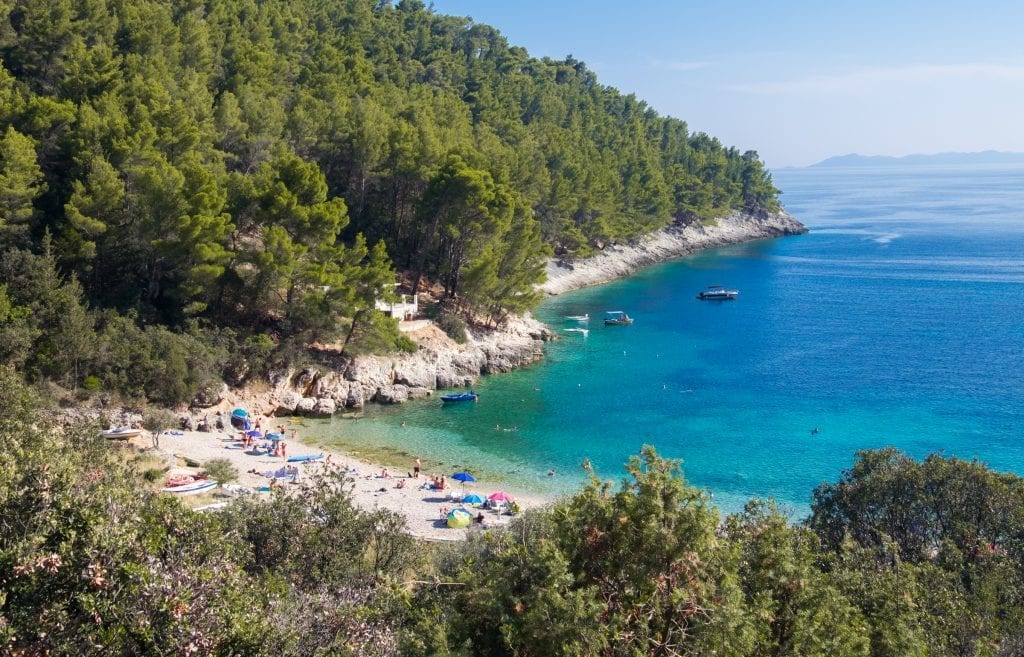
Best Time to Visit Croatia for a Beach Holiday
September would be my first choice for a beach vacation in Croatia. At this time of year you’ve got summer temperatures, yet the crowds are smaller, the cruise ships are gone, and the kids are back in school.
Croatia in September is not exactly a secret, and there will be plenty of travelers there — but it’s nowhere on the level of tourism you see in July and August. For that reason, I recommend aiming toward later in September, when things calm down even more.
Planning a beach holiday in Dalmatia? Aim for late September. Planning a beach holiday in Istria? Plan for early September, as it isn’t quite as warm there.
On the other hand, if you don’t mind water that’s a little bit on the colder side, early June can be another lovely time in Dalmatia. For Istria I’d recommend aiming for late June.
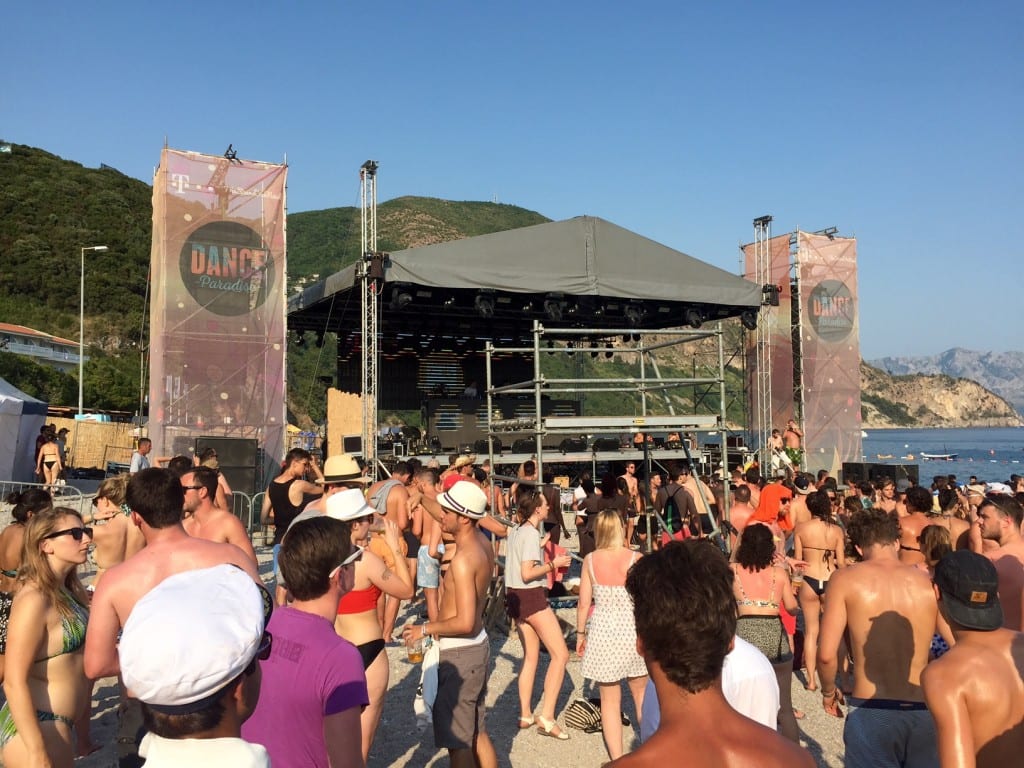
Best Time to Visit Croatia for Music Festivals
Croatia’s coastline explodes with music festivals during the summer months. If you want to hit up a festival or two, the majority of them take place in July and August.
Ultra Europe is the biggest festival with the biggest names in EDM, and it takes place in July in Split.
Umag, a seaside town in Istria, hosts Sea Star Festival in May.
Tisno, on the Dalmatian Coast near Šibenik, hosts Dimensions in July, Hospitality on the Beach in July, SuncéBeat in July, Outlook Origins in July, and Defected Croatia in August.
Zrce Beach on the island of Pag hosts Hideout Festival in June, Fresh Island Week in July and Sonus Festival in August.
INMusic is held in Zagreb in June and draws big names like The Killers.
If you’re hoping to go to music festivals in Croatia and open to a longer trip to the Balkans, consider extending your trip to EXIT in Belgrade, Serbia, and Sea Dance in Budva, Montenegro (the latter of which I quite enjoyed).
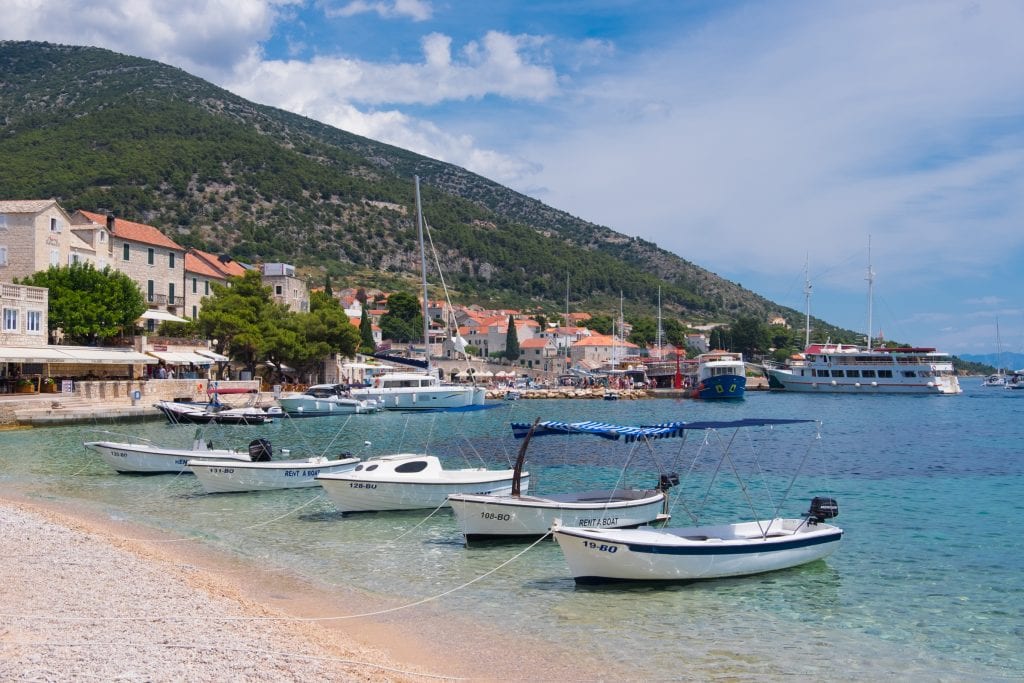
Best Time to Visit Croatia with Kids
Croatia is an extremely family-friendly destination, so don’t worry about bringing your kids to Croatia! Croatians love children and the country is set up to welcome families with kids of all ages.
Most families traveling to Croatia with kids are looking for beach time. If that’s the case for you, aim during their summer vacation. It will be crowded, but it will be easy.
You may be tempted to plan a trip in May or early June, but keep in mind that the Adriatic can be cold during these months. It spends the whole summer warming up. If your kids don’t like swimming in cold water, they probably won’t be a fan of the Adriatic in late spring.
If you’re not visiting for a beach trip, consider visiting during the spring or fall months. You’ll still have nice weather and you won’t have the complete shutdown of winter.
Finally, if you’re up for visiting in February, Carnival can be a LOT of fun for kids — especially if you hit up one of the big festivals like Rijeka.
Bonus tip: of all the places I visited in Croatia, I think the island of Brač is a great choice if you have young kids. It’s the easiest to get to (a short ferry ride from Split, the biggest air hub), and the area around Bol seems designed for families with lots of beaches, a boardwalk, and kid-friendly amenities.
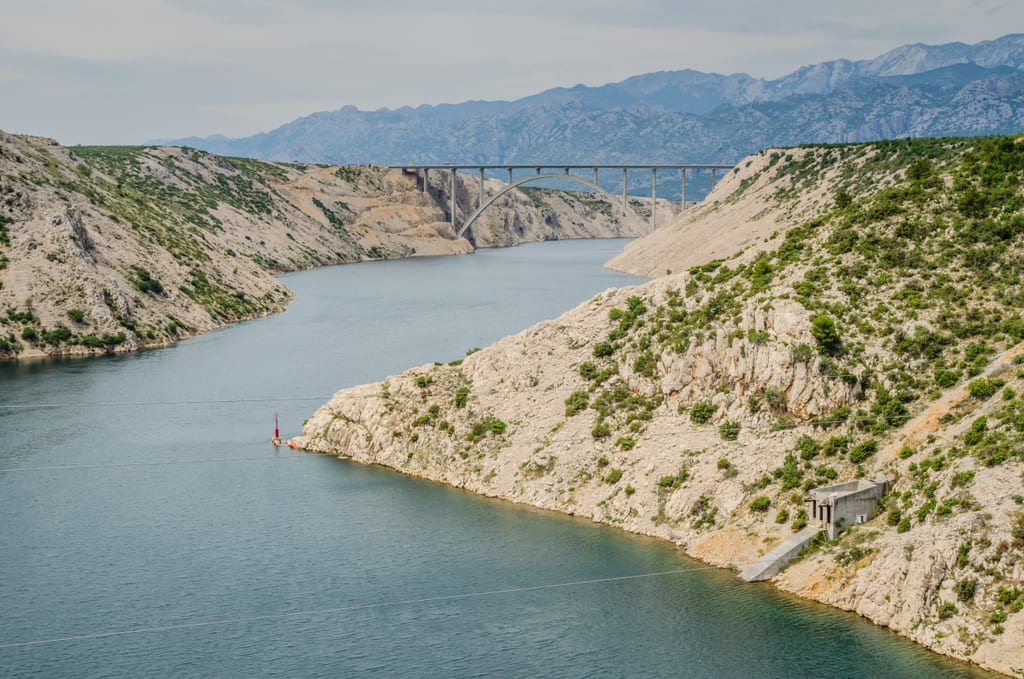
Cheapest Time to Visit Croatia
The cheapest time to visit Croatia is during the winter. This is when accommodation is at its cheapest; if you’re flying to Croatia from North America, you’ll likely find cheaper transatlantic flights.
However, keep in mind that winter in Croatia is cheap for a reason.
Much of Croatia is shut down during the winter months, from restaurants to shops to hotels. Places like the Makarska Riviera almost feel like ghost towns. Many seasonal flights in Croatia don’t run at all in winter; you may need to fly to Zagreb and drive or take public transportation from there.
It’s especially tough traveling the islands in the winter. The island population dwindles down to just the year-round locals, most of whom will wonder why you’re even there, and all the tourist-driven restaurants that the locals avoid won’t be in business.
If you’re looking to experience Croatia at a more active time of year that isn’t the heat of summer, consider April or October — not winter.
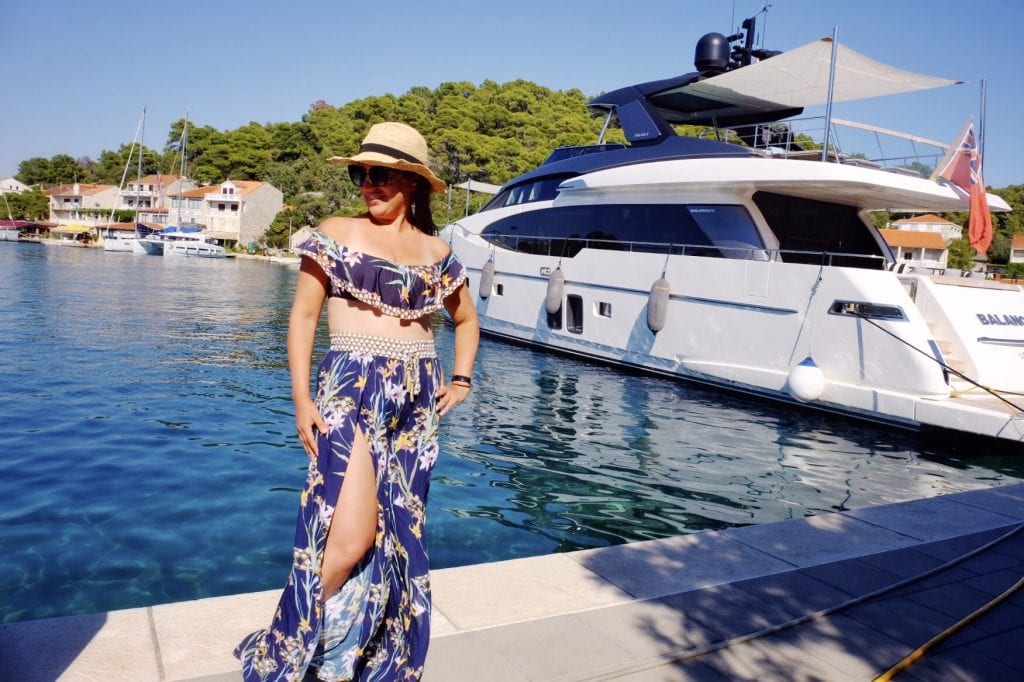
Best Time to Visit Croatia Overall
If you’ve read this far, you know what I think — the best month for visiting Croatia is September, and if you can, aim for mid-to-late September. That is the best time of year to enjoy the best of Croatia’s weather (as well as the Adriatic at its warmest temperature) while avoiding the worst crowds.
September may be golden — but there are so many wonderful times to visit Croatia. You can’t beat Zagreb in December, all decked out for Advent, or Rijeka in February, filled with costume parades, or Split in April, exploding with food festivals.
I hope you enjoy your time in Croatia, no matter what time of year you choose to visit. Then come back and tell me all about it!
Planning a Trip to Croatia:
- Two Weeks in Croatia Itinerary
- What NOT to Do in Croatia
- Solo Female Travel in Croatia: Is it Safe?
- 30 Stunning Mediterranean Islands To Visit In Your Lifetime
Croatian Islands and the Dalmatian Coast:
- How to Spend Three Days in Dubrovnik
- Why Korčula, Croatia, is the Coolest Island of All
- Vis, Croatia, is a Quietly Stunning Island
- Dubrovnik Survival Guide
- The Waterfalls of Krka National Park
- A Place Like Zadar
- 30 Fabulous Things To Do in Split, Croatia
- 29 Sunny Things To Do In Hvar, Croatia
Istria and the North:
- Guide to Rovinj, Croatia’s Prettiest City
- Places to Visit in Istria, Croatia’s Italian-Flavored Peninsula
- 21 Unforgettable Things To Do In Zagreb, Croatia
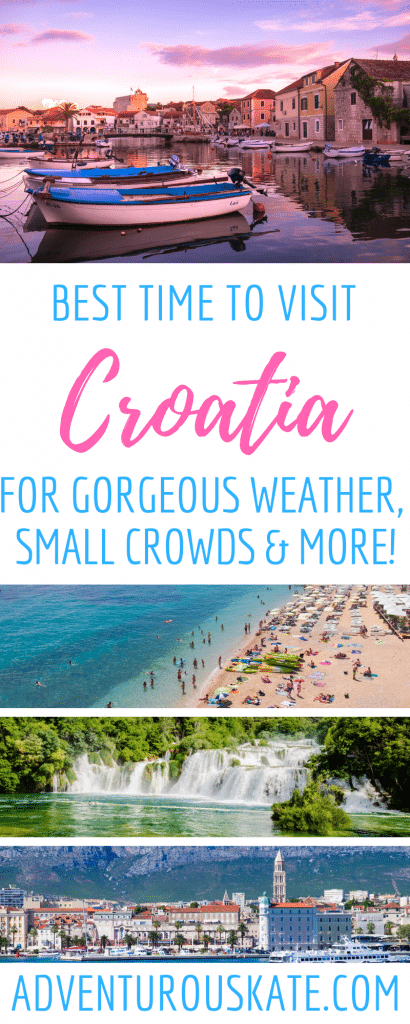
Have you been to Croatia? What time of year did you visit? Share away!
Leave a Comment Cancel Reply
Your email address will not be published. Required fields are marked *
This site uses Akismet to reduce spam. Learn how your comment data is processed .
Croatia Travel Guides
Your one-stop travel guide for Croatia
Travel Guides · April 4, 2020
Croatia in April: Weather, Things to See and Travel Tips
April is the height of spring, with an abundance of good weather and longer daylight hours. It is still low season but this month is often considered to be one of the best times to visit Croatia.
You get to enjoy popular attractions without lining up for hours or dodging other tourists as you explore castles or museums.
New to Airbnb? Get a $43 off for your next trip if you use our link here .
You get to really take in the country’s springtime scenery almost unobstructed. Croatia in April is just guaranteed to be worth it so plan ahead to avail of the best deals.
To help you out, here’s our April guide with information about the weather, things to do and travel tips.
What is the weather like in Croatia In April?

Temperature in Croatia in April
During April, the average temperature in Croatia is between 11°C to 17°C.
Rain in Croatia in April
The month of April isn’t spared from rain as Croatia gets around 90 mm over a period of 13 days.
Wind in Croatia in April
The average wind speed in Croatia 8.5 to 9.1 miles per hour during April.
Sun in Croatia in April
Daylight in Croatia stretches from 12 to 14 hours in April. Sunrise is usually at 6 am, while sunset is between 7 and 8 pm.
What to pack in Croatia for April
March , April, and May are the spring season in the country. Spring in Croatia is still colder than usual, bit weather is generally mild and perfect for exploring. The items listed here are ideal for still keeping warm, yet comfortable and ensures easy movement.
V-neck shirts – bring at least 3, in different colors. These are versatile and easy to pair with anything. Like these cotton v-neck shirts. You can wear a jacket over it as well or dress it u with a scarf if the weather gets chilly. You can check these shirts here .

Long-sleeved shirts — always a good idea, these are best for keeping you warm and also goes well with pretty much anything. Wear with leggings or jeans for a casual walk around town, wear underneath a jacket or just wear a scarf for dining out or date night. Check out these long sleeve shirts .
Knee-length or mid-calf skirts — a great alternative for jeans and leggings that you can wear if you’re museum-hopping in Zagreb or hanging out at the Roman forums in Zadar , or exploring Diocletian’s Palace in Split , such as this pretty Zara skirt . It’s comfortable and just a bit dressy, looks great in photos, too!

Black leggings — this item should be in your travel must-haves any season of the year as it’s versatile, easily keeps you warm and goes well with pretty much anything.
Comfort fit jeans — you can easily layer these jeans with leggings if the weather gets too cold, and also ensures easier movements when embarking on long-distance walks or hikes.

Crease proof dress pants (for men) — be sure to bring at least a couple of these as an alternative to jeans. It’s dressy but it’s versatile, something that will take you from day strolls around the city to a fine dinner in the evening. See this stylish wrinkle-resistant pants from Vegorrs.

Reusable water bottle with filter – sure, Croatia’s tap water is generally clean and safe to drink, but it’s always best to bring your own reusable bottle for quick refills and to help eliminate the use of plastic. Buy something like this RPA-free bottle .

Sturdy, Foldable Umbrella — Croatia does have surprise rain showers any time of the year so this one’s a definite must to keep you protected. Pack something like this compact windproof travel umbrella.
A handy bathroom kit — it’s really just made up of hand sanitizer and wet wipes (tissue is optional) which is useful when you commute or during your city sightseeing tours on foot. Also, a great way to stay clean and germ-free. This Purell hand sanitizing wipes travel pack is handy as both sanitizer and wipes.

Comfortable Hiking Boots — a must if you’re planning to explore national parks, mountains, fortresses, lighthouses and even a stroll around a particular city on foot. Pick the ones that are a bit dressy so you can wear them on your other Croatia activities, too. Just like this one from Xpeti which comes in different colors.
Things To Do In Croatia In April
1. spring on the zrmanja river.

An exciting attraction in Croatia that’s a definite must experience is spending part of your April trip in the Zrmanja.
Surround yourself with breathtaking natural sceneries in this part of northern Dalmatia, which is known as the “European Grand Canyon”.
Better yet, join the fun in the ‘Spring on the Zrmanja Rive’ event, where you can watch kayakers and rafters in action.
Join the fun by cheering on the participants, or you may also enjoy a boat ride along with the crystal clear waters.
2. Dubrovnik FestiWine

A wine festival is always a good reason to go to Croatia’s most popular city.
Every April, there’s a week-long event that celebrates the wines of the Dubrovnik-Neretva county.
During this festive week, bars and restaurants feature a varied selection of local wines as well as sampling sessions. There are workshops and exhibitions, as well as an open market in the city’s picturesque old town.
Apart from local wines, fresh produce and native delicacies are also sold. It’s a great opportunity to stock on some of Croatia’s best products to bring home.
3. Dalmatian Coast tour

After you’ve had enough vino during the FestiWine, take advantage of the low season and tour the usually crowded destinations along the Dalmatian coast.
Considered as one of Croatia’s most beautiful regions, Dalmatia is home to the ancient Roman city of Split and the charming old city of Dubrovnik.
Hire or rent a car and explore on your own. Enjoy attractions like the Diocletian’s Palace and Dubrovnik’s old city walls while there are still fewer tourists.
Savor the quiet, relaxed pace and take lots of photos. It may be touristy, but this is a great thing to do in Croatia in April where you really get to take in its long, fascinating history.
4. Pick Wild Asparagus

Everything blooms and comes to life in springtime, and it is also the season in Croatia to harvest wild asparagus, which are found in the woods and forests of the Dalmatian region.
This delicious vegetable is rather expensive when bought, but as a fun and unique activity in Croatia, go ahead and forage!
Morning is the best time to do it, and wild asparagus are quite easy to spot. They easily stand out in the bushes with their vivid purple-green color.
Get a few handfuls, take them back to the kitchen and think of how you’d want to cook them. They can go in soups, stews and stir fry dishes.
Despite the very mild bitter taste, wild asparagus is delicious. Getting them fresh is surely one of the best activities to do in Croatia in April.
5. Spring in Kastav

Go somewhere different, apart from the usual Croatian destinations when you visit in April.
Try spending a few days in charming Kastav, an old walled town situated on a hill close to Rijeka. This town is known as one of the first places to receive snow during winter.
At springtime, however, its green parks and lush forests turn into a showcase of colors. Kastav is known for its picturesque downtown that’s perfect for afternoon strolls.
This fortified town has numerous historic buildings, which include a 13th-century church. There are also green spaces for outdoor activities such as hiking and cycling.
6. Bond with Peacocks in Lokrum

Located less than a kilometer away from Dubrovnik, Lokrum island is easily reached via a 15-minute ferry service. This is your quick island getaway if you’re pressed for time but want to see more of Croatia.
Lokrum may be small, but it has some interesting attractions. There are an inland saltwater lake, a nudist beach, and a Benedictine monastery.
If you thought that’s eclectic enough then wait until you meet the island’s colorful residents – the peacocks.
They roam the island freely and would most likely join you as you stroll along the lake, walk to the monastery or lounge by the beach.
If you’re up for some quiet time, a visit here is one of the best things to do in Croatia in April.
Travel Tips for Croatia in April
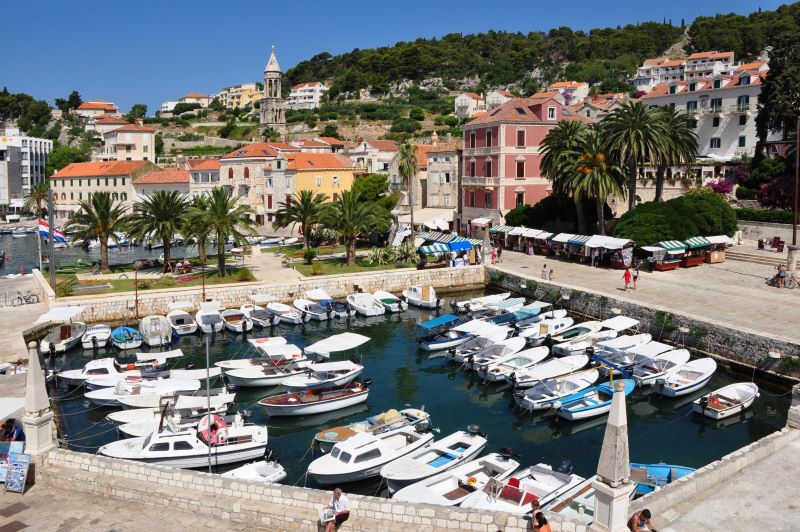
1. If your Croatia holiday is only for a few days and you want to see as much of it as you can, your best bet is to go on a cruise.
A cruise allows you to see multiple destinations in Croatia onboard a boat and definitely saves a lot of travel time. You get to relax more and have plenty of time to appreciate each destination.
Cruises usually stop at coastal towns and cities like Dubrovnik , and islands like Hvar , Korcula , Mljet, and Trstenik.
2. You always need to include rain gear when going to Croatia as no month is spared from its rather fickle weather.
An essential is a coat that’s weatherproof and easily folded into something that won’t take a lot of space in your day bag.
3. Bring clothes that are versatile and multipurpose so as to save space in your luggage.
Examples of these are athletic shorts that can double as sleepwear and casual shirts in light material that you can wear when going out or as a pajama top.
Leggings and tights can also go from dressy streetwear (paired with a long top plus jacket) to something you can pair with a shirt and long coat during hiking trips.

4. Croatia isn’t just old towns with historic buildings or ancient walls next to pristine beaches.
April is a great opportunity to explore not so popular areas like those in the mountains and plains. Examples of these places are Motovun in Istria, and Brela or Omis near Split .
5. Another fantastic way to explore Croatia aside from renting a car is by going on a biking or motorcycle tour. You can rent these locally and truly a cool way to explore as traffic is a breeze during April.
Explore the countrysides, mountainous areas, vineyards, and even islands. You might even stumble upon hidden gems during your trip.
Get on the List
You’ll also love.

10 Best Things To Do in Brac, Croatia
Trending now.
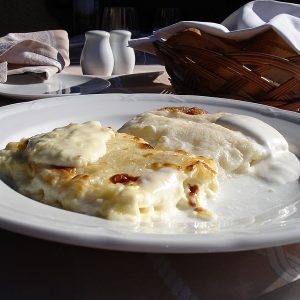
Become an Insider
Join Croatia Travel Guides' mailing list for exclusive content, tips, & giveaways.
Hello there! Welcome to Croatia Travel Guides. CTG aims to help travelers find their way for the first time in Croatia. We are your one-stop travel guide for all things Croatia.
- Things To Do
- Food and Culture
- Where To Go
- Where To Stay
- Travel Guides
- Privacy Policy
- Disclaimer and Disclosure
Copyright © 2024 Croatia Travel Guides · Theme by 17th Avenue
Copyright © 2024 · Mia on Genesis Framework · WordPress · Log in

Best Time to Visit Croatia: 2024 Croatia Planning Tips
IF YOU ARE PLANNING YOUR HOLIDAY TO CROATIA, YOU MIGHT BE THINKING, WHEN IS THE BEST TIME TO VISIT CROATIA.
As someone who calls Croatia home year-round , I fully understand the nuances of each season, from weather patterns to the ebb and flow of tourist crowds. There are many factors to consider when deciding the best time to visit Croatia. For example the country’s diverse climate and of course personal preferences . I love the sun, but I also love the outdoors, so that would impact where and when I would travel in Croatia.
My goal in this article is to help you navigate these factors and variations. You can then decide the best time for your Croatian adventure and start planning your vacation. Let me jump straight in with an overview of the seasons in Croatia .
Please note that some links on CroatiaExperiences.com are affiliate links. I may receive a commission if you click through a link and make a purchase from one of our partners. It doesn’t cost you anything extra and helps me to keep providing travel content about Croatia. Learn more .
Best Time to Visit Croatia
High season in croatia.

The high season typically spans from June to August . During this time expect warm temperatures and sunny skies, creating the perfect conditions for beach vacations in Croatia and outdoor adventures. Coastal towns and islands buzz with energy as visitors, like myself, want to soak up the Mediterranean climate and vibrant atmosphere.
Pros for visiting Croatia in the High Season
✔️ In the high season, Croatia comes alive with an array of exciting activities and events.
✔️ From sailing along the stunning Adriatic coast to exploring historic cities steeped in culture and tradition, there’s no shortage of things to see and do in Croatia .
✔️ The warm weather allows for leisurely beach days and thrilling water sports, while evenings are filled with lively entertainment and delicious seafood dinners by the sea.
✔️ There are many public transportation options connecting all the cities and towns in Croatia and plenty of flight options to Croatia.
Cons for visiting Croatia in the High Season
❌ The popularity of the high season also means larger crowds and higher prices.
❌ Popular tourist destinations can become crowded, particularly in July and August, making it essential to plan and book accommodations and activities well in advance.
❌ The hot temperatures during the day can be intense, so if visiting Croatia in the High Season, you must take precautions to stay hydrated and seek shade when needed. You won’t find Croatians lying on the beach in the midday sun!
❌ If you are driving, expect traffic in popular areas.
Key Events and Activities taking place in Croatia during the High Season
The high season in Croatia is marked by a variety of key events and activities. In Dubrovnik, the renowned Dubrovnik Summer Festival showcases an array of cultural performances. Split comes alive with the Split Summer Festival , featuring open-air concerts and theatrical performances in the historic Diocletian’s Palace. I also enjoy watching the sailing regattas and attending food festivals, and outdoor concerts throughout the summer months. It is the time when everything is alive and happening!
Top Tips for Visiting Croatia in the High Season
Here are my tips to make the most of your visit to Croatia during the high season:
💡 Book Croatia accommodation, activities and transportation well in advance to secure the best options and avoid disappointment.
💡Visit popular attractions early in the morning or late in the afternoon to avoid the largest crowds.
💡Stay hydrated and protect yourself from the sun by wearing sunscreen, a hat, and sunglasses.
💡Be mindful of your budget and plan for higher prices for accommodations, dining, and activities during peak season.
Shoulder Season in Croatia

The shoulder seasons of spring (April-May) and autumn (September-October) offer a welcome respite from the crowds and heat of the high season, while still providing pleasant weather and a wealth of activities to enjoy. For me, this is one of the best times to visit Croatia and an ideal time to explore Croatia’s diverse landscapes and cultural attractions.
Pros for visiting Croatia in the Shoulder Season
✔️ During the shoulder season, the temperatures are pleasantly mild and there are fewer crowds, allowing for a more relaxed and authentic travel experience.
✔️ The weather is perfect for outdoor activities such as hiking, cycling, and sightseeing.
✔️ Attractions and accommodations are more readily available and affordable compared to the high season.
Cons for visiting Croatia in the Shoulder Season
❌ While the shoulder season offers many advantages, keep in mind that the weather can be unpredictable, with occasional rain showers and cooler temperatures.
❌ Some beach destinations may have quieter atmospheres or cooler water temperatures, limiting swimming opportunities.
❌ Some restaurants and amenities in more remote locations may not be open.
Key Events and Activities taking place in Croatia during the Shoulder Season
The shoulder season in Croatia is marked by a variety of cultural events and outdoor activities. Explore the wine regions such as Istria, Dalmatia, and Slavonia and visit wineries to taste local Croatian wines. Embrace the great outdoors and cycle the coastal routes in Dalmatia or around Plitvice National Park.
Top Tips for Visiting Croatia in the Shoulder Season
Here are my tips to make the most of your visit to Croatia during the shoulder season:
💡Pack layers to accommodate changing weather conditions, including a light jacket or sweater for cooler evenings.
💡Take advantage of off-season deals and discounts on accommodation and tours.
💡Embrace the slower pace and enjoy a more authentic experience with locals, who are often more relaxed and willing to engage with visitors during this time.
💡Check the opening hours and availability of attractions and restaurants, as some may have limited hours or be closed during the shoulder season.
Low Season in Croatia

The low season in Croatia, which typically spans from November to March , offers a tranquil and budget-friendly option for people seeking to explore the country’s natural beauty and cultural heritage without crowds. While the weather may be cooler and some tourist facilities closed, the low season offers more immersive travel experiences. There are a reduced number of transportation and flight connections, so you will need to be more strategic with your planning if visiting Croatia in the low season.
Pros for visiting Croatia in the Low Season
✔️ During the low season, you can enjoy peaceful surroundings and uncrowded attractions.
✔️Accommodation and tours are often available at discounted rates, making it an ideal time if you are travelling on a budget to explore Croatia’s treasures.
✔️ It’s a great time to enjoy active pursuits such as cycling and experience Croatia with the locals.
✔️ If you are hiring a car, you won’t need to worry about traffic or parking.
Cons for visiting Croatia in the Low Season
❌ If you are visiting Croatia in the low season be prepared for cooler temperatures and shorter daylight hours, as well as the possibility of rainy or snowy weather, particularly in inland regions. When it rains here, it really rains! But as a wise person once said, there is no such thing as bad weather, just bad clothing. So pack appropriately!
❌Some tourist facilities may be closed or operating on limited hours.
❌ There are reduced transportation options, especially boat connections to the islands, so it can be trickier to travel around.
Key Events and Activities taking place in Croatia during the Low Season
Despite the quieter atmosphere of the low season, there are still plenty of activities and events to enjoy in Croatia including the Dubrovnik Winter Festival and the Rijeka Carnival . From exploring historic cities adorned with festive decorations to sampling traditional winter delicacies at holiday markets, it’s a great time to embrace yourself in Croatia’s seasonal festivities.
Tips for Visiting Croatia in the Low Season
Here are my tips to make the most of your visit to Croatia during the low season:
💡Pack warm clothing and waterproof gear to stay comfortable in cooler and potentially wet weather conditions.
💡Take advantage of off-season deals and discounts on accommodations, tours, and attractions.
💡Embrace the slower pace and enjoy a more relaxed and authentic travel experience with fewer crowds and more opportunities for meaningful interactions with locals.
💡Check the opening hours and availability of tourist facilities and attractions, as some may have limited hours or be closed during the low season; as well as the transport routes which will be reduced.
READ NEXT > Best Places to Stay in Croatia: Accommodation Tips for Travellers to Croatia 2024
Croatia Travel: A Month-by-Month Overview

Croatia in January
In January, Croatia experiences cool temperatures across the country, with average highs ranging from 8°C to 12°C. The sea temperature is chilly, hovering around 12°C, making swimming less appealing but perfect for scenic coastal walks. Despite the cooler weather, January offers unique cultural experiences, such as the Dubrovnik Winter Festival and the start of the Rijeka Carnival . You can also enjoy skiing and snowboarding in the inland regions.
Croatia in February
February in Croatia brings similar temperatures to January, with average highs ranging from 9°C to 13°C. The sea temperature remains cool, averaging around 11°C. The Rijeka Carnival continues into February. For outdoor enthusiasts, February is an excellent time for winter sports and snowy adventures in the mountainous regions, with ski resorts like Platak and Bjelolasica. The waterfalls at Plitvice Lakes National Park freeze and turn it into a winter wonderland – it is a stunning sight to see.
Croatia in March
As spring begins to emerge, March sees an increase in temperatures across Croatia. The average highs range from 12°C to 16°C. The sea temperature starts to rise slightly, reaching around 13°C. March is a good month to enjoy outdoor activities such as exploring the historic city of Split and hiking in the picturesque landscapes of Istria and Dalmatia.

Croatia in April
April brings mild and pleasant weather to Croatia, with average highs ranging from 15°C to 19°C. The sea temperature begins to warm up, reaching around 15°C, making it suitable for early-season beach activities. April marks the start of the tourist season, with attractions reopening. Spring blooms adorn the countryside, creating a picturesque backdrop for outdoor adventures and sightseeing. April is an ideal time to visit Croatia’s national parks, including Plitvice Lakes and Krka and enjoy Easter Celebrations.
Croatia in May
May marks the beginning of summer-like weather in Croatia, with average highs ranging from 19°C to 24°C. The sea temperature becomes more inviting, reaching around 18°C, perfect for swimming and water sports. May 1st (Labour Day in Croatia) traditionally marks the first day of swimming. May is a fantastic time to explore Croatia’s coastal towns and islands, from the vibrant city of Dubrovnik to the idyllic shores of Hvar and Korčula.
Croatia in June
June heralds the arrival of summer in Croatia, with warm temperatures and sunny skies inviting you to the coast. Average highs range from 24°C to 28°C. The sea temperature reaches a comfortable 22°C, ideal for beachgoers and water enthusiasts. June starts the peak tourist season, with bustling cities and crowded beaches. It is also a perfect time to enjoy outdoor activities and cultural events. Highlights include sailing along the Adriatic coast and attending the Dubrovnik Summer Festival.

Croatia in July
July is the height of summer in Croatia, with hot temperatures and clear skies. Average highs range from 27°C to 31°C, with the sea temperature peaking at around 24°C, perfect for swimming and sunbathing. July offers an abundance of activities and events for everyone to enjoy. From island hopping and beach parties to cultural festivals and culinary delights, there’s never a dull moment in Croatia during July!
Croatia in August
August continues the summer heat in Croatia. The average highs range from 27°C to 31°C and sea temperatures remain warm at around 25°C. The beaches are bustling with visitors soaking up the sun, while the cities are alive with cultural events and nightlife. August is the perfect time for adventures on the sea, including windsurfing, snorkelling and exploring Croatia’s underwater paradise.
Croatia in September
As summer begins to wane, September offers a pleasant transition to autumn in Croatia. This is my favourite month in Croatia! Average highs range from 23°C to 27°C, with the sea temperature still warm at around 23°C, perfect for late-season swimming. September is an ideal time for outdoor activities like hiking and cycling, as the weather remains mild and the crowds start to thin out. It’s also the time of the grape harvest and wineries are always on the lookout for people to help!

Croatia in October
October brings cooler temperatures to Croatia, with average highs ranging from 18°C to 22°C. The sea temperature begins to drop but still hovers around 20°C, so swimming and water activities are still possible. October is a great time to explore Croatia’s cities and historic sites, as tourist crowds diminish and the weather remains pleasant for sightseeing. Nature lovers will appreciate the autumn foliage in the countryside and the opportunity to hike in the national parks before winter sets in.
Croatia in November
November marks the onset of winter in Croatia, with cooler temperatures and occasional rain showers. Average highs range from 13°C to 17°C, while the sea temperature decreases to around 17°C, making swimming less common. I do remember years on Korcula when it was still warm enough to swim in November. Despite the cooler weather, November offers unique experiences, such as truffle hunting in Istria.
Croatia in December
December brings festive cheer to Croatia, with twinkling lights and decorations adorning the cities and towns. Average highs range from 9°C to 13°C, with the sea temperature cooling to around 14°C. December is a magical time to visit Croatia, with Christmas markets, concerts, and events celebrating the holiday spirit. I love Christmas time in Croatia. When we can enjoy traditional Croatian dishes like fritule and mulled wine while exploring the charming Christmas markets in Zagreb, Split, and Dubrovnik.
Croatia’s Diverse Climate: Weather Insights by Region

Croatia’s geographical diversity lends itself to a wide range of climates and landscapes, which also means it offers diverse activities. Let me introduce you to the distinct characteristics of coastal and inland Croatia.
Weather in Coastal Regions of Croatia
Croatia’s coastal regions have a Mediterranean climate, characterized by hot, dry summers and mild, wet winters. The Adriatic Sea moderates temperatures, creating pleasant conditions for beachgoers and outdoor enthusiasts. The sea breeze provides relief from the heat.
Plenty of water activities can be enjoyed throughout the summer in coastal Croatia. You can enjoy windsurfing and kitesurfing, snorkelling and diving, and kayaking.
Weather in Inland Regions of Croatia
Croatia’s inland areas, including regions like Zagreb, experience a continental climate characterised by hot summers, cold winters, and greater temperature fluctuations throughout the year. The absence of the moderating influence of the Adriatic Sea results in more extreme weather conditions compared to the coast.
Inland areas of Dalmatia, such as the Dinaric Alps, experience slightly cooler temperatures and occasional rainfall. This offers a refreshing escape from the summer crowds. Istria’s inland areas experience greater temperature variations, with cooler temperatures in the hills and valleys compared to the coastal areas. These regions are a haven for outdoor enthusiasts year-round.
In winter, mountainous regions in Croatia transform into snowy paradises, attracting skiers and snowboarders to its picturesque slopes.
Best Time to Visit Croatia for Sightseeing

Croatia’s rich cultural heritage can be experienced year-round, with museums, galleries, and historic sites open throughout the year. However, the best time to explore Croatia’s historic cities and cultural landmarks is during the shoulder seasons of spring and autumn. During these times, the weather is mild, the skies are clear, and tourist crowds are fewer.
In spring, it’s lovely to wander through the narrow cobblestone streets of Dubrovnik’s Old Town. Or marvel at the Roman architecture of Split’s Diocletian’s Palace. Before exploring the historic city of Zagreb with its museums, galleries, and cafes. Autumn brings opportunities to witness the changing colours of Plitvice Lakes National Park. It’s a lovely time to stroll along the waterfront promenades of Rovinj and Zadar and discover the cultural treasures of inland regions like Istria and Slavonia.
Best Time to Visit Croatia for Beach Lovers

If you are a sun-seeker or beach lover (like me!), the best time to visit Croatia is during the Summer months of June to August when the weather is hot, and the Adriatic Sea is warm and inviting. During this time, Croatia’s coastal towns and islands come alive with bustling beaches, vibrant waterfront promenades, and an array of water sports and activities. From the sandy shores of Zlatni Rat Beach in Bol to the hidden coves of Vis and Hvar, there’s a beach for every preference along Croatia’s stunning coastline.
Best Time to Visit Croatia for Special Events and Festivals

Croatia’s vibrant cultural scene comes alive throughout the year with a variety of special events and festivals. One of the highlights is the Dubrovnik Summer Festival, held annually from July to August, which transforms the historic city into a stage for theatre, music, dance, and art performances.
Similarly, the Split Summer Festival, also taking place in July and August, celebrates the city’s cultural heritage with a diverse program of theatrical productions, concerts, and exhibitions held in iconic venues like Diocletian’s Palace and Peristyle Square.
In December, the Zagreb Advent marks the start of the holiday season with a month-long celebration featuring festive markets, street performances, and culinary delights. I love to wander through the charming streets of Zagreb’s Old Town during Advent, sipping on mulled wine and munching on sweet bakes such as fritule and kroštule.
Best Time to Visit Croatia for Outdoor Activities

It’s possible to enjoy a wide range of outdoor activities year-round in Croatia. Spring and Autumn are particularly ideal for outdoor pursuits, with mild temperatures and fewer crowds making it the perfect time for hiking, biking, and nature walks. It’s also a great time to visit Croatia’s national parks, including Plitvice Lakes, Krka, and Paklenica.
During the summer months, Croatia’s coastline becomes a playground for water sports, with opportunities for swimming, snorkelling, diving, and sailing. Or if you’re more the adventurous type it’s also the time to enjoy adrenaline-pumping activities like rafting, zip-lining, and rock climbing.
In winter, Croatia’s mountainous regions transform into snowy paradises, offering opportunities for skiing, snowboarding, and snowshoeing. Ski resorts like Platak and Bjelolasica attract winter sports enthusiasts with well-groomed slopes, stunning mountain views, and après-ski amenities.
Best Time to Visit the National Parks in Croatia

While the National Parks in Croatia are open year-round, the best time to visit is during the shoulder seasons of spring and autumn when the weather is mild, and the crowds are fewer. It’s the best time to enjoy hiking trails, waterfalls, and scenic viewpoints without the summer crowds.
Plitvice Lakes National Park and Krk are particularly stunning in the spring when the surrounding forests come alive with vibrant colours and blooming flowers. Autumn offers equally breathtaking scenery, with the foliage turning shades of red, orange, and gold, creating a picturesque backdrop for hiking and photography.
Are you planning a trip to Plitvice National Park From Zagreb? This excellent tour provides transport, a guided tour and a trip to the charming town of Rastoke. >> Book Here <<
Paklenica National Park, located in the Velebit mountain range, offers opportunities for hiking, rock climbing, and spelunking year-round. Spring and autumn are ideal for outdoor activities in the park, with mild temperatures and fewer tourists allowing for uninterrupted exploration of its rugged terrain and karst landscapes.
My Travel Tips for Visiting Croatia in Each Season

💡When planning your trip to Croatia, it’s essential to consider the weather, seasonal activities, and transport options to make the most of your experience.
💡In spring and autumn, pack layers and waterproof clothing for variable weather conditions, and don’t forget comfortable walking shoes for exploring historic cities and natural landscapes.
💡During the summer months, swimming shoes, sunscreen, hats, and sunglasses are essential for protecting yourself from the sun, while lightweight clothing and swimwear are needed for beach activities.
💡I would recommend booking accommodations and activities in advance, especially during peak tourist seasons in summer and around major events and festivals.
💡Be flexible with your itinerary to allow for unexpected discoveries and experiences, and don’t be afraid to venture off the beaten path to explore Croatia’s hidden gems.
Budget Considerations when Visiting Croatia
Travelling to Croatia can be affordable year-round, with opportunities to save money on accommodation and activities during the shoulder and low seasons.
In spring and autumn, accommodation prices are typically lower than in summer. You may also find special offers and discounts for attractions and tours. Consider staying in guesthouses, hostels, or self-catering apartments to save on accommodation costs. Take advantage of local markets and grocery stores for budget-friendly dining options.
Transportation costs can also vary depending on the season. You’ll find cheaper fares for flights, trains, and buses during the shoulder seasons. I would recommend using public transportation to stretch your travel budget further.
Planning Your Trip to Croatia: Key Considerations

Planning a trip to Croatia requires careful consideration of various factors, including seasonal weather patterns, regional attractions, transportation options and personal preferences. Here’s my summary of the things you should consider when deciding the best time to visit Croatia:
Seasonal Weather Patterns in Croatia
The summer months in Croatia (June to August) are popular for beach vacations and outdoor activities, they can also be hot and crowded, especially along the coast. Spring in Croatia (April to June) and autumn in Croatia (September to November) offer milder temperatures and fewer tourists, making them ideal for sightseeing, hiking, and cultural exploration. Winter in Croatia (December to February) is less crowded but can be cold and rainy, particularly in inland regions.
Regional Attractions in Croatia
The perfect place to spend the summer months in Croatia is by the Dalmatian or Istrian coast enjoying the glorious beaches and refreshing breezes. Cultural and culinary festivals and events abound, with plenty of opportunities to sample delicious local produce and wine.
Spring and Autumn in Croatia are ideal times for sightseeing Croatia’s treasured old towns and historical sights such as the Roman ruins in Pula and hiking in Croatia’s National Parks. On days when the weather is not great to be outside, there are many interesting museums to visit.
During Wintertime in Croatia, it’s time to head to the mountains to enjoy fresh air and snow and enjoy the festivities at the Advent Markets.
Transportation
The availability of public transport in Croatia throughout the year changes and becomes limited outside of the high and shoulder seasons, especially the boat connections to the islands. Boat connections are also affected by bad weather which is more likely to occur in the shoulder and low seasons. There are a reduced number of flights to Croatia in the low season. Consequently, if you are travelling to Croatia at this time, you might need to do additional planning to get to where you need to go.
In the peak season, there are high demands for transportation in Croatia, so I would strongly recommend you make reservations and buy tickets in advance. However, there are many public transport options such as buses, ferries and catamarans and daily flights to Croatia from pretty much everywhere in the world!
Personal Preferences
Ultimately, the best time to visit Croatia depends on your personal preferences and travel priorities. If you like hustle and bustle and the sun come to Croatia during the peak tourist season. If you’re not bothered by the beach and prefer sightseeing and outdoor pursuits, come and enjoy the quieter atmosphere of the shoulder seasons in Croatia. Croatia offers the best time to visit for everyone!
FAQS: Best Time to Visit Croatia in 2024
When is the best time to visit croatia.
The best time to visit Croatia depends on your preferences and interests. Generally, the shoulder seasons of spring (April to June) and autumn (September to November) offer milder weather, fewer crowds, and a more relaxed atmosphere for sightseeing and outdoor activities. The high season from June to September is perfect for beach vacations and activities on the sea but is more expensive and busier.
What is the best time of year to visit Croatia for good weather and fewer crowds?
The best time of year to visit Croatia for good weather and fewer crowds is during the shoulder seasons of spring and autumn. During these times, the weather is mild, and tourist crowds are fewer, allowing for a more enjoyable and authentic experience.
When is the best time to enjoy sightseeing in Croatia?
Spring and autumn offer ideal conditions for exploring Croatia’s historic cities, including Dubrovnik, Split, and Zagreb, without the summer crowds. You can wander through ancient Roman ruins, medieval fortresses, and Baroque palaces, discovering the rich history and architecture of these iconic destinations.
What are the peak tourist seasons in Croatia, and when should I avoid visiting to avoid crowds and high prices?
The peak tourist seasons in Croatia are during the summer months of July and August when the weather is hot, and tourist attractions are crowded. To avoid crowds and high prices, it’s best to avoid visiting during these months and opt for the shoulder seasons instead.
What is the cheapest month to travel in Croatia?
The cheapest month to travel in Croatia is typically during the shoulder seasons of spring and autumn when accommodation prices are lower, and there are often special offers and discounts available for attractions and activities.
What’s the hottest month in Croatia?
The hottest month in Croatia is typically July, with temperatures often reaching their peak during this time. Be prepared for hot and humid weather, especially along the coast.
Are there any special events or festivals happening in Croatia during specific times of the year that I should plan my visit around?
Yes, Croatia hosts a variety of cultural events and festivals throughout the year, including the Dubrovnik Summer Festival in July and August, the Split Summer Festival in July and August, and the Zagreb Advent in December.
What is the weather like in Croatia during different seasons, and what activities are available during each season?
The weather in Croatia varies by season, with hot summers, mild springs and autumns, and cool winters. During the summer, you can enjoy beach vacations, water sports, and outdoor activities. In spring and autumn, sightseeing, hiking, and cultural exploration are popular activities. Winter offers opportunities for skiing, snowboarding, and holiday celebrations.
What are the shoulder seasons in Croatia, and how do they compare to the peak summer season in terms of weather and tourist crowds?
The shoulder seasons in Croatia are spring (April to June) and autumn (September to November). During these times, the weather is mild, and tourist crowds are fewer compared to the peak summer season. This makes it an ideal time to visit for those seeking a more relaxed and authentic experience.
Are there any regions in Croatia that are particularly beautiful or enjoyable to visit during certain seasons?
Yes, certain regions of Croatia are particularly beautiful or enjoyable to visit during certain seasons. For example, the Istrian Peninsula is known for its truffle festivals in autumn, while the Dalmatian Coast is popular for beach vacations in summer.
What are some tips for packing for a trip to Croatia during different seasons, such as clothing recommendations and essential items to bring?
When packing for a trip to Croatia, it’s essential to consider the weather and activities planned. In summer, lightweight clothing, sunscreen, sunglasses, swimming shoes and a swimsuit are essential. If you are visiting in spring and autumn, pack layers and waterproof clothing for variable weather conditions. During the winter season, bring warm clothing, including a coat, hat, and gloves, especially if visiting inland regions or ski resorts.
Is it possible to visit Croatia during the winter months, and what activities or attractions are available during this time?
Yes, it is possible to visit Croatia during the winter months. While some coastal areas may be quieter during this time, there are still plenty of activities and attractions to enjoy, including skiing, snowboarding, and winter festivals in the mountainous regions.
Is it possible to swim in the Adriatic Sea during the autumn months?
Yes, it is possible to swim in the Adriatic Sea during the autumn months, although the water is likely cooler compared to the summer months. Many people still enjoy swimming and water sports during this time, especially in coastal areas with milder climates. Some years people are swimming on Korcula well into November.
Wrap-up: Best Time to Visit Croatia in 2024
I hope this blog post has helped you decide when is the best time to visit Croatia. Regardless of when you choose to visit Croatia, each season offers its own unique charm and opportunities for exploration. Whether you’re seeking sun-soaked beaches, cultural experiences, or outdoor adventures, there’s something for everyone to enjoy in this beautiful Mediterranean destination. Plan your trip carefully, considering your interests, budget, transportation and accommodation options and preferred travel style, and get ready to embark on an unforgettable Croatian adventure.
READ NEXT > Best Tours in Croatia for Unforgettable Adventures in 2024
CROATIA TRAVEL PLANNING GUIDE
Should i buy croatian travel insurance.
While travel insurance is not mandatory for visiting Croatia, it’s highly recommended. It can provide coverage for medical emergencies, trip cancellations, lost luggage, and other unforeseen events, giving you peace of mind during your vacation.

Can I drink tap water in Croatia?
Yes, tap water in Croatia is safe to drink. It meets EU standards for quality and is safe for consumption in most areas. However, if you’re unsure or prefer bottled water, it’s widely available in stores and supermarkets.
Is it safe to rent a car in Croatia?
Renting a car in Croatia is safe and convenient for exploring the country, especially if you plan to visit rural areas or islands with limited public transportation. Just be sure to adhere to traffic laws, drive cautiously, and purchase comprehensive insurance coverage.
Will my phone work in Croatia?
Most international phones will work in Croatia, especially if they are unlocked and equipped with a SIM card slot. You can use your phone with a local SIM card purchased in Croatia or rely on international roaming services offered by your home carrier (make sure to check the charges beforehand, so don’t unexpectedly receive an expensive bill!).
What’s the best way to book my accommodation for my Croatia Vacation?
The best way to book accommodation for your Croatia vacation depends on your preferences and budget. You can use online travel agencies like Booking.com, Airbnb, VRBO or Expedia, hotel booking websites, or opt for direct bookings through hotels, guesthouses, or vacation rentals.
What is the best site to buy flights to Croatia?
There are several websites where you can find flights to Croatia, including Skyscanner, Google Flights, Expedia, and Kayak. It’s advisable to compare prices across multiple platforms and book your flights in advance to secure the best deals. Additionally, consider subscribing to airline newsletters for promotional offers and discounts.
Do I need a Visa to visit Croatia?
Travellers from the EU, Schengen Area, USA, Canada, Australia, and many other countries do not need a visa for short visits to Croatia. However, checking specific entry requirements based on your nationality is essential before travelling.
Hi! I'm Rachael. Originally from the UK I relocated to Korcula Island, Croatia in 2010 with my husband John. I am super passionate about helping people planning epic vacations to Croatia and created Croatia Experiences to be able to do just that. I also run a wine and local produce tasting company with John on Korcula.
Leave a Reply Cancel reply
Your email address will not be published. Required fields are marked *
Save my name, email, and website in this browser for the next time I comment.
Daring Planet
Dare To Explore
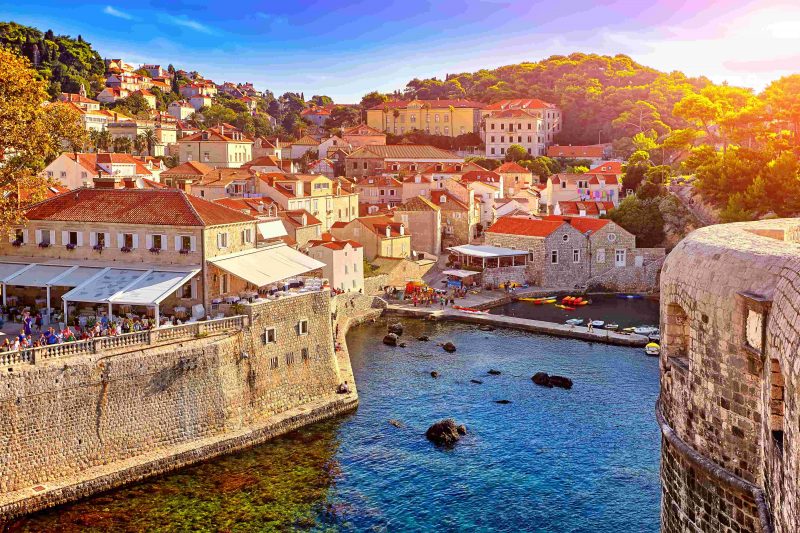
Best Time to Visit Croatia: A Season-By-Season Guide
Croatia is the stuff of dreams for many travelers. The calm, light, turquoise waters of the Adriatic Sea, the stunning pebble beaches on the coast, the acres of vineyards, and the centuries-old Medieval towns all make Croatia one of the most interesting and charming countries in Europe.
This small country stretches out for almost 22,000 miles in total. But don’t be fooled by its size! Even though it is only the 127 th largest country in the world and it only has 4 million inhabitants, Croatia’s landscapes make up for it. It’s hard to find a country with so much natural beauty to offer. Croatia has lakes, mountains, dozens of islands, and pebble beaches. Wherever you choose to go in the country, you’ll for sure be fascinated.
Tourism is on the rise as more people think that now is the best time to visit Croatia. But the country has a long history of enchanting travelers with its natural gems. The Romans built summer villas on the coast of Croatia and came here for the perfect get-away from their ruling the Empire. People from the entire Balkan peninsula have been coming here for centuries to bask in the warm sun of Croatia. And now people from all over to world visit this small country in the Adriatic Sea!
It has never been easier to get to Croatia and have the vacation of your life here. Airlines from Europe and the United States fly more often to one of the country’s airports, hotels have been completely renovated to embrace the modern times, and the roads connecting all the cool and once-inaccessible points of the country have been improved.
If you’re planning a summer, spring, fall, or even winter vacation, it’s time for you to explore Croatia! To help you decide when is the best time to visit Croatia, we’ve put together this Croatia travel guide for you.
Weather in Croatia
When deciding when the best time to visit a country is, the weather will probably the first thing you’ll think about. No one wants to plan a beach vacation and then realize it will be raining and windy for most of their trip.
To help you avoid these annoying vacation-ruining mistakes, we’ve put together this local travel guide. It tells you how the weather typically is in each region of Croatia, what are the best months to visit a certain location, cultural events going on in the country during certain months, and when to catch the best travel deals. We’ll help you figure out when the perfect time to go to Croatia is for you and help you figure out what to pack with you!
In the Adriatic Coast…
The Adriatic coast is one of the many reasons people book their trip to Croatia — and for good reason! It boasts the best climate in the entire country, one similar to that of southern European countries: Mediterranean.
Winters in the coast of Croatia are nowhere near as harsh as they are in Central Europe, for example. The southern Croatia coast has been blessed with mild winters temperature-wise but a lot of rain. January and February are the coldest months in the coast. During the day, you can expect temperatures of 11 and 12 degrees Celsius (between 52 and 54 degrees Fahrenheit). During the night, however, the temperatures drop to only 5 and 6 degrees Celsius (between 41 and 43 degrees Fahrenheit).
But despite the temperature not being that low, the so-called bora takes tourists by surprise. This is one of the strongest-blowing winds in the world. It’s so strong that it sometimes closes down bridges and coastal roads!
The summer months are the best time for a perfect holiday on the beach. The temperatures rise to a whopping 30 degrees Celsius (86 degrees Fahrenheit) and even higher during the day! The nights are much cooler and just right to go for nightly walks or go our partying to bars and clubs. You won’t see the temperatures drop below 20 degrees Celsius (or 68 degrees Fahrenheit), not even in the wee hours of the morning.
There’s a good reason why so many people love going to the beach in the summer in the Adriatic Coast. During this season, the sea is warm and it’s common to see the water temperature rise to 24 degrees Celsius (or 76 degrees Fahrenheit) — very inviting for a swim! To top it all off, there are only, on average, 6 days of rain during the entire summer and a whopping 11 hours of average daily sunshine. What more could you ask for when you plan a beach vacation?
Both spring and fall are the “middle” seasons. They’re not as cold nor as rainy as winter, but they aren’t warm and sunny all the time like the summer months are.
In the north…
The climate in the lowlands around Zagreb, in the northeast, and in the east of Croatia is much different from that in the coast. This part of the country has what is known as the Continental climate, meaning that it’s similar to that in Central Europe: the seasons are very pronounced and very different from one another.
In the winter months, the temperatures usually plummet down to 2 degrees Celsius (35 degrees Fahrenheit) during the day, and at night, it’s not unheard of for them to drop below freezing. This makes this part of Croatia a great ski resort as the white, light snow falls down hard during the coldest months of January and February.
Summers, on the other hand, are much more pleasant! During the day, the temperatures usually reach 27 degrees Celsius (80 degrees Fahrenheit) and even go above it. While nights are somewhat cooler, they’re perfect for strolls as the area isn’t known for strong gusts of wind. Another great thing about the summer is that it’s dry, unlike winter. You will most likely not see any rain during your stay in the northern and eastern parts of Croatia.
The months of spring and autumn are always a surprising in-between and mix of the two seasons. It’s neither too hot nor too cold but there aren’t as many sunshine hours or as many days of clear sky.
In the Center…
The mountains in the central part of Croatia, known as the Dinaric Alps, has what’s known as an alpine climate. While on the other side of the mountains, sunshine and mild winters bless the Adriatic Coast, the Dinaric Alps have cool summers and cool winters.
During the winter, temperatures drop drastically to 5 degrees Celsius (40 degrees Fahrenheit) during the day and to below freezing at night. It’s not unusual for the nights to be very chilly — the thermometers often plummet to -3 degrees Celsius (or 26 degrees Fahrenheit).
Summers, on the other hand, are much more enjoyable. They’re not nearly as hot as the summers on the Adriatic Coast, perfect for people who don’t want to get heatstroke. You’ll likely see forecasts of 24 degrees Celsius (75 degrees Fahrenheit) during the day — or even higher — and of slightly less at night. The cool summer breezes in this mountainous region make being outside much more tolerable than near the coast.
Finally, the spring months (March, April, May) and the fall months (September, October, November) are an interesting mix of the summer and winter seasons. There can be quite a bit of rainfall in the area as well as mostly cloudy days. You also won’t find the warm summer days during these months either.
Winter Months (Dec, Jan, Feb)
As we’ve mentioned, the weather during the winter months can be quite different from place to place in Croatia. But the one thing all of Croatia has in common is that it sees its fair share of extreme weather.
The months of December, January and February are great months to go to Croatia if you want an off-peak season winter adventure.
Festivities lovers will adore Croatia during mid- to late-December. People in Croatia go all out to celebrate their holidays, and Christmas has to be the biggest one. Despite the weather being cold and rainy, you’ll still have a blast in any of the biggest cities of Croatia.
Dubrovnik comes alive during the Christmas festivities. Every year, the main tourist attractions (Peskarija, Stradun, Pile, and Lazareti) are lit up with scenes from the nativity to dazzle spectators. This celebration is part of the fun and exciting Dubrovnik Winter Festival that lasts the whole month of December and a fraction of January. There’s no describing just how beautiful the city becomes! And, since it’s not that cold during the day, why not walk around the Dubrovnik wall ruins? You’ll most likely have them for yourself and they make for a perfect scenic view of the city.
But Zagreb is the city that has the most Christmas events going on in December. Being the capital, it’s no wonder that the celebrations are even more intense here. Every year leading up to Christmas there are markets set up in the city’s squares. One of the best travel tips we have for you is: visit a Christmas market, try some local delicacies, have a hot drink to warm you up, and follow the Christmas lights across the historic city center! We believe this really is the best time to visit Zagreb, Croatia without going over-budget or bumping into crowds wherever you go.
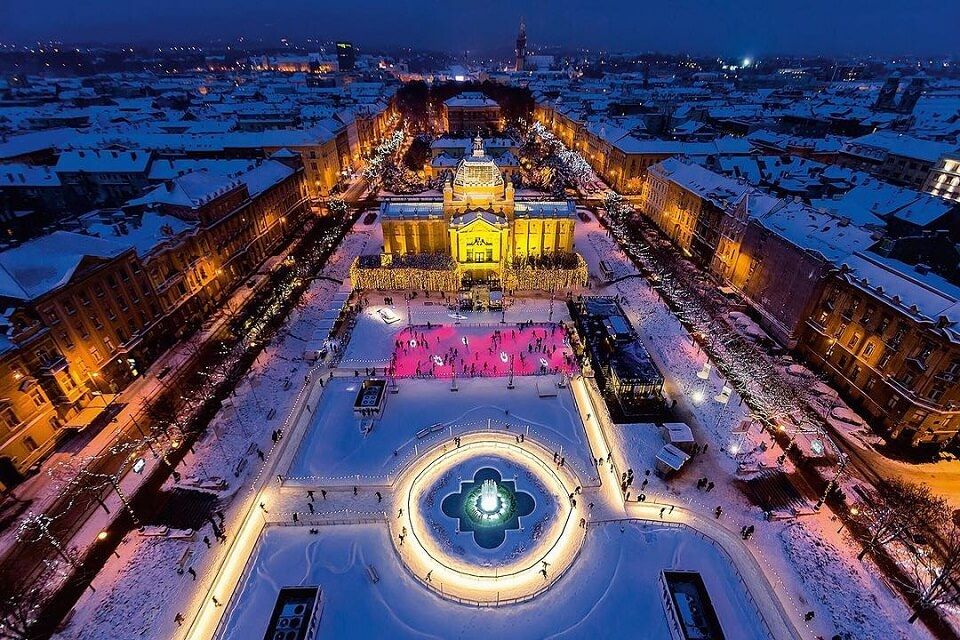
Another great month to see Croatia for city breaks is January. You can still feel the holiday spirit but the month is also the right time to avoid crowds. Because of this, it’s also one of the best months to go to Croatia if you’re on a budget, as you’ll find cheaper flights, accommodation, and other amenities.
Early January is, of course, marked by the New Year craze. Walking around the biggest cities of Zagreb, Dubrovnik and Split, you’ll still see Christmas decorations and feel the Christmas spirit in the air. This is also the time when stores have the biggest sales, which is perfect for shopping addicts.
Toward mid-January, most of the crowds have gone home. This is the ideal time to visit the city without running into hordes of tourists. You can walk along the ancient city walls of Dubrovnik and take in all the beauty of the city.
If you’re a fan of ski, you’ll already know that the Snow Queen Trophy is fought every January in Croatia. People flock down to Sljeme in the north of the country to see world champions compete for the coveted prize.
Since you’re in Sljeme, why not try to ski yourself? The Sljeme Ski Resort is only 15 km north of Zagreb and has great slopes even for beginners. There are five slopes in total, ranging from beginner-friendly to hard, and three lifts. The slopes have around 4045 meters in length (a little over 2.5 miles). This is where Olympic-gold-medalist Janica Kostelić learn how to ski!
Another thing you’ll love about visiting Croatia in January is the annual Night of Museums event. For once night a year (usually the last Friday in January), the entrance fee to all museums is waved. What better time to visit the Glass Museum in Zadar, the Museum of Broken Relationships in Zagreb, or the Museum of Croatian War of Independence in Dubrovnik?
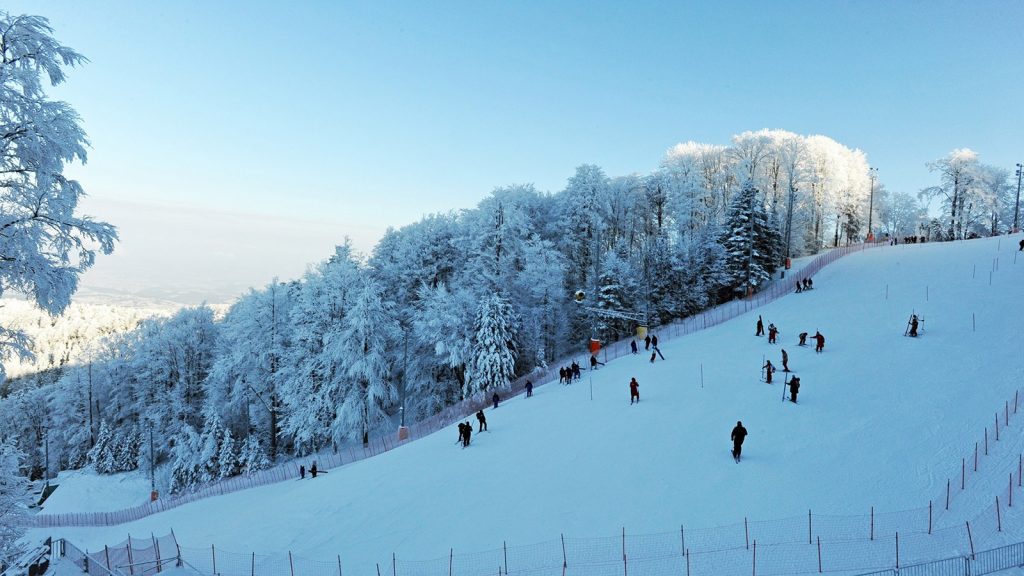
If you love partying and immersing yourself in local folk culture, you’ll love Croatia in February.
February is known for being the best month to enjoy the world-famous Rijeka Carnival. This festivity starts in mid-January and it runs until early-March. As you can see, the celebrations go on for a whopping three months as this is the largest Carnival in all of Croatia. Rijeka is a beautiful port town on the Adriatic Coast. During any other time of year, it might look like any other 19 th -century European town — but not during the Carnival. People dress up in colorful costumes, organize parades, create large cars completely adorned, and laugh a lot.
The Festival of Saint Blaise is another important and interesting happening in Dubrovnik. Saint Blaise is the patron saint of the city has its celebrations have been going on every year since the year 972. If you happen to be visiting Dubrovnik when the festivities are going on, you’ll most likely see mass processions and the relics of Saint Blaise. It’s a great insight into what religious and spiritual life is like in Dubrovnik.
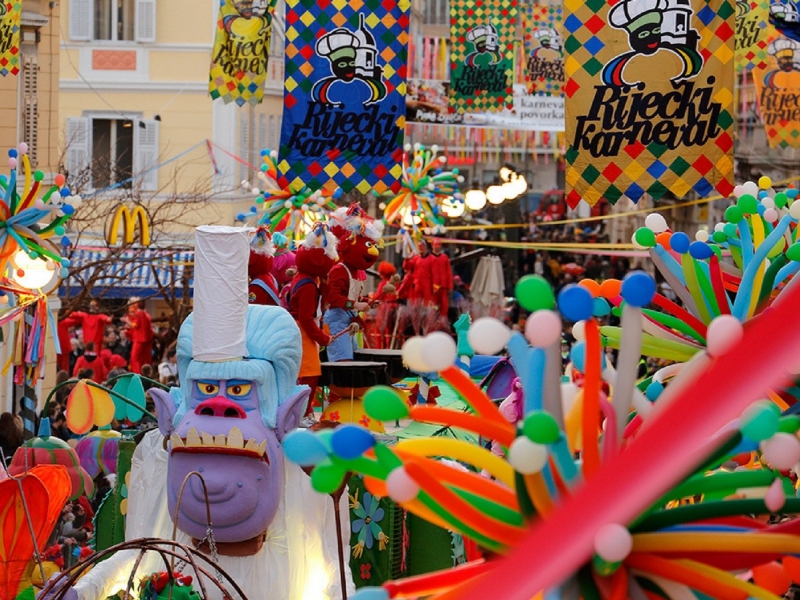
Spring Months (Mar, Apr, May)
When spring comes, so does all the life that went to sleep during the three months of winter in Croatia. If you’ve never visited the country, now would be a great time to. The flowers and plants all start to bloom, and the snow starts to melt in the mountainous region and in the north.
The spring months of March, April and May are good months to organize your trip on a budget. You should find cheap flights to Croatia and enjoy the relatively cheap accommodation options — especially in Dubrovnik, Split, and Zagreb.
March is a great month to visit otherwise-packed tourist destinations. The main cities, in particular, are perfect this time of year. Because it’s not the right time yet for a beach holiday, there are very few tourists in the country in March.
Take advantage of this by going on a city break in Croatia in March. We’ve already mentioned how beautiful both Zagreb and Dubrovnik are, but it’s never enough. These towns are extremely old and have so much history behind every single piece of stone. But there are many more cities worth exploring in Croatia. Split, for example, is one of them.
Split is a town on the Dalmatian Coast, Adriatic Sea. The city has been on this exact place since the 4 th century, when Roman Emperor Diocletian erected a fort here. Even after all these centuries, you can still see and visit this palace! The palace hugs the city of Split where you can find a multitude of courtyards, Roman ruins, houses, hotels, cafes, shops, and even bars. Because of its location, March here isn’t very cold, certainly not as cold as most of Europe is at this time of year!
Another fascinating event not to be missed is the Zagreb Festival of Lights. For a week in mid-March, Zagreb is home to a spectacular light-projection show. The historic center of the city is lit up with audio-visual installations. Think of 19 th -century buildings with gorgeous and massive façades being the background for the projection of stories told entirely through light and music — amazing, right? Every year, the theme is the same: renaissance. The event takes place in March for this exact reason too. Since March symbolizes the awakening from the wintery sleep and nature and cities come back alive again during this month, the light shows also make the buildings come alive. If you’re in Zagreb, make sure not to miss the viewings from 6 p.m. to 9 p.m.!

While Croatia isn’t warm yet and only really brave people can go for a swim in the Adriatic Sea, there’s still plenty to do in April. You’ll especially notice how green and colorful everything is. After all, this is when spring is in full swing!
April is a great time of year to do a custom-made trip by train or car to explore all the nooks and crannies of Croatia. There is so much to see and April, being a shoulder month, will be easy on your wallet. Hotels and tourist attractions are not yet full, so you’ll feel like you have the country to yourself with no queues and no absurdly high prices.
We highly recommend taking a trip to the Plitvice Lakes National Park. The park is open year-round, but April is when it comes into itself. The waterfalls start to run once more, enchanting all visitors, the mountains are covered in green again, and there are stunning flowers blooming everywhere you look. It’s one of the coolest attractions in Croatia, especially if you’re a nature lover!
Lastly, the weeks between late-April and early-May are the perfect excuse to pay a visit to Croatia for wine lovers. Poreč is a coastal town in the county of Istria that is famous for its amazing wines. The celebrations going on celebrate wine and the region’s lifestyle. Visit this lovely little town and taste the Malvazija wine that they’re famous for producing locally. It’ll warm your body right up!
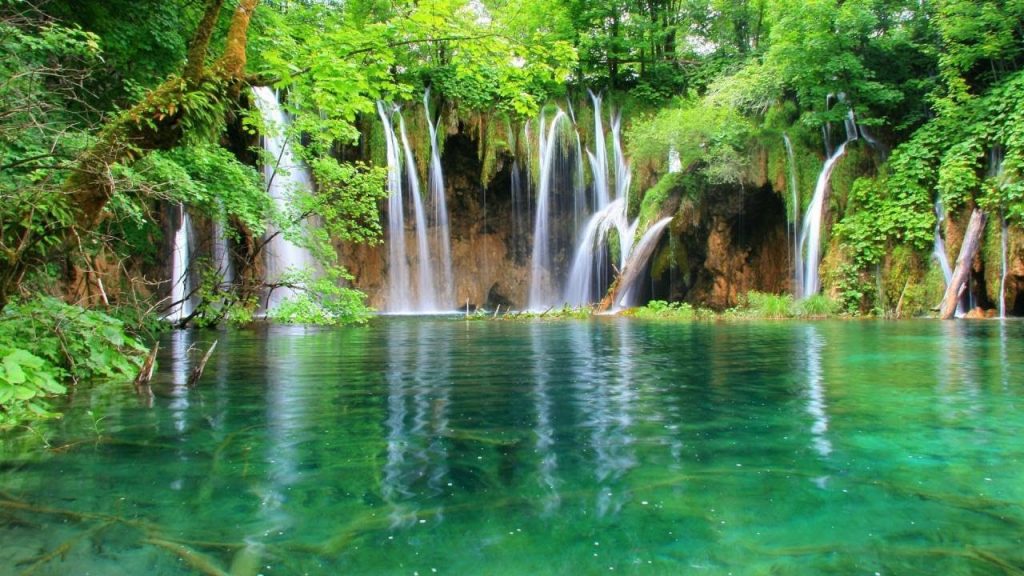
The last month of spring is, in our opinion and according to many travel experts in Croatia, the best time of year to visit Croatia. It’s the very last full shoulder month when you can still take an advantage of cheap accommodation and flights and no hordes of tourists.
This is the perfect time to take a ferry to the Island of Hvar and enjoy the island for what it is: a gem in the Adriatic Sea with unparalleled architecture. The winding, narrow streets and amazing weather during the shoulder and summer months make Hvar island a hotspot for partiers.
If you want to get away from the party scene, May is a great month for venturing more inland. The towns of Jelsa, Stari Grad, and Vrboska will give you a whole new perspective of life in the Dalmatian villages.
Another great holiday in Croatia in May is going up to the mountains. Sure, the weather is still a little chilly and you’ll need a coat and maybe a scarf, but nothing beats the fresh air of the Croatian mountains. If you want to get in touch with nature and take a break from life back home, then May is the month to travel here.
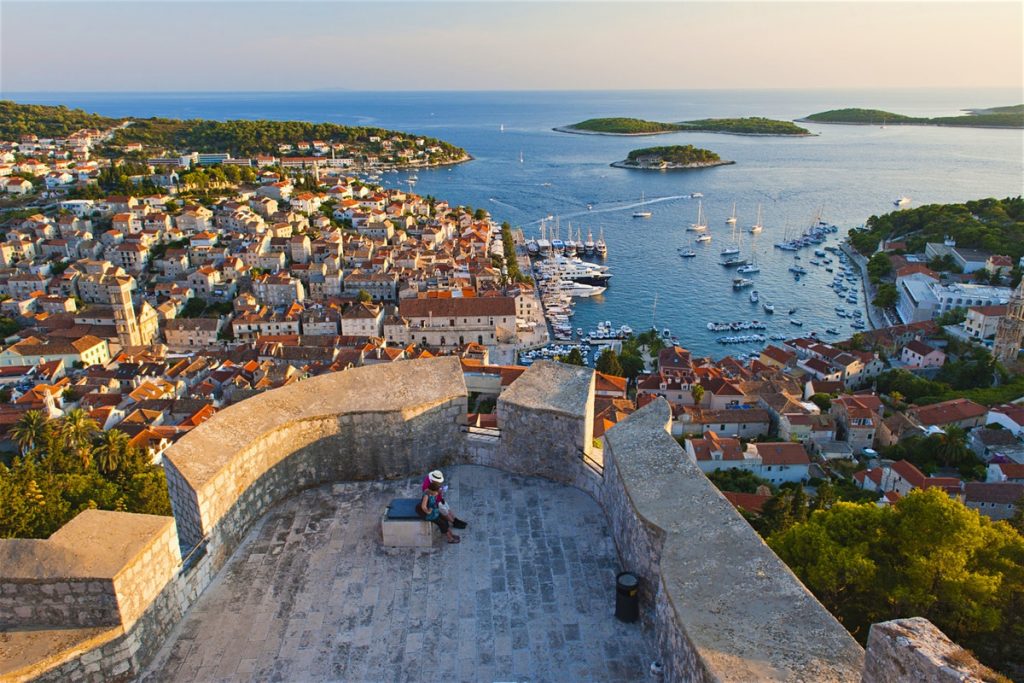
Summer Months (Jun, Jul, Aug)
Everyone knows that June, July and August are the peak season in Croatia. The temperatures go way up, the sun shines almost non-stop for the 11 hours of sunshine every day, and the Adriatic Sea becomes warm and inviting for a swim.
While June, July and August have the best weather, this is also when the cities and beaches flood with crowds of vacationing locals and tourists. This makes all the prices (for plane tickets and accommodation) sky-rocket. If you’re not looking to travel within a limited budget, the summer is the best time to visit Croatia.
If you love music festivals, you won’t want to miss one of Croatia’s largest festivals. INmusic is a summer festival that happens every year for two to three days in a hip neighborhood of Zagreb, Jarun. This once-peaceful neighborhood that’s full of nature comes alive when hundreds of thousands of festival-goers flock here. The billboard is always dominated by big international names, such as Queens of the Stone Age, David Byrne, Nick Cave & the Bad Seeds, Interpol, Portugal! The Man, and many more.
June is also a great time to hit the beaches on the Adriatic coast. The sea is warm after a long winter and spring and ready to welcome beachgoers from all places. You won’t find sandy beaches as you do in Spain, Portugal or Italy, but something much more special. Beaches in the Adriatic coast have large and small pebbles instead of sand. It’s quite an unusual sight if you’ve never been to one of these beaches, but totally worth it.
If you’d rather go more mainland, June also has you covered. June is the month when the lavender fields the country has are in full bloom. Whether you’re driving along the highway or you’ve chosen to take the train, don’t miss out on the stunning view that is seeing miles and miles on end covered in a deep purple hue.
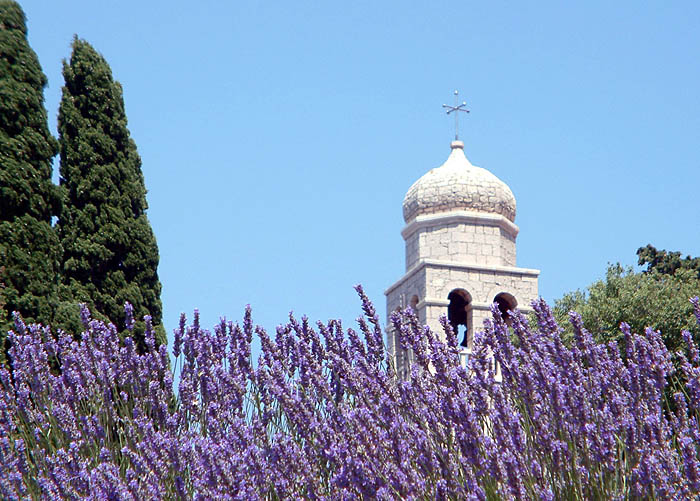
During July, a lot of tourists drive to Croatia from Italy, which can make the cities and beach towns even more crowded. A fantastic alternative to busy cities and villages are the car-free islands of Lopud and Zlarin. For cyclers especially this will be a great trip. They’re not as crowded as other neighboring islands and the weather there in July is absolutely perfect. You can take your bike for a ride around the islands since it’s summer and nature is at its finest.
If you’re into partying, then July is just the month for you, with all its nightlife. The island of Hvar is the perfect example of what the party scene is like in Croatia and the Dalmatian coast. Every night there are clubs where famous DJs perform to thousands of people who dance the night away. Another cool thing to consider when visiting Croatia in July is partying on a boat. There are several party cruises that sail every evening and only come back to shore in the early morning. It’s a great way to meet other travelers who share your love of partying and a chance to chat with a local about the party scene!
Finally, if you’d call yourself a party animal, don’t miss the Ultra-Europe music festival. Split is home to one of the biggest electronic music festivals in all of Europe, and every July without fail the house is brought down by big DJs. Hardwell, David Getta, Afrojack, and Avicii are just some of the many DJs who have liven up the party here in Split during the month of July.
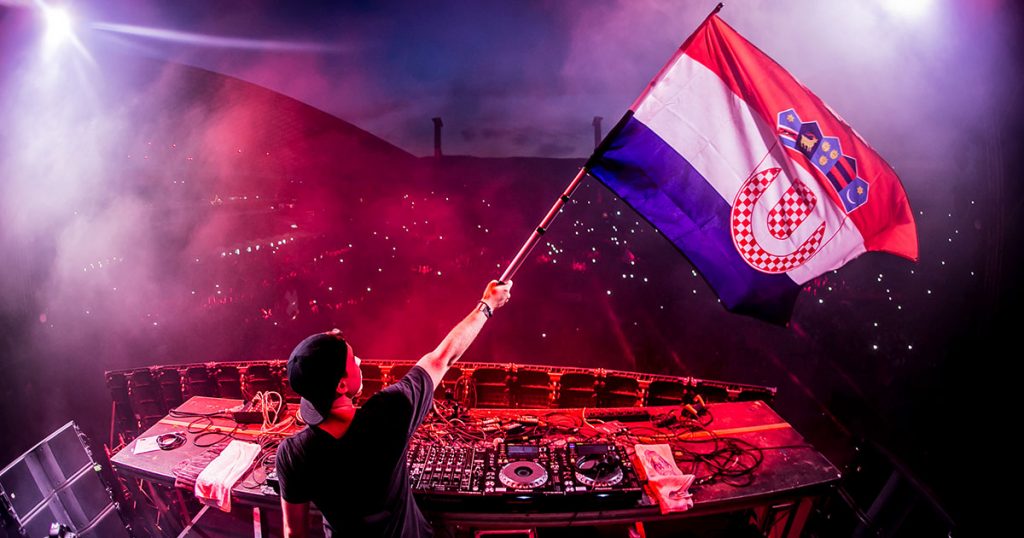
The most peak month of traveling in Croatia is August. The prices of everything are through the roof and the country is crowded, but nothing beats the things Croatia offers in August.
August is the best month to sightsee in Croatia and stay close to the ocean. If you’re visiting the coast, you’ll soon realize just how hot it gets both in the day and at night. This gives you the perfect excuse to go for a swim in the crystalline waters of the Adriatic Sea. Another great way of cooling down is practicing water sports. Croatia has lovely beaches that are perfect for water sports. Snorkeling, speed boating, kayaking to discover the many caves, and jet skiing are all great ways to make your vacation even better.
August also brings with it the Dubrovnik Summer Festival. Art and music displays are spread around the city so that visitors can absorb some more of the local culture before they depart. During the course of six weeks, there are also countless artists performing live, for free, in open air on the streets of Dubrovnik. If you love culture and the arts, we’re sure you’re going to love the Summer Festival.
Finally, there is yet another festival blesses Croatia. In the Dalmatian coastal city of Zadar, there is a festival every year dedicated to foodies. Local traditional and modern cuisine are put on display for all to savor. It’s the best opportunity you’ll get to experience local delicacies, such as figs, countless types of cheeses, and the best seafood you’ll have in the Balkans. During this festival, the island of Riva gets completely transformed. The small boats are used as ambulant markets of the freshest ingredients grown or caught in the region.
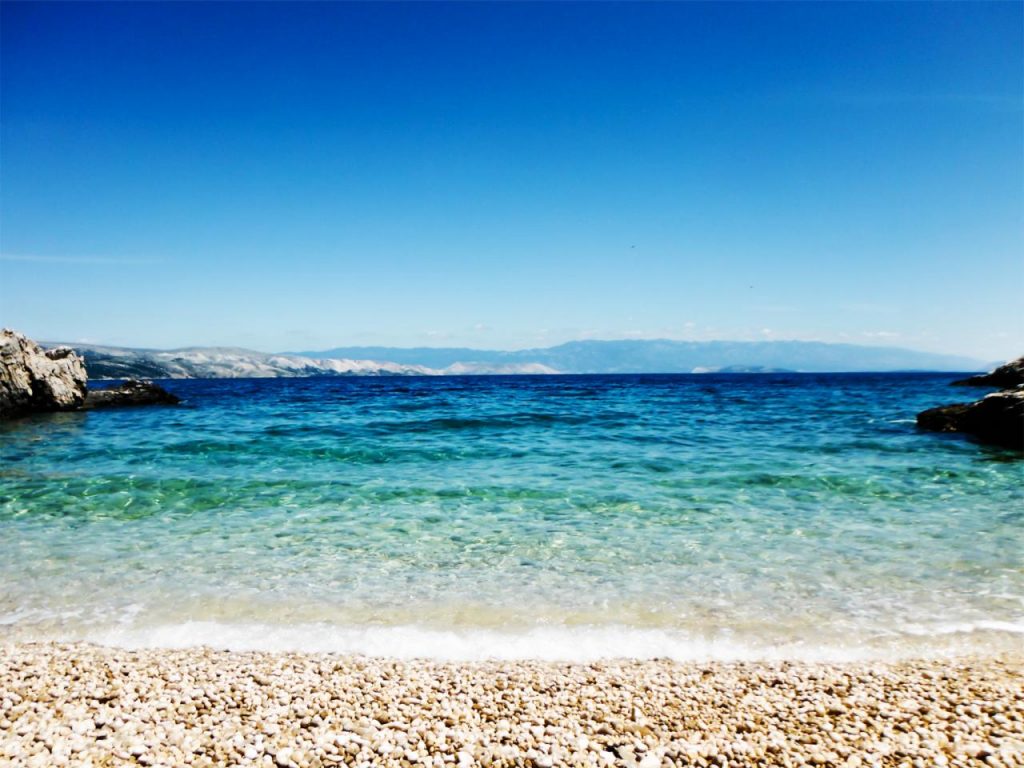
Fall Months (Sep, Oct, Nov)
September, October and November are the months when everything starts to calm down in Croatia again. The days become shorter, the temperatures coolers, the days of sunshine fewer, but the cultural events in Croatia keep going strong.
The weather during these months gets progressively colder until winter engulfs the whole country once more. It also means that the hordes of tourists go home and the cities become much quieter. These are what’s known as the shoulder months and they’re the best time to visit Croatia on a budget.
The month of September is great for exploring Croatia culture-wise. There are dozens of festivals and festivities that celebrate the traditions of all regions of Croatia.
In the town of Poreč, there’s a festival dedicated to history for three days during September. People dress up in Baroque-style costumes and try to mimic to the viewers what life was like back then. The festival, known as Giostra, is the perfect chance to learn all there is to know about Croatia in the 18 th century. There is even a knight tournament that is held at the end of the celebratory period that perfectly replicates the ones from 1745!
If you’re a film buff, you’ll love hearing that the Split Film Festival takes place in September. This is an international film competition that lasts a total of one week and gathers some of the most innovative and interesting film directors in all of Europe.
Finally, the Food Film Festival that is held in Zagreb in September mixes two fan favorites: food and films. Over the course of a week-and-a-half, the movies shown in several Zagreb theaters focus on gastronomy. If you’re both a foodie and a film buff, you won’t want to miss out on the Food Film Festival in September.
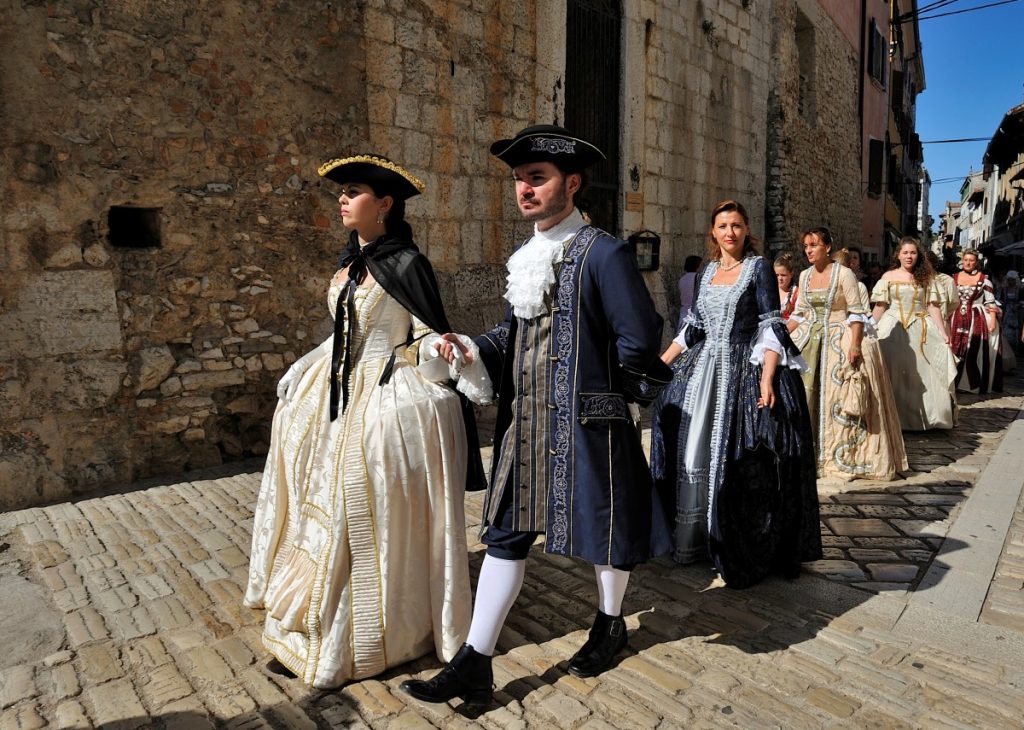
October in Croatia is as close to the saying “getting back to the roots” as possible. All the crazy of tourism has come and gone and now only locals can be seen wandering around the major cities and going about their lives in rural towns.
The month of October is when grapes start being harvested to be later turned into famous Croatian wines, such as Plavac Mali. The fact that in rural areas it’s time to harvest all the crops makes October a great month to go on a self-drive tour by car through the countryside.
In Istria, there’s another food festival that blows foodies’ minds away. The Istrian Truffle Days showcase the best truffles the Balkans have ever seen. Restaurants in this area take the local truffles and incorporate them into dishes to make them great. Try having a truffle omelet, a truffle risotto, and a truffle salad for a great price and dive into the local gastronomic culture! It’s also the perfect time to visit Livade and Motovun, two beautiful towns close to the Slovenia border.
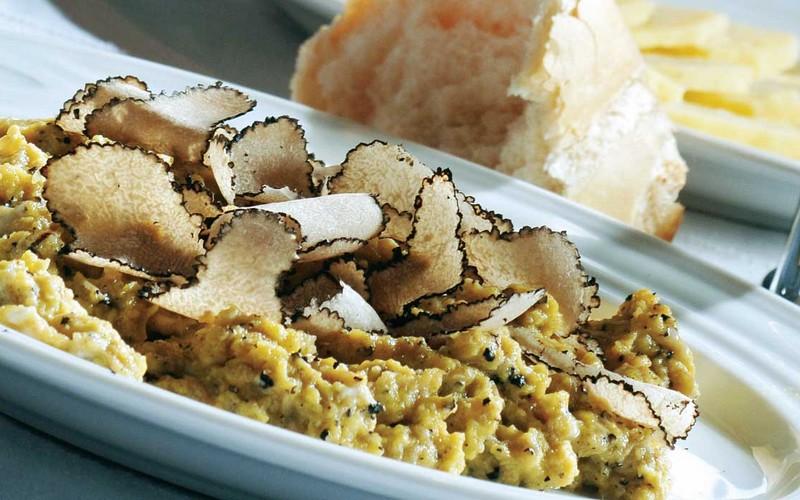
In November, the weather has become wet and cool. This makes traveling in November somewhat unpleasant if you were planning on being outside. However, it’s the perfect chance to dive head first in the Croatian cultural scene.
Saint Martin is a holiday celebrated in many European countries on November 11. It has religious roots but nowadays it’s more of an excuse for people to drink warm wine and eat chestnuts and sweet potatoes. The dish of the day if goose, which is slaughtered and roasted all in the same day. The towns of Tar, Vrsar, and Buzet are the places to go if you want to live this day to the fullest.
November 1 st is All Saints Day in Croatia, yet another religious holiday. But this one is lived with much more attachment to religion. On this day, people go to their loved ones’ graves to place flowers and candles as a symbol of their love. If you’re interested in finding out more and seeing a Croatian cemetery, try visiting one when the commotion dies down. But don’t forget: always be respectful — this holiday means a lot to Christian Croatians.
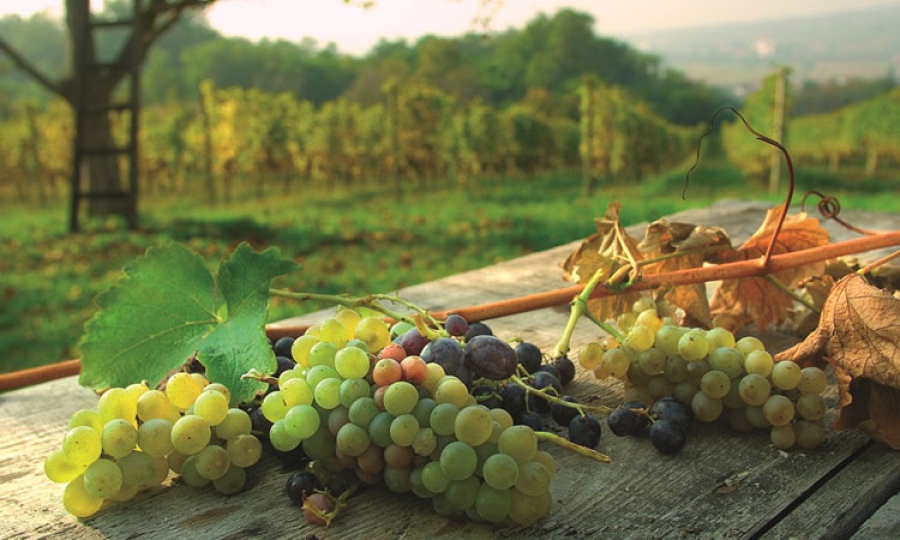
Frequently Asked Questions about The Best Time to Visit Croatia
When is the best time to visit dubrovnik, croatia.
You’ll get the best picture of Dubrovnik during the shoulder months of May and September. The weather isn’t bad at all and you’ll actually get to move around in the city without bumping into other tourists.
What languages are spoken in Croatia?
The only official language in Croatia is Croatian. While not everyone speaks English, especially not the older generations and people in small towns, you can still get by relatively easily using English and by learning a few Croat words.
What is the currency used in Croatia?
The Croatian Kuna is the official currency of Croatia. But because the country is part of the European Union and is used to a heavy influx of tourists, some places in the major cities accept Euros and American Dollars as well.
Recent Posts
- The Ultimate International Travel Checklist
- Passport Book vs Card Comparison
- Top 15 Fun Things to Do in Las Vegas for Couples
- Top 21 California Coast Road Trip Stops
- Best Beaches in Panama
- Adventure and Backpacking
- Central America
- Family Trips
- North America
- South America
18 things you need to know before visiting Croatia

Mar 17, 2024 • 7 min read
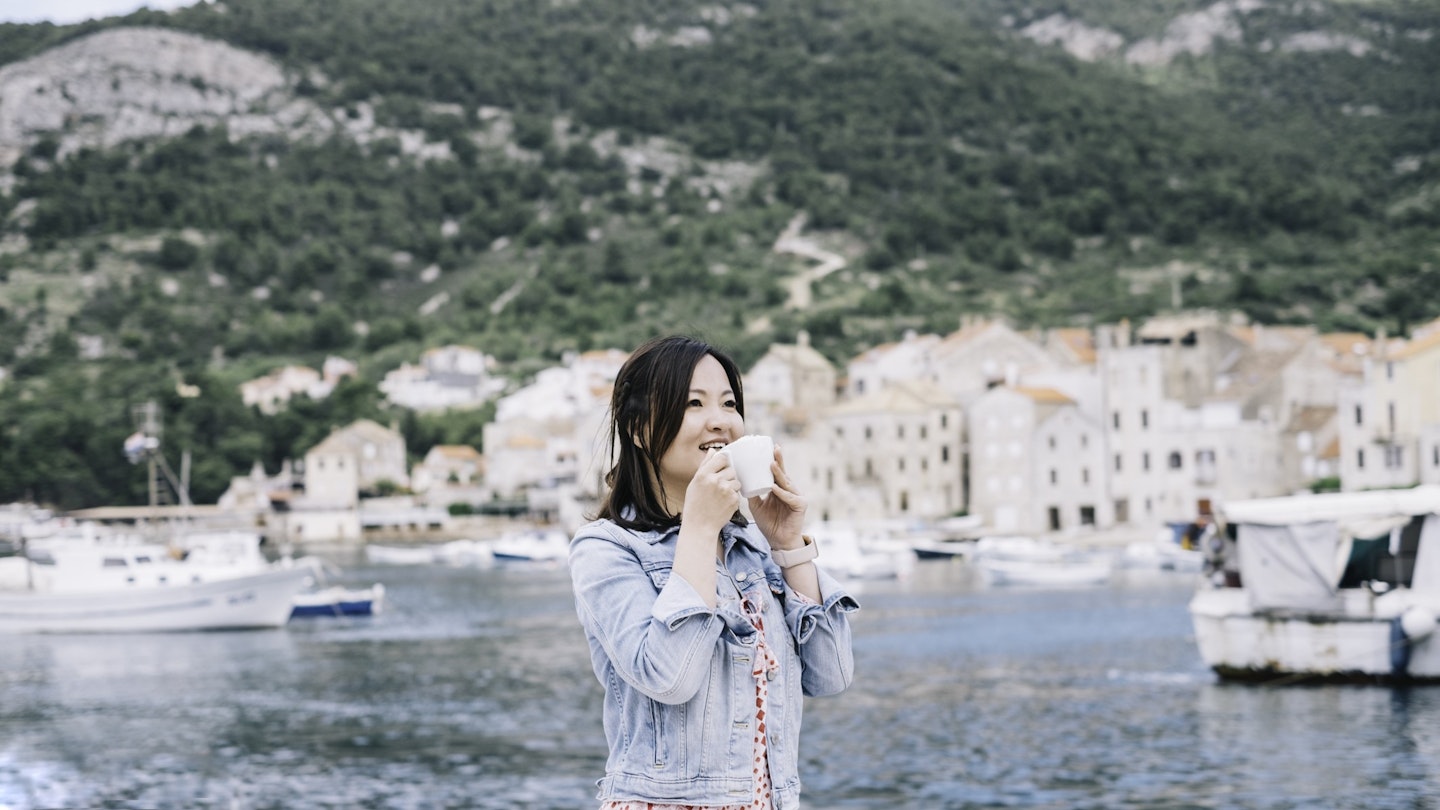
Plan the perfect Croatia trip with these top tips © TerryPrince / Getty Images
With its glittering coastline, 1244 islands, endlessly fascinating cities and extraordinarily dramatic landscapes, Croatia has been steadily making its way up people’s must-go lists.
Naturally, tourists are drawn to those beautiful Adriatic beaches that easily hold their own against their Mediterranean rivals. But inland Croatia is just as captivating, from the hilltop villages of Istria to the elegantly buzzing capital, Zagreb .
Don't book your flights just yet though – first, make the most of our planning tips covering everything you need to know about health, safety and etiquette before you go.
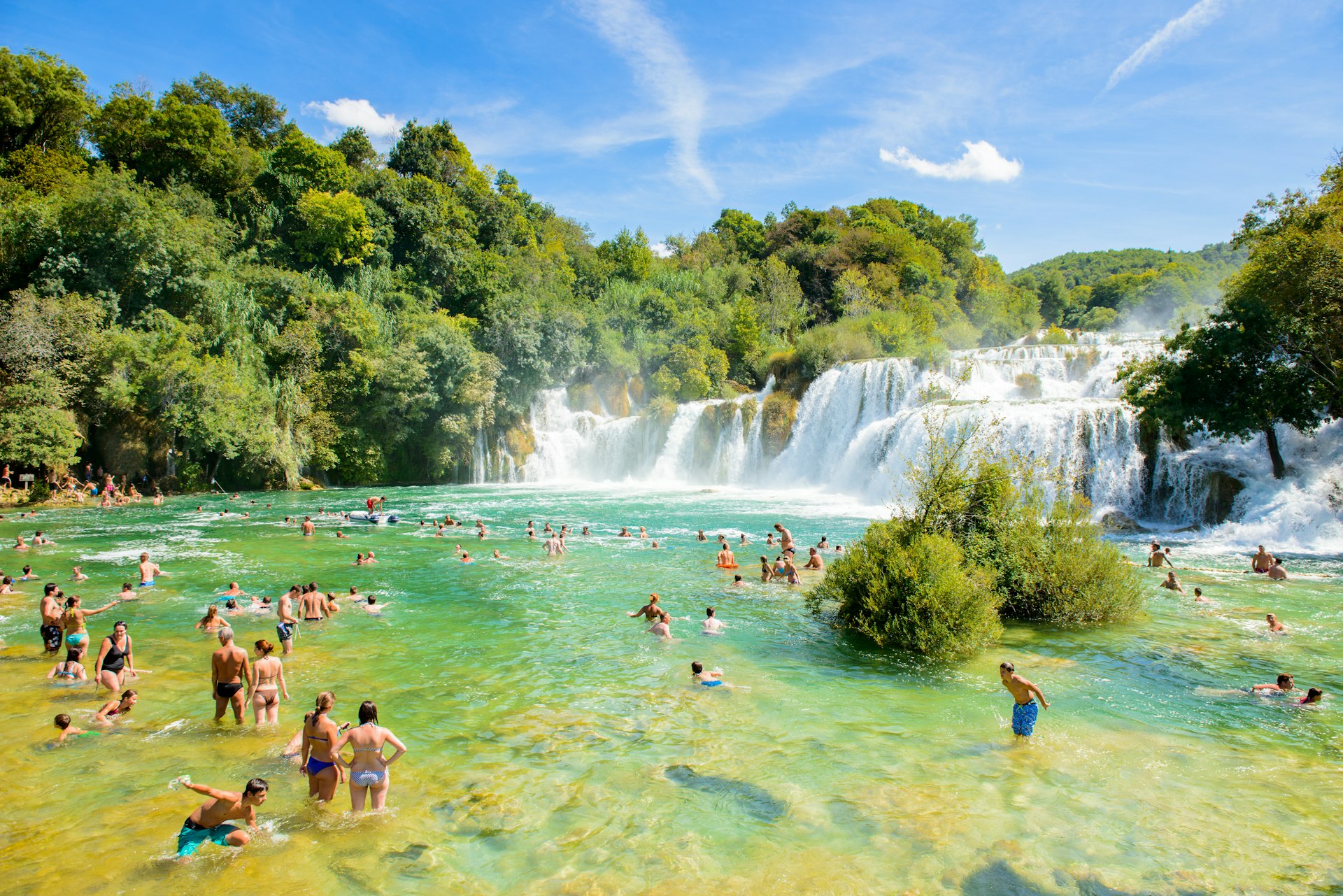
1. Don’t overstretch yourself when planning an itinerary
It might be tempting to squeeze in as many destinations as possible into one trip, but you won’t be doing yourself any favors unless you’re staying for at least two weeks. If you’re planning to visit more than one Adriatic island, think realistically about how much time you can spend in each place and how you will be getting around .
Check the schedule of the national ferry operator, Jadrolinija , if you intend to do some island-hopping. Croatia has an extensive bus network, but factor in some long journey times if you’re traveling along the Adriatic coast.
2. Croatia's currency is the euro
Although Croatia joined the EU in 2013, the euro was only introduced as the national currency on the January 1, 2023. The Croatian kuna is no longer in use, and if you happen to have any of the old currency, you'll need to go to the Croatian National Bank to exchange them.
3. Expect to tip at least 10% in restaurants
Croatia’s tipping culture is more laid-back than in other countries. Having said that, it’s customary to leave at least 10% in restaurants and for beauty and spa treatments. In bars and cafes, just round up the bill. Tour guides appreciate a few euros at the end of a tour, and taxi drivers don’t expect a tip, but, again, if you want to round up a fare to the next euro, it’s appreciated. If you’re filling up your car and notice a few students cleaning car windscreens, consider giving them a couple of euros as they’re working for tips only.

4. Croatia is generally considered a safe place to travel
Croatia is a safe country with low levels of violent crime. The most prevalent issue for tourists is pickpocketing, but even that’s on a much lower scale than in other European countries. Solo women travelers should be safe on their own, although it’s wise to ask your accommodation provider if there are any areas in the vicinity that are best avoided. When using taxis, all travelers should make certain they’re using a licensed car either from an official taxi rank or ordered from your hotel. Uber operates in most major towns and cities, including Zagreb, Dubrovnik and Split .
5. Some caution is recommended for LGBTIQ+ travelers
In this relatively conservative country, homosexuality is tolerated, but LGBTIQ+ travelers should be discreet. Public displays of affection could raise a few eyebrows, and some travelers have experienced hostile reactions. Zagreb’s gay scene is growing, however, and both Zagreb and Split hold Gay Pride festivals every June.
6. Bring some swimming shoes
Most of Croatia’s beaches are pebbly or rocky and can be hard to enjoy in bare feet. Just pick up a pair of those neoprene or plastic swimming shoes you see in all the resorts, and you’ll also be protecting your feet from sea urchins that lurk under rocks and pebbles.
7. Nudity at the beach is pretty standard
Naturist beaches are popular in Croatia, and sometimes you won’t know you’re on one until people start stripping off. Most are marked with FKK – the German phrase “Frei-Körper-Kultur,” meaning free body culture – which isn't surprising as Germans make up some of the biggest numbers of tourists in Croatia. Away from the FKK beaches, topless bathing is quite common.
8. Dodge the crowds in Dubrovnik by timing your visit carefully
There could be times when up to 8000 cruise ship passengers might descend on Dubrovnik in one day. That’s the cue to stay away from the Old Town within the city walls until they leave in the late afternoon. Keep an eye on the Dubrovnik Port Authority’s website for cruise arrivals and the online crowd monitoring system that predicts the numbers of visitors.
9. Wi-fi is readily available
Croatia is part of EU roaming, which is handy if you have a contract that allows you to use your data abroad. It’s easy to find wi-fi in cafes and bars – just ask the server for the password ( šifra ).
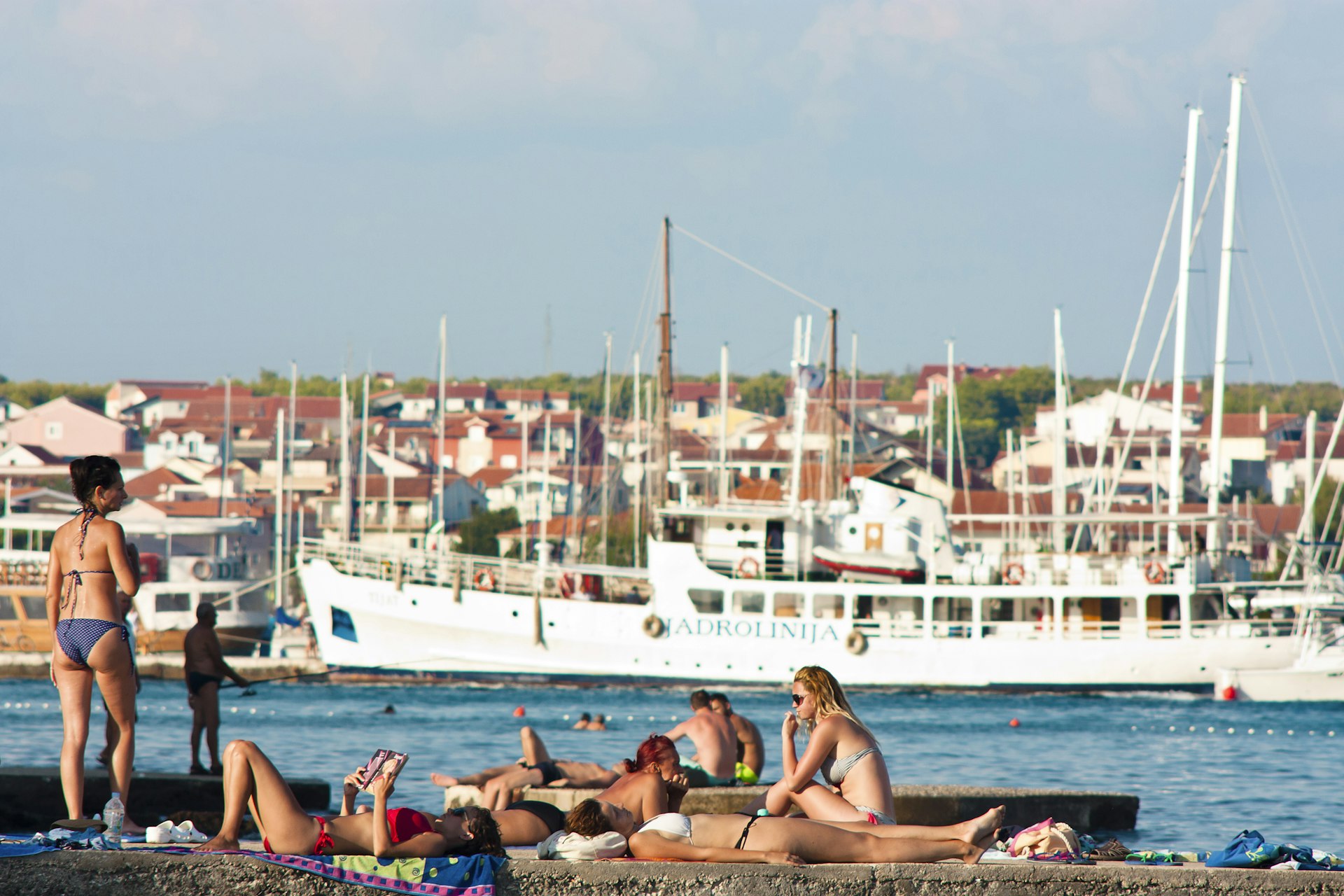
10. Swimwear is for the beach, not the town
If you’re visiting churches and other sacred sites, keep your shoulders covered and avoid bare thighs. If you’re wearing a hat, take it off when you’re in a church. Even though dress codes are relaxed on the coast, Split, Dubrovnik and Hvar have passed laws against walking around the city in swimwear or bare-chested. Croatians like to dress smartly and take great pride in their appearance, so do as they do and avoid looking scruffy.
11. Don’t get drunk in public
Croatia has developed a reputation as a place to party, which has led to some areas being inundated with badly behaved drunken tourists. After years of enduring this, the mayor of Hvar Town had enough. In 2017, the destination started to issue fines of up to €700 for public drunkenness and things like taking a drunken nap in a public place, such as on a park bench. Split introduced fines of up to €300 in 2023, placing signs in the city center reminding people that public drinking is not allowed, and that no one should be urinating on the walls of Diocletian's Palace .
12. Get to know the Croatian character
Croatians can be quite reserved people, sometimes appearing brusque. It’s nothing personal, which you'll realize when you get to know them better, and the initial reserve melts to reveal a warm and friendly side.
13. Be tactful when talking about Croatia’s war of independence
The 1990s war that splintered the former Yugoslavia is a topic that needs careful handling. If people show a willingness to talk about it, then by all means ask sensible questions. But don’t be intrusive, and bear in mind that Croatians won’t take too kindly to being called either Yugoslav or Balkan. Similarly, in this predominantly Catholic country, be mindful of making loud statements against religion.
14. You can drink the tap water
Tap water in Croatia is perfectly safe and very drinkable, and you can refill your reusable water bottles at public drinking fountains.

15. Keep your lights on if driving during winter months
If you’re driving in Croatia from November to April, it’s compulsory to have your lights on during daylight hours as well as at night.
16. Croatia has occasional earthquakes
Croatia has a history of earthquakes going back centuries, but two recent ones in 2020 caused significant damage. The quake that shook Zagreb damaged thousands of buildings, many of which are in the old town, including the cathedral. Soon after, the city of Petrinja, about an hour’s drive south of Zagreb, was severely damaged in a quake, and aftershocks rippled throughout the region. If an earthquake happens while you're there, follow local guidance.
17. There are still some landmines
There are still parts of the country in the hinterlands of Northern Dalmatia and Lika where landmines remain from the war of independence, but these will be signposted with a skull and crossbones symbol. Don’t go anywhere near them.
18. Take out travel insurance
Dial 112 for general emergencies, 192 for police, and 194 for an ambulance. If you fall ill in Croatia and you're an EU citizen with a European Health Insurance Card (EHIC) or a UK citizen with a Global Health Insurance Card, you’re entitled to a vastly reduced price for health care . But even with this cover, you should still take out travel insurance.
This article was first published May 17, 2022 and updated Mar 17, 2024.
Explore related stories

May 28, 2024 • 8 min read
See the highlights of Croatia with this week-long itinerary, perfect for first-time visitors.

Apr 27, 2024 • 5 min read

Apr 19, 2024 • 10 min read
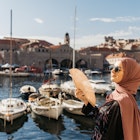
Mar 20, 2024 • 11 min read

Mar 15, 2024 • 10 min read

Mar 14, 2024 • 4 min read
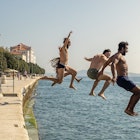
Mar 2, 2024 • 8 min read

Jan 17, 2024 • 8 min read

Jan 2, 2024 • 8 min read
- Best time to visit Croatia
Book your individual trip , stress-free with local travel experts
Select Month
- roughguides.com
- Travel guide
- Itineraries
- Local Experts
- Travel Advice
- Accommodation
Plan your tailor-made trip with a local expert
Book securely with money-back guarantee
Travel stress-free with local assistance and 24/7 support
Figuring out when to go to Croatia goes hand-in-hand with planning an itinerary for your trip. Perhaps you’re hankering after some sun, sea and sand on the beaches of its extensive and glorious coastline and islands . You might intend to explore Croatia’s national parks and take advantage of the plethora of outdoor activities on offer, such as hiking, climbing, mountain biking, sea kayaking and sailing . If so, your trip will be weather dependent. Maybe you’re more focused on soaking up the country’s rich history and culture, in which case you won’t be put off by chillier temperatures or a bit of rain. If you’re enticed by Croatia’s burgeoning festival scene , this takes off in the summer months.
Weather in Croatia
When to visit croatia in spring, when to visit croatia in summer, summer music festivals in croatia, when to visit croatia in the autumn, when to visit croatia in the winter, when to go to croatia for festivals, cultural, traditional, and religious festivals in croatia, music and dj festivals in summer, calendar of events in croatia, travel ideas for croatia, created by local experts.

16 days / from 5341 USD
Gorgeous gems of Hungary, Slovenia and Croatia
From the spas of Budapest to Lake Bled with its castle and further on to Croatia - this itinerary takes you across 3 countries, with a special focus on Slovenia's lake area and the Dalmatian coast in Croatia.

10 days / from 2800 USD
Sailing Croatia
If you want to experience the Dalmatian coast from a whole different perspective, then this trip is for you! Hop aboard a beautiful cruiser and sail along some of Croatia's most stunning islands.

10 days / from 2349 USD
Southern Pearls
This ten-day trip will take you around three adjacent countries, Croatia, Bosnia & Herzegovina, and Montenegro. Your tour starts in Split, Croatia, moving south (hence the name "Southern Pearls") over the island of Hvar and Mostar in Bosnia & Herzegovina to end up in Montenegro.
Chances are you’ll be looking at a combination of these things during your trip. So, for a taster of everything, the best time of year to visit Croatia is early or late summer. You’ll sidestep the hottest months of the season and it’ll be less busy all round.
Inland it’s a climate of contrasts, with sweltering temperatures in mid-summer, and freezing winters. The coast, however, experiences a Mediterranean climate – that is to say, hot in summer, mild in winter. So, if you’re planning to visit Croatia it’s worth taking a closer look at the country’s weather patterns.
Visiting Croatia in March–mid-May
Spring is sprightly by mid-March. It’s warm and dry, which makes it the best time to visit Croatia for cycling, hiking and sightseeing. Also, locals are likely to be particularly welcoming at this time of year – before the tourism season takes off again.
Easter is an important marker on the festival calendar, with religious processions in full swing on the islands of Hvar , Korčula and in many other parts of Croatia. In April, Zagreb hosts the Music Biennale festival (every odd-numbered year), showcasing contemporary classical music by top international artists.
Easter aside, April is also the best month to travel to Croatia for a shoulder season flight at bargain prices, and enjoy a city break.
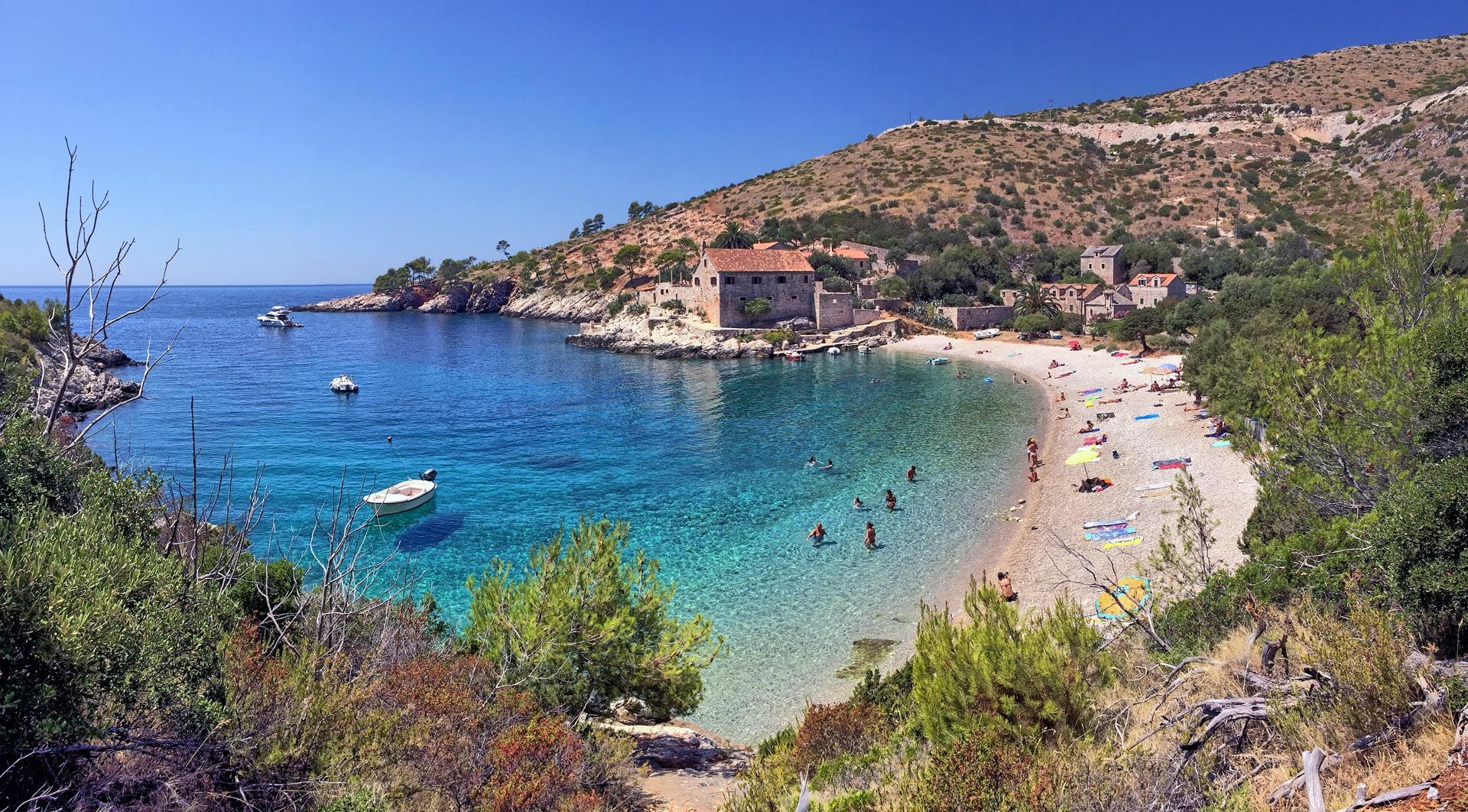
Hopping over to the island of Hvar © Shutterstock
Visiting Croatia in late-May and June
The early summer months are perfect for sunbathing: balmy temperatures lie between 23-27°C on the Adriatic coast, yet beaches are devoid of the crowds that appear as soon as school’s out. And by mid- to late May it can be warm enough in southern Dalmatia to swim in the sea. You’ll also have more stamina for sightseeing – before temperatures soar – and fewer people makes travelling between sights easier. For a smorgasbord of activities, this is perhaps the best time to visit Croatia.
Visiting Croatia in July and August
This is peak season on the Adriatic, drawing foreign travellers, as well as Croats to its sunny sands. And if you like to combine beach action with a buzzing café culture this is the best time to go to Croatia. However, with soaring mid-summer temperatures on the coast (and inland), you may want to limit the amount of sightseeing you pack in.
Island hopping off the coast of Croatia is a big draw. In peak season you’d do well to arrive at ports early to get at the front of the queue for ferries. Also, bear in mind that accommodation soon fills up at the height of summer along the coast and islands, and facilities can be overstretched.
As most head for the coast, cities in the hotter interior of the country are pretty dormant this time of year, with little happening in the way of cultural or social activities. However, the relative quiet is ideal for a trip to take in the magnificent scenery at Croatia’s inland national parks, such as Plitvice Lakes , Risnjak and Northern Velebit.
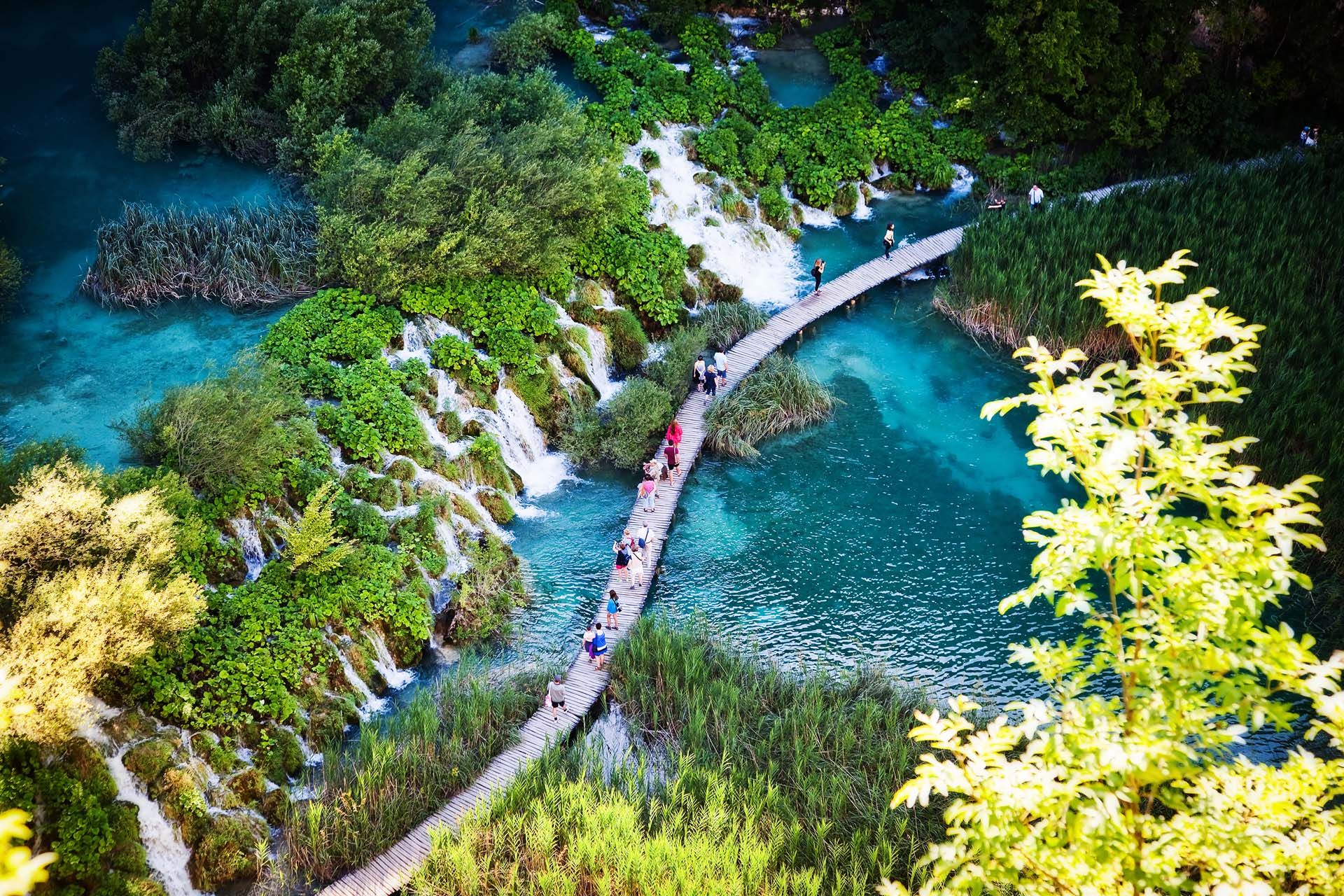
Waterfalls at Plitvice Lakes © Shutterstock
Croatian culture heads for the coast in summer. Almost every Adriatic town organizes a cultural programme, usually featuring outdoor concerts of pop, classical music or folk. And Croatia has quite a reputation for hosting some of the best and diverse music festivals in Europe, which are in full swing by July. Read our summer festivals section for a round up of events, or check out our annual calendar for a full list.
Visiting Croatia in September – November
September is the best month to visit Croatia for weather warm enough for idling on the beaches and swimming in the sea, and for island hopping – without the summer crowds. But the end of the month marks the end of the season and many islands close their bars and restaurants for the winter.

Kornati Islands © Shutterstock
It’s naturally much quieter throughout the country during the autumn months. This is, perhaps, the best time to travel to Croatia to enjoy inland Istria and national park areas, like the Plitvice Lakes and the River Krka . You’ll get to see foliage in full colourful glory and visitor numbers are low.
Come October the temperature of the Adriatic Sea is still warm enough to enjoy watersports, but coastal towns can be very quiet indeed, and many hotels and tourist attractions may well shut up shop for the winter. The cooler temperatures are better suited for pursuing outdoor activities, such as trekking and mountain biking. But don’t forget to pack wet weather gear and a snug extra layer, as it’s a rainier time of year and temperatures noticeably dip.
Visiting Croatia in November – February
Given the innocuous winters on the Adriatic coast, this can be a good time for urban sightseeing in historic centres such as Zadar , Split and Dubrovnik . And budget travellers may find this the best time to visit Croatia for huge savings on hotel prices – over 50 percent on the Adriatic. cheaper than in peak season. Winters inland are a different kettle of fish entirely: snow is common and transport in highland areas is frequently disrupted as a result – though it can also be a picturesque backdrop to sightseeing.
Christmas in Croatia used to be a quiet affair as far as tourism goes, but the wonderful Christmas market in Zagreb has been enticing ever more visitors to the capital over the festive period. It’s a magical scene of cosy candlelight, little wooden huts selling gifts, alongside traditional cuisine and mulled wine, and outdoor concerts.
Dubrovnik comes to life in the first week of February with the Feast of St Blaise festival. Processions and pageantry, concerts and theatrical performances, honour the city’s patron saint.

Winter festival in Dubrovnik © Shutterstock
Croatia offers an increasingly crammed festival calendar, with rock and DJ events, annual beach parties, niche art gatherings and folksy fairs taking place up and down the Adriatic throughout the summer. The bulk of the ‘serious’ cultural festivals take place in Zagreb in spring and autumn. However, Dubrovnik, Split and Rijeka offer a lot in the way of heavyweight drama and music, and almost every region of the country offers a film festival of one sort or another. In addition, the Croatian year is peppered with religious holidays, featuring church processions and celebratory feasting.
So, if you’re wondering when is the best time to visit Croatia for one of its many festivals, here is a selection to help you decide, followed by a full calendar of events.
Please note that the current coronavirus situation means some events may be postponed or cancelled. Check individual events before booking your trip.
This is a selection of the best annual cultural events, including film, theatre, classical music and folk festivals, taking place in Croatia.
- Zagrebdox : International documentary film festival. Feb
- Carnival ((Karneval; fašnik; pust): Processions and masked revelry in towns all over Croatia. Rijeka, Samobor and Velika Gorica (just south of Zagreb) host the biggest events. Climaxes on Shrove Tuesday (or weekend preceding it). Feb/March
- Easter : Processions in many parts of Croatia, especially on the islands of Hvar and Korčula. April
- Motovun : One of the biggest and most popular film festivals. Usually 5-6 days in July/Aug
- Animafest : Animation film festival of high-art seriousness – and post-show partying. June
- Music Biennale : Cutting-edge contemporary classical work. April-Sept; odd-numbered years.
- Contemporary Dance Week : Zagreb; May/June
- Split Summer : Rivals the Dubrovnik Festival for high-culture stakes. Top-notch music and theatre. June
- Rab Fair : Medieval extravaganza, with parades, archery contests, feasting and merriment. July
- International Folklore Festival , Zagreb: Best place to see songs and dances from all over the country. July-Aug
- Dubrovnik Summer Festival : Important classical music and drama event, much of it performed in squares and courtyards of the Old Town. 6 weeks, beginning early July
- Pula Film Festival : Feature films screened in the Roman amphitheatre. July
- Omiš Klapa Festival : The biggest of the festivals celebrating traditional choirs (klape). July
- St Donat’s Musical Evenings : A medieval church and other venues in Zadar host performances by classical musicians. July/Aug
- Kastav Cultural Summer : Include music, art, theatre, film and literary events in the streets and squares of Kastav, near Rijeka. July/Aug
- Osor Music Evenings : Classical music, in historical buildings and squares of Osor, on the island of Cres. July/Aug
- Festival of World Theatre : Performances from leading international theatre companies. Zagreb; Sept
- St Martin’s Day : tasting the first wines of the season – often to excess. Nov
- Zagreb film festival : Promoting new international filmmakers. Nov
- Advent in Zagreb : The best in Christmas markets, with mulled wine, traditional gifts, music, and performances. Dec
Croatia has muscled its way into the European party calendar in a major way. From late June to early September there’s a packed schedule of events, and big-name DJs perform every weekend at the dance clubs along the Adriatic coast.
Please note that the current coronavirus situation means some events may be postponed or cancelled. Do check individual events before booking your trip.
- Hideout : A long weekend of cutting-edge electronic music on Pag island’s Zrće beach. June or Sep
- InMusic : A three-day rock and indie fest at Lake Jarun, Zagreb, with sets from leading international bands and DJs. Late June
- Fresh Island Festival : A week-long bash of hip hop, Afrobeats, R&B and more at Zrće Beach, on the island of Pag. July
- Love International : Electronic music with DJ’s doing their thing, at this dream setting at Tisno on the Adriatic. June
- Ultra Europe : Electronic music festival with leading names takes place in the Park Mladeži stadium in Split. July
- Seasplash : Reggae festival at Martinska pier and beach, Šibenik. July
- SuncéBeat : Spin-off of the UK DJ event the Southport Weekender, this festival celebrates disco, house, soul, and R&B at the Garden site at Tisno. July
- SuperUho : Alternative music and indie-rock at an idyllic shore-side site just outside Primošten. Aug
- Moondance : Big names on the techno scene, as well as underground artists, in Trogir’s historic and atmospheric Kamerlengo fortress. Aug
- Sonus : A long weekend of cutting-edge DJ-ing on Zrće, Pag island’s party beach. Aug
- Soundwave : A long weekend of partying with major international DJs at Tisno festival site. Aug
- Dimensions : Experimental dance music at Fort Punta Christo near Pula. Aug
- Špancirfest : The centre of Varaždin comes alive with performances, pop, rock, and folk concerts. Aug

View over Split © Shutterstock
January–March
Snow Queen Trophy : World Cup downhill skiing on Mount Sljeme, with a big-screen broadcast on the main square. First and second weekends in Jan; Zagreb.
Feast of St Blaise : Processions and pageantry in honour of Dubrovnik’s patron saint. Feb 3; Dubrovnik.
Carnival : (Karneval; fašnik; pust). Processions, fancy dress and festivities in Rijeka, Velika Gorica and Samobor : Shrove Tuesday or weekend preceding.
Zagrebdox : A feast of documentary films from around the globe, with a packed week of screenings. Late Feb/early March; Zagreb.
April – May
Easter : Religious processions on the islands of Hvar, Korčula and in many other parts of Croatia. April or late March.
Music Biennale : Ten days of contemporary classical music featuring new work by major international composers. Every odd-numbered year; Zagreb.
Days of Croatian Film : Major review of Croatian films made during the previous twelve months, including features, shorts and documentaries. If you are on the lookout for new talent, this is the place to find it. Zagreb.
Feast of St Domnius : Church processions, craft fairs and feasting. May 7; Split.
Subversive Film Festival : A wide range of films and lectures on contemporary political topics, followed by the usual after-party drinking. Zagreb.
Roč Accordion Festival : Accordion bands from Croatia and beyond. Second weekend in May; Roč.
Festival of One-Minute Films : Exactly what it says in the title, with plenty of eccentric, experimental work. Late May; Požega.
Jewish Film Festival : A week of feature films, documentaries and post-screening concerts addressing wider issues of race and tolerance. Co-founded by Holocaust survivor and Oscar-winning producer Branko Lustig. Late May; Zagreb.
Festival of the European Short Story : Engaging and accessible lit-fest attracting major international participants (and big-screen English-language translations). A two-centre festival based in Zagreb and at least one Adriatic city. Late May/early June.
Cest is d’Best : Live bands and street entertainment on stages throughout the city centre. Early June; Zagreb.
Mediterranean Film Festival : New shorts and features from the Mediterranean region, screened in the open-air cinema behind Split’s Bačvice beach, with an accompanying after-show DJ programme. Early Jun; Split
Strossmartre : Summer-long sequence of gigs, puppet shows and open-air art in Zagreb’s Gornji grad. June to early Sept; Zagreb.
Animafest : Among the animation world’s most important and longest-running festivals, screening a week’s worth of commercial, arty and edgy films. Early June; Zagreb.
Contemporary Dance Week : Croatia’s premier dance event, with a strong contemporary edge. June; Zagreb.
Dan-D (“D-Day”): A long weekend devoted to contemporary design, with local creatives displaying their wares and DJ events in the evening. Mid-June; Zagreb.
Summer Nights : Classical music and drama in a variety of indoor and outdoor venues. Mid-June to late July; Rijeka.
InMusic : Three-day rock-and-pop fest on the shores of Lake Jarun, featuring major international bands and DJs. Attracting a daily average of 30,000 people, it’s big enough to feel like a major event but small enough to preserve a laidback vibe. Late June; Zagreb.
International Children’s Festival : Puppet shows, street entertainers and musicals, with a young audience in mind. Late June/early July; Šibenik.
Hideout . Festival of cutting-edge DJ music takes over Zrće beach for a long weekend. Late June; Novalja, Pag island.
Fantastic Film Festival : Week-long event devoted to fantasy, horror and sci-fi genres, with open-air screenings and DJ events. Late June/early July; Zagreb.
Dan-D ("D-Day"): A long weekend devoted to contemporary design, with local creatives displaying their wares and DJ events in the evening. Early July; Zagreb.
Kastav Summer of Culture ( Kastafsko kulturno leto ): Concerts in the streets and squares of Kastav, near Rijeka. July/Aug.
St Donat’s Musical Evenings : Classical soloists and ensembles performing in an early medieval church. Early July to early Aug; Zadar.
Đakovo Embroidery : Folklore groups from all over Croatia celebrate traditional costumes, music and dance. Early July; Đakovo.
Omiš Klapa Festiva l : Traditional choirs ( klape ) from all over the country, with prizes for the best performances. Omiš.
Dubrovnik Summer Festival : Prestigious classical music and theatre event that makes full use of Dubrovnik’s historic buildings and atmospheric open spaces. Early July to late Aug; Dubrovnik.
Electric Elephant : Five-day fest for connoisseurs of quality dance music old and new, on the dedicated seaside festival site first established by the Garden Festival. Mid-July; Tisno.
Ultra Europe Festival : Mega-popular DJ festival with leading names entertaining the masses in the Poljud Stadium. Mid-July; Split.
Courtyards : The semi-hidden courtyard spaces of Zagreb’s Upper Town are opened up to the public in a week-long festival of live music, wine and food. July; Zagreb.
Vanka Regule (“Outside the rules”): Sports- and activity-based festival with an imaginative range of everybody-can-join-in competitions, followed by outdoor gigs. Late July; Sutivan, Brač.
Stop Making Sense : The cream of cutting-edge London club culture descends on Dalmatia for another long weekend of round-the-clock partying. Mid-July; Tisno.
International Folklore Festival : Highly enjoyable display of ethnic music and dance from all over Croatia, plus a range of international guests. Mid- to late July; Zagreb.
Seasplash : Reggae fest in the Punta Christo fortress, just north of Pula. Late July.
Osor Music Evenings : International chamber music. Late July to late Aug; Osor, Cres.
Pula Film Festival : The country’s annual crop of feature films, screened in the Roman amphitheatre. Pula.
Rab Fair : Huge medieval pageant featuring parades, archery contests, fine victuals and hearty drinking. July 25, 26 & 27; Rab.
SuncéBeat : The Dalmatian offshoot of well-known UK DJ event the Southport Weekender, held at the Garden site at Tisno. Late July; Tisno.
Motovun Film Festival : High-art film festival that also functions as a five-day open-air party. Late July/early Aug; Motovun.
Split Summer : Opera, orchestral music and a host of other high-cultural delights, with many performances taking place in Split’s ancient piazzas and squares. Mid-July to mid-Aug; Split.
Supertoon Festival : Hugely enjoyable animation fest with outdoor screenings of kids’ films, music videos and arty stuff. Late July/early Aug; Šibenik.
Soundwave : Another long weekend of DJ-orchestrated bliss at the Tisno festival site; early Aug
Saljske užance : Seafood feasts, donkey races, island madness. First weekend in Aug; Sali, Dugi otok.
Alka : A sort of medieval joust held in celebration of the 1715 victory over the Ottomans. Early Aug; Sinj.
Neretva Boat Marathon : Teams in traditional rowing boats race through the Neretva delta towards the sea. Second Sat in Aug; Metković.
Days of Diocletian : Locals dress up as ancient Romans for a night of city-centre swords-and-sandals partying, symbolically welcoming third-century Emperor Diocletian back into town. Mid-Aug; Split.
Tilting at the Ring : Competition in which horsemen attempt to spear a ring on the end of a lance. Third weekend in Aug; Barban, Istria.
Špancirfest : One of the few festivals to light up inland Croatia during the month of Aug, Špancirfest takes over the centre of Varaždin with a week of outdoor variety performances alongside pop, rock and folk concerts. Late Aug; Varaždin.
Vukovar Film Festival : New features from southeastern European countries, screened at various outdoor venues around town. Late Aug; Vukovar.
Dimensions : Eclectic, experimental dance music festival at Fort Punta Christo near Pula. Late Aug; Pula.
Outlook : A spectacular treat for fans of jungle/dub/dubstep and beyond, with sound systems and live music stages in and around the Punta Christo naval fort. Early Sept; Pula.
PIF International Festival of Puppet Theatre : Puppet productions from all over Europe. Mid-Sept; Zagreb.
Korkyra Baroque Festival : Ten-day festival of early music, with many of the performances taking place in historic churches. Early to mid-Sept; Korčula Town.
Hartera : Weekend rock-fest in an adapted old factory complex. Sept; Rijeka.
Buzet Saturday : Gastronomic and musical fiesta dedicated to the opening of the truffle-hunting season. Second weekend in Sept; Buzet.
Festival of World Theatre : Seriously worthwhile drama festival attracting the big European names. Mid- to late Sept; Zagreb.
Split Film Festival : Shorts, documentaries and art-house films. Mid- to late Sept; Split.
Varaždin Baroque Evenings : One of Europe’s most prestigious early music events, with performances in Varaždin cathedral and other city churches. Mid- to late Sept.
International Festival of Experimental Film and Video : Moving pictures from the cutting edge. Late Sept; Zagreb.
October – December
BIT ( Blind in Theatre ): International festival for visually impaired theatre groups. Extraordinary and unique. Odd-numbered years only. Early Oct; Zagreb.
Zagreb Film Festival : Outstanding documentaries and art movies from around the world. Generates a genuine festival atmosphere: free access to the late-night DJ parties is well worth the price of your cinema ticket. Oct or Nov; Zagreb.
St Martin’s Day : Festivities in all wine-producing regions of the country, with the chance to taste and buy the season’s new produce. Nov 11 or nearest weekend.
Human Rights Film Festival : Politically engaged documentaries from around the globe, plus the inevitable after-parties. Early to mid-Dec; Zagreb and Rijeka.
Advent in Zagreb : Food stalls, rakija bars, kooky gift markets, outdoor music stages and gallons of mulled wine; venues throughout the city centre. Dec; Zagreb.
Header image: © Shutterstock
The Rough Guides to Croatia and related travel guides
In-depth, easy-to-use travel guides filled with expert advice.

Travel advice for Croatia
From travel safety to visa requirements, discover the best tips for traveling to Croatia
- Eating and drinking in Croatia
- How to get to Croatia
- Getting around Croatia: Transportation Tips
- National Parks in Croatia
- Sports and Outdoor activities in Croatia
- Travel Tips Croatia for planning and on the go
Find even more inspiration here

- Travel Tips
written by Rough Guides Editors
updated 25.05.2021
Ready to travel and discover Croatia?
Get support from our local experts for stress-free planning & worry-free travels.
- Where to stay
- Travel advice
Change location
- UK / International
- Call toll-free until 8pm EDT
- 617-223-4521 617-223-4747 or
- REQUEST A QUOTE
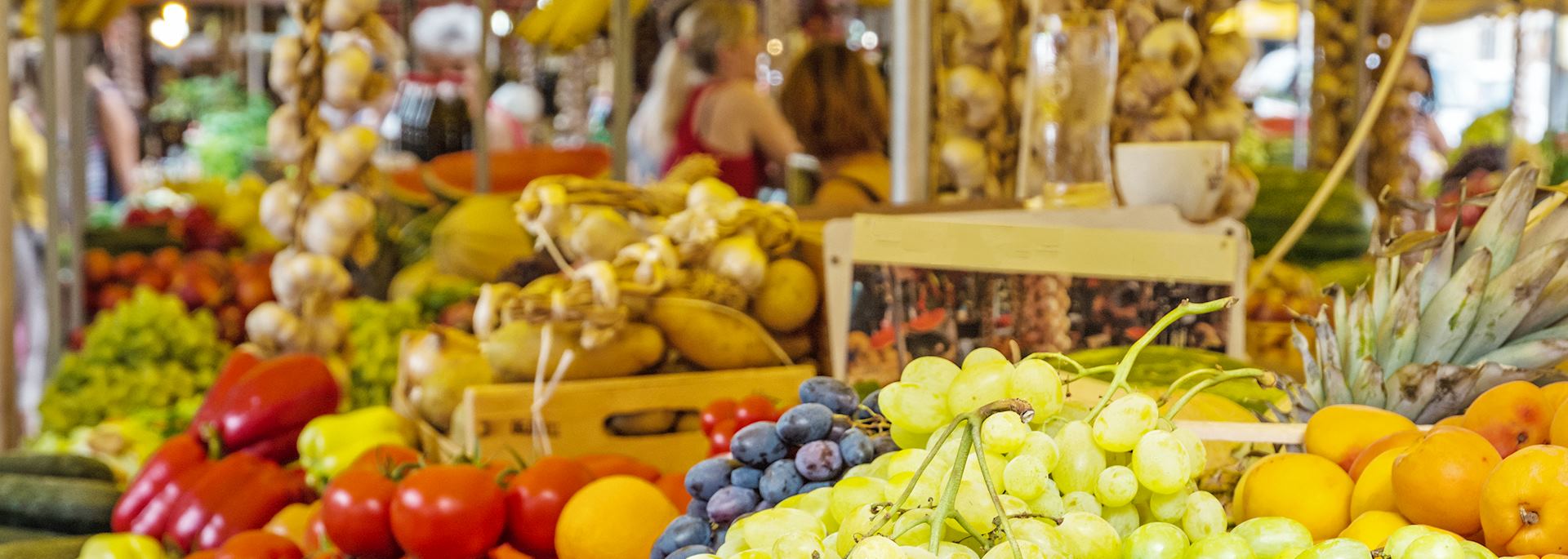
When is the best time to visit Croatia?
- Month-by-month
The best time to visit Croatia is during the summer months, from June to September, when sunlight is plentiful and temperatures are warm, between 66°F and 86°F. These conditions are ideal for boating and swimming in the blue waters around the islands.
The cooler conditions of April, May and October lend themselves to a wide range of other outdoor activities, from hiking to kayaking.
In November to March, Croatia’s winter, you can focus on Zagreb or Split when they’re at their quietest and most relaxed.
- Make an inquiry
- Request a brochure
Month-by-month guide for traveling in Croatia
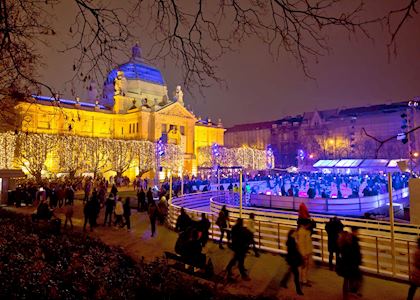
Visiting Croatia in November - April
As winter begins in Croatia, many island hotels close for the season to make their refurbishments. But, although the beaches and boat trips are off-limits, you’ll still find plenty of cultural experiences, and those hotels that stay open offer exceptional value. The winter months also present a great opportunity to enjoy the country almost exclusively with the locals.
Events & Festivals
- Carnival (January 17): Costumes ranging from medieval garb to futuristic visions are on display at this international festival celebrated in various Croatian cities, most notably Dubrovnik and Rijeka. Parades take place next to street parties, food stalls and sporting competitions.
- Feast of Saint Blaise (February 2): Dubrovnik pays tribute to its patron saint with a day of music, parades and festivities.
- Easter (March/April) is celebrated throughout the country with parades and traditional costumes, as well as decorated pisanica eggs.

Visiting Croatia in May - June
As spring begins, so does the visitor season, with temperatures rising throughout the country. With little rain and long daylight hours, this is an excellent time to visit Croatia to take advantage of fewer crowds and ideal hiking conditions.
- Saint Domnius Day on May 7 sees Split celebrate its patron saint with a daytime procession through the streets and promenade, followed by traditional klapa music, a rowing contest and a street fair throughout the afternoon and evening.
- Statehood Day on June 25 marks the date Croatia claimed independence from Yugoslavia with celebrations across the country, ranging from cultural events to lively street parties and live music.
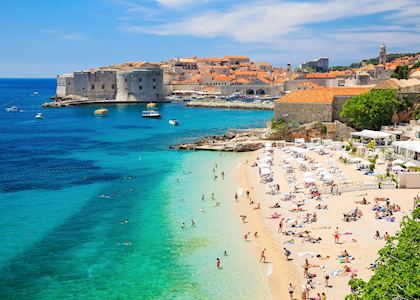
Visiting Croatia in July - August
The summer is peak season in Croatia, as visitors and locals alike enjoy the dry, hot weather. Outdoor venues host music, food and cultural events on a weekly basis, offering an entertaining and lively experience. This time of year also brings larger crowds, longer lines and increased prices at most hotels.
- Zagreb’s International Folklore Festival in July celebrates traditional Croatian culture and customs through music, dance and theater, drawing visitors from across the world.
- The Alka in the town of Sinj is held on the first Sunday of August — a uniquely Croatian festival celebrating a military victory over Ottoman forces in 1715 in which horsemen in full costume compete to lance a small metal ring for the accolade of top knight.
- Night of the Full Moon in Zadar (July/August): The waterfront promenade in Zadar is illuminated with torches and candles in this festival of regional culture and food.
- The International Puppet Theatre Festival takes place in Zagreb at the end of August or beginning of September, when professional puppeteers converge to show off their mastery in the artform.
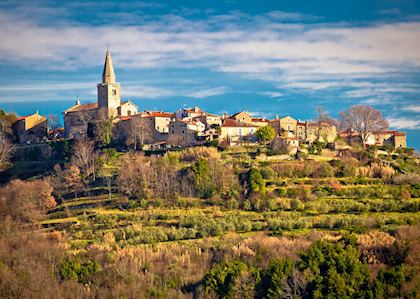
Visiting Croatia in September - October
The temperatures begin to recede during September and October, when the summer break has also come to an end. These months offer you great value with reduced crowds, enjoyable weather and plenty of cultural events taking place throughout the country. Most hotels and boat operators on the islands remain open until the end of October, and locals and visitors enjoy the quieter beach atmosphere.
- Nights of Diocletian (September) in Split is a weekend of Roman re-enactments where toga-clad performers pay their respects to the city’s ancient history in addition to parades, street food and live music.
- Truffle Days (September/October): Each autumn, the small Istrian town of Livade celebrates the local delicacy, the truffle, over 10 weekends with cooking contests, demonstrations and tastings.
Croatia Climate Guide
Why travel with audley.
- 100% tailor-made tours
- Fully protected travel
- Established for over 25 years
- 98% of our clients would recommend us

Travel advice
Practical tips for traveling to Croatia, from social protocols to guidance on money matters, with a link to the latest US State Department travel advice.

Request our brochure
Covering all seven continents, The World Your Way shows you how you can see the world with us. It features trip ideas from our specialists alongside hand-picked stays and experiences, and introduces our approach to creating meaningful travel experiences.
Trip ideas and travel guides for exploring Croatia

Family tour of Croatia
10 days from $7,875pp
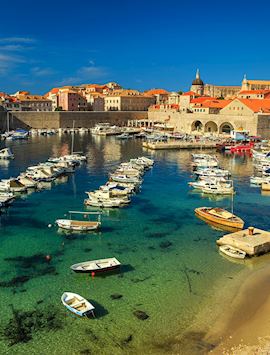
Croatia's Dalmatian Coast highlights
10 days from $8,895pp
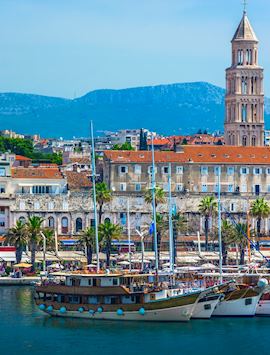
Crossing the Balkans: Slovenia, Croatia, Bosnia & Montenegro
11 days from $11,950pp

A highlights guide to Croatia
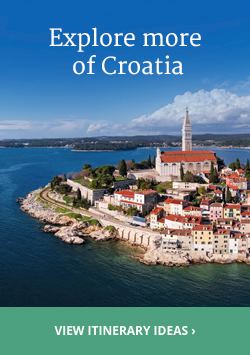
Best time to visit Croatia
Now that you finally decided to visit Croatia, you must ask yourself when is the best time to visit Croatia? In this post, we will share information and our thoughts on the best time to go to Croatia based on weather, costs, crowds, and more.

Before I tell you the best time to visit Croatia, I am gonna tell you the worst time to visit. It’s easier to pinpoint bad times because they are fewer and because they apply to everybody traveling to Croatia.
The worst time to visit Croatia is wintertime , from November through February, and the peak travel time from the last week of July to mid-August. These two periods are the worst time to visit but for all the different reasons.
Winter because it’s cold and rainy, the majority of activities, restaurants, bars, and commerces are closed, and there is almost nobody to see around. On the other hand, in peak time, the days are too hot, there are too many people around, and while all businesses are open, the prices are sky-high.
All other times are good times for your Croatian trip. And when to visit Croatia depends a lot on your personal preferences and situation. If you travel with school-age children, you will perhaps only be able to come during the school holidays.
Table of Contents
When is the best time to visit Croatia?
Croatia seasons.
You’ll notice three distinctive seasons in Croatia. A low season in Croatia is from November through April. A shoulder-season includes a period from May to mid-June, and from mid-September through October, while a high season runs from mid-June to mid-September.
A majority of tourists visit Croatia during the high season. The peak travel time lasts three weeks including the last week of July and the two first weeks of August. This peak time is, along with the low season, the worst time to visit Croatia.
Low season – November through April

Visiting Croatia over the winter, from November to April? No worries, below we explain what you can expect regarding the weather, activities, prices, and more.
But, before we go in detail, let me tell you something (shhh!). I would never recommend you to visit Croatia from November to March.
In the low or winter season, Croatia goes very quiet. Many hotels, restaurants, and activities are closed for business. Beaches are completely empty and unattended. Coastal towns, bustled with people and life during the summer, go dead in winter. The daylight is also extremely short. In winter it already gets dark around 4.30 pm.
We live in a small coastal town , and believe us when we say, when we go for a walk after dinner (6 pm) we can count on the fingers of one hand the people we will eventually pass by.
Before moving here I have many misconceptions about Croatia, and the climate was just one of them. I imagined the climate in Croatia like in Costa Blanca or Cote d’Azur. Unfortunately, while similar in some ways, it’s not the same. Zagreb gets really cold, foggy, and humid. It can also snow. Istria gets lots of gray rainy days. Weather-wise, Dalmatia it’s the best area of Croatia to visit in the low season. However, Dalmatia can also get very cold, especially when the northeast wind bura blows. It brings bright sunny but cold days.
If this is the only time you have available, then you better make it the best time to travel to Croatia for you. And our tips below will help you to do so! Visiting Croatia in winter has its charm and advantages.
Tips for visiting Croatia in the low season?
Zagreb, Split, Rijeka, Pula, and Dubrovnik are good places in Croatia to base yourself during the wintertime. Although to be honest, only Zagreb is really buzzing in winter. The other four destinations are ok because they have enough attractions to explore; they are centrally located to make day trips; they have a good choice of hotels open in winter and enough restaurants where you can have a good lunch or diner.
Have a car! A car gives you so much flexibility to go where you want and when you want. Besides, the cost of car rental is so low in winter. This way you can do many day trips and visit many beautiful places in Croatia.
You will be able to capture some awesome photos since your photo shooting won’t be disrupted by other people walking by.
Benefit from the amazing discounts that hotels offer during the low season. You can stay in a 5star hotel for as little as 100€ a night for two persons with breakfast included. The same room will cost you at least 350€ in the high season. And you can even pay less if:
- you travel during the working week (Mon-Fri)
- you book your stay in advance, and
- and if you stay longer in one hotel (at this time of the year, a stay of 3 to 4-nights is considered a long stay)
If you prefer to stay in apartments, just contact the owners and negotiate the price down. The demand is very low in winter and you should normally be able to get yourself a great deal.
Take some downtime with spa and wellness promotions that hotels also run during the winter. That room rate mentioned above sometimes also includes a 30-minute neck and shoulder massage. Try to beat that!
Events in low season
There are a couple of events taking place in the low season that you might want to take note of.
Olive Oil Fair in Vodnjan , takes place in early November. It is a celebration and a showcase of the young olive oils of that year’s harvest. Harvest in Istria is really early, in late September or early October, so in November the young oil is ready to be consumed. You can sample oils from various local producers as well as other local and homemade products like fig cakes, prosciutto, honey, cheese, wines, grappa, and alike.
Advent in Zagreb is an annual event taking place in Zagreb from the end of November until the 7th of January. The entire town turns into a Christmas fairytale with tons of fun, concerts, workshops, exciting street food, mulled wine, craft beers, and Christmas markets.
Rijeka Carnival is the best and most popular carnival in Croatia. It takes place in February.
In February, you can also partake in St. Blaise Festivities taking place in Dubrovnik.
Final thoughts on visiting Croatia in winter
Winter is definitely not the best time of the year to visit Croatia. But, it is ok if you would like to experience Advent in Zagreb (it’s only at Christmas time!) 0r if you have no other choice, but to visit in winter. Hey, you might even get lucky, and if it snows, you can go skiing on Sljeme Mount near Zagreb, or Platak near Rijeka.
If you have no choice but to visit Croatia in winter, then December is the best month to visit Croatia. At least all towns have Christmas markets and something going on.
Also, before we forget, Plitvice Lakes are beautiful in winter. Yes, they are not completely accessible due to the high levels of water, but you will have peace and quiet. You won’t need to battle your way in this amazing park through groups of other people and their selfie sticks.
Winter can be the best time to travel to Croatia for foodies. Restaurants are at their best at this time of the year. Fish and seafood are in abundance. In early August, at the heart of high season in Croatia, many fish species in Adriatic can’t be fished. Shhh, we have never told you this!
Shoulder season – May to mid-June, mid-September through October
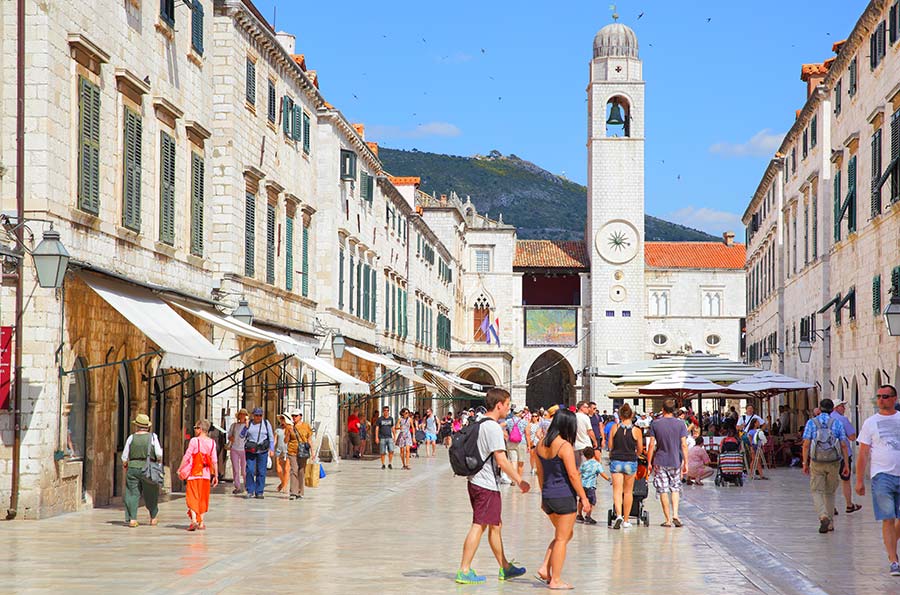
Shoulder season, from May to mid-June, and from mid-September through October, is the best time of year to go to Croatia. Especially if you do so in late September or early June.
All activities, restaurants, and hotels are already open and receiving guests. The weather is generally ok although it can be unpredictable at times especially through May and late October. You can expect the temperatures in low to mid 20C, with nights a bit chiller.
Beaches are attended, clean and neat, already receiving some swimmers, although not too many. You will have all space you need for yourself on the beach. The sea temperature still isn’t optimal for swimming. However, early June and late September can be ok. At least, it is for us. We always swim late into September.
Since it isn’t too hot nor too rainy, it’s a perfect time in Croatia for sightseeing.
The rates are more expensive than in winter, but they are still super-discounted if compared with summer. So you can still secure great holiday deals on accommodation in Croatia .
Shoulder season is the best time to visit Croatia for foodies. There are so many awesome food and wine events taking place throughout the country at this time of year.
Tips for visiting Croatia in the shoulder season
Whether you prefer small coastal villages for your base, changing destinations every day, or staying in big towns, all the itineraries will work fine. All businesses are open and running. You will already see a fair share of tourists all over the country.
Since the weather in May and late October can be unreliable and temperatures can suddenly drop, pack a wind jacket, long sleeves t-shirt, and long pants.
It’s great to have a car during your visit in the shoulder season. The weather is perfect for day trips. Driving is easy and the traffic on Croatian roads is still low at this time of the year.
Also, you can take advantage of coach tours if you are not comfortable driving.
We also recommend that you add at least one island to your shoulder season itinerary. At this time of the year, almost all ferry lines are operational, and the prices are still not as high as in the high season.
Germans are the number one visitors in Croatia. This is why many hotels adjust their rates to the German school holidays. Anyways, Germans have main school holidays between the Whitsunday and Corpus Christi weekend. They are sometimes in May and sometimes in June, depending on the time of Easter. If these holidays are in May, then hotels will run special deals for stays in June. If these holidays are in June, then you can expect to secure a good discount in May. If you are flexible, it’s good to shop around.
The same is true for the 1st of May. Hotels always get full on the weekend or a week around the 1st of May. So if you are trying to save, avoid traveling on the 1st of May.
Hotel rates also drop significantly in mid-September . You can find a nice seafront apartment for as little as 40 € a day in mid-September and October.
Events in the shoulder season
Another great reason to visit Croatia in the shoulder season is an abundance of all kinds of food events and festivals. Below we list just some of them to give you an idea of what to expect.
Zagreb Beer Fest takes place at the end of May in the center of town, in the park, at the Trg Franje Tudmana Square. Lots of live concerts, good music throughout, a great choice of Croatian beer , free admission, and a nice vibe make Zagreb Beer Fest one of the most sought-after beer events in the country.
The last Sunday in May in Istria is reserved for Open Cellars Day . Participating wineries open their cellars for free wine tasting.
If you are visiting Croatia in the fall you will like to know that white truffles , the most precious and most expensive fragrant fungi are in season from late September to January. If you like this rare delicacy, head to Istria during your time in Croatia.
Good Food Festival in Dubrovnik takes place at the end of October. You can taste traditional Croatian food , participate in a culinary tour, or learn to prepare some of Dubrovnik’s delicacies. The highlight of the festival is continuous food stands that spread the entire length of Stradun, Dubrovnik’s main pedestrian street in the old town.
Final thoughts on visiting Croatia in late spring and early fall
The shoulder season is the best time to go to Croatia. If you are flexible with your travel dates, then try to visit Croatia in the second half of September, or early June.
You can visit all landmarks, even the most popular destinations, without running into too many people. Sure, in Dubrovnik or Split, even in the shoulder season, you will still see lots of cruise ship passengers. However, there will be fewer other visitors, making the overall number of tourists much more acceptable.
Also, the weather plays a big part in making the shoulder season the best time of year to visit Croatia. When it is very hot like it gets in July and August, then it is as uncomfortable to do sightseeing as it is when it’s raining or snowing. But in the shoulder season, temperatures are just perfect for sightseeing and exploring Croatia.
If you decide to go to the beach you won’t need to fight for your space at the beach. Or, God forbid, wake up at 5 am to secure your beach spot with a towel. No, this you will do in summer (just kidding! NOT).
High season: mid-June to mid-September

A majority of tourists visit Croatia during the high season. The high season lasts from mid-June to mid-September. And the peak travel time is from the last week of July until mid-August. The high season is one of the best times to visit Croatia, as long as you avoid these three peak weeks.
At this time, Croatia is in full swing. All activities, restaurants, hotels, and day tours are running.
It is the best time to go to Croatia for the beaches. The weather is hot and sunny. You can expect temperatures in high 20C to mid 30C. The sea is warm and perfect for swimming. The sea temperatures are around 24C.
The high season is also a great time for Croatia if you look for partying, clubbing, and music festivals. There are many festivals taking place all along the Adriatic coast and Zagreb at this time of year.
So, in short, the high season is the best time to travel to Croatia if you are interested in beaches, partying, and hot weather.
But, the high season also has its downsides.
Prices are sky high! Expect to pay at least 90€ per day for two-person accommodation. And this is on a budget end. If you stay in a 4star hotel, you’ll pay around 220 € for a double room with breakfast, and that same room in a 5star hotel will set you back at least 350 € a night.
There are people everywhere and queuing is a common sight. Even more so in top destinations like Dubrovnik , Split , Hvar Town, Rovinj , Porec , etc… And on a rainy day, when everybody goes sightseeing instead of lounging at the beach, the traffic congestions are unbearable.
Access to the main attractions gets completely blocked. And to find parking is a real adventure.
We live in a small village 3 km away from Porec. But can you believe that in July and August we don’t even go to the town? Because there are so many people and cars everywhere that we don’t even want to bother going there. It is that bad!
The most popular beaches in Croatia, you know those that you saw on all promotional material for Croatia, are jam-packed. People wake up at 5 am and then go to the beach to put their towels. These people are the worst! (If you are one of them, please stop doing it!). In some beach towns, the municipality even started removing and confiscating those towels.
Tips for visiting Croatia in the high season
If you are planning to visit Croatia in the high season, we recommend that you try to avoid the peak three weeks of the high season: the last week of July and the two first weeks of August.
If you come in late June to mid-July or late August to mid-September , you might get the best of both seasons, shoulder, and high season. There are still lots of tourists around, but less than in the peak period. The weather is still hot, but a little bit less burning hot than in peak times. And the sea is warm and perfect for swimming.
In Croatia, July and August are extremely hot . Make sunscreen, a hat, and a bottle of water your permanent daypack items.
If you plan to swim in Croatia, pack water shoes. You’ll walk easier on Croatian pebbly and rocky beaches.
You know those popular beaches you’ve seen all over Instagram. Yeah, forget them in high season. Instead, ask locals for their favorite beach (not the most beautiful beach, everybody, and their mother is already there!). This way you might end at less crowded beaches and enjoy your time there much more.
Or, rent a boat and make your way to some of the small islands and islets within easy reach from your destination. In Croatia, islets are a common sight.
Beat the crowds and the heat by waking up early . Try to do all your sightseeing as early in the morning as possible. This usually means until 9 am for must-do sights, and before 10.00 am for other sights.
Events in the high season
The high season is full of events and festivals. We have a separate post on the Best festivals in Croatia if you want to read that. Here we shortlist just some of them to give you an idea.
INmusic Festival is Croatia’s largest open-air festival. It takes place in Zagreb, at Lake Jarun, in late June already for 15 years. Previous lineups included Massive Attack, Florence + The Machine, Jamiroquai, Franz Ferdinand, and many more. Since 2107, NME lists InMusic as one of the world’s best festivals.
Fresh Island Festival takes place yearly for a week in the first half of July, on Pag, Croatia’s popular party island. The exact location of this hip-hop festival is Novalja Beach, and Rock’s Beach Club, Papaya, Aquarius, and Kalypso clubs. The previous lineups included Snoop Dogg, Iggy Azalea, Wiz Khalifa, French Montana, Chris Brown, and many more.
Outlook Origins takes place at the end of July, beginning of August. Relocated for 2021 from Fort Monte Christo and Pula Arena to Garden Tisno and St Michael’s Fortress in Sibenik, the Outlook festival brings the best dubstep, reggae, jungle, and drum & bass lineup. The festival’s renowned opening festival included names like Bonobo, Jurassic 5, The Gentleman’s Dub Club, Grandmaster Flash, etc…
Ultra Europe takes place in Split at the beginning of July. It is the biggest and the most visited summer music festival in Croatia. Stadium Park Mladezi plays the main stage for three days, but there are many pre-and after-parties on popular Croatian islands. The previous lineups included Armin van Buuren, DJ Snake, Tiësto, Carl Cox, Dubfire, Afrojack, and many more.
There are many more festivals in Croatia taking place during the high season, like Hideout , Love International , SunceBeat , Dimensions , etc…
We hope this post help you get a better idea about the best times to visit Croatia! If you have any questions, leave them in the comments section below.
Frankaboutcroatia.com is a participant in the Amazon Services LLC Associates Program, an affiliate advertising program designed to provide a means for sites to earn advertising fees by advertising and linking to Amazon.com and affiliated sites. This post might also contain affiliate links to other sites, like accommodation or activities. And if you purchase anything using these links, we earn a little commission with no extra costs for you. Thank you for supporting our blog! Read full disclaimer here.
Home / Croatia Travel Tips / Best time to visit Croatia
1 thought on “Best time to visit Croatia”
I would definetly recommend going in September to get the real experience. This summer was particular so it felt like autumn already in late August. But there is something special and calming about September sun that is hard do explain.
Leave a Comment
You will be redirected to your dashboard shortly. We will also call you back in 24 hrs .
- Croatia In April: Guide To Spend An Extravagant Vacation
23 Mar 2023
Cover Image Credit: Pixabay
Croatia is one of the most beautiful countries to visit in the world. Croatia receives a lot of tourists because they wish to spend a relaxing vacation there. This place has some of the most amazing beaches in the world and not to forget the beautiful walled city (of Dubrovnik) that deserves to be explored. Unknown to many, Croatia is the origin of the breed of dog called the Dalmatian.
Another special detail about Croatia is the fact that most of the hit TV series ‘Game of Thrones’ was filmed here. And believe it or not, there is even a ‘Game of Thrones’ tour that allows fans to enter the world of Westeros.
Read ahead to find out more about exploring Croatia In April.
Weather Of Croatia In April
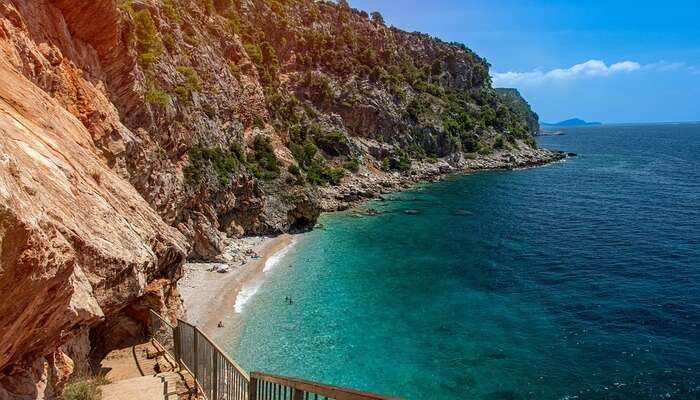
Image Source
The best time to visit Croatia is at the beginning of April. The weather is super pleasant and you can get decent sunlight during your entire stay. The average temperature during day time is 12°C, you can expect the temperature to go maximum high as 15°C and 8°C is the minimum temperature. Usually, the weather is pleasant during April when you can enjoy swimming and sightseeing the most.
Why You Should Visit Croatia in April
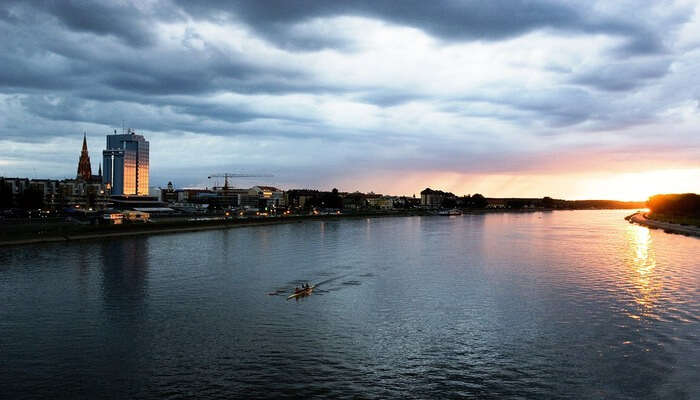
Croatia’s beaches are well sought after all over the world for its distinct sapphire color. It makes for an incredible instagrammable photoshoot! There is so much to see in Croatia. Croatia in April is probably the best time to visit the country. If you are looking for a time of the year when the climate is not too hot and not too cool at the same time. It marks the end of winter and the beginning of summer.
Festivals In Croatia In April
Here are some top festivals and events that you can explore in Croatia in April:
Biennial of Contemporary Music: If you are a huge music buff, then visit this prestigious festival that ponders the newest sounds to the target audience.
St. George’s Day: It is celebrated to cherish the beginning of the beautiful spring season. People pay respect to St. George for being a brave warrior and Roman soldier.
St Mark’s Festival: It is a music festival where both national and international artists perform local folk and classical music.
Despite Croatia being slightly expensive, one can see cheaper travel expenditures during April due to the smaller crowds. Croatia is usually flocking with tourists during the summer. In April, fewer crowds ensure a more private and peaceful vacation.
Must Read: 10 Best Dubrovnik Beaches For Soothing Every Mood On A Croatian Vacation
Croatia In April: 5 Best Places To Visit
Here are a few amazing places to explore in Croatia in the month of April:
1. Dubrovnik
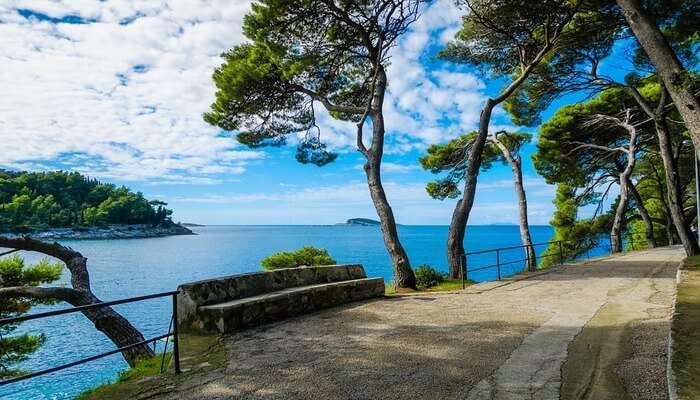
Dubrovnik is gorgeously located in Croatia. It is nicknamed as the ‘Pearl of the Adriatic’. What makes Dubrovnik so beautiful is the walls surrounding it, thus making it look like a fort city. Don’t forget to take a ride in the Dubrovnik Cable Car which is probably the most thrilling way to enjoy an aerial view of Dubrovnik city in all of its glory.
Places To Visit In Dubrovnik: ● Fort Lovrijenac: Built on a rock, facing the Adriatic sea, Fort Lovrijenac was built centuries ago to repel attackers from land and sea. ● Banje Beach: If you are bored or tired after a lot of sight-seeing, then head over to Banje Beach.
Suggested Read: Plitvice Lakes In Croatia: An Ultimate Guide That Leads You Straight To Paradise

Built by the Romans nearly 1700 centuries ago, Split is the second largest city in Croatia. It is an amazing place to explore Roman ruins or to head over to the beach. It is playfully known as the ‘Mediterranean Flower’. The Ivan Mestrovic Gallery is a great cultural place where the greatest sculptors of Croatia, Ivan Mestrovic displays are public.
Places To Visit In Split: ● Diocletian’s Palace: The palace was built to serve as a retirement home for Emperor Diocletian, who later abdicated and lived out his retirement there. ● Marjan Hill: Marjan Hill is a beautiful escape from the city that has a park situated in it that offers strolling and cycling opportunities.
Suggested Read: 10 Best Croatia Cottages That Let You Enjoy A Serene Holiday Amidst Nature
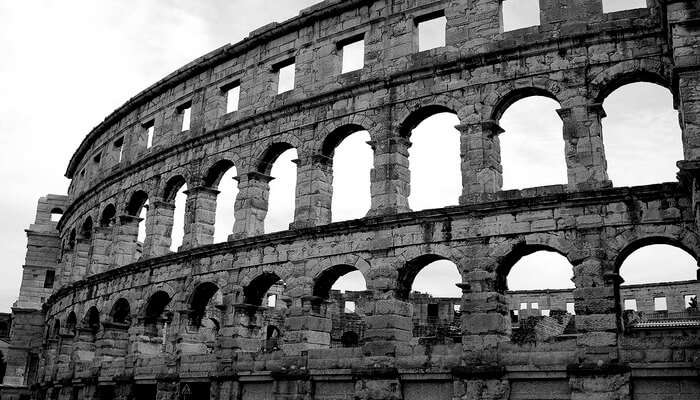
Pula is a land that has seen various rulers and hence has an assorted cultural impact. But the city is an amazing place to view Roman ruins. There Is a Roman Amphitheatre that used to have real-life gladiator matches during its prime time.
Places To Visit In Pula: ● Temple of Augustus: The temple of Augustus was built 2000 years ago but was later converted into a Christian church as the Romans adopted Christianity, and then into an archaeology museum. ● Cape Kamenjak: With its rocky cliffs and shallow water, it is an ideal diving point for tourists.
Suggested Read: 10 Best Croatia Resorts That Offer A Soul-Satisfying Stay Amidst Nature!
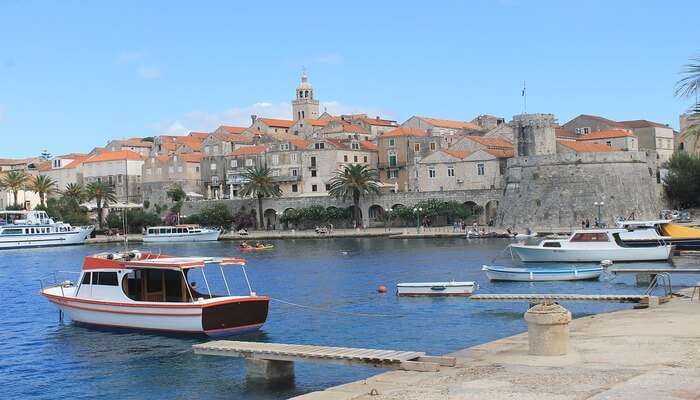
Korcula is a historic walled island town located 50 km off the Adriatic Coast. It is believed to be the home to one of the greatest merchants in the world, ‘Marco Polo’. This is a lush green island that has a lot of vineyards and olive groves. Do make a visit to the St. Mark’s Cathedral, built on a hill and offers a majestic 360-degree view of Korcula.
Places To Visit In Korcula: ● Mljet: Neighbouring Korcula is the mystical island of Mljet, half of which is a national park. ● Vela Spila cave: These are elliptically shaped caverns located on Pinski Rat hill.
Suggested Read: 10 Best Croatian Restaurants You Need To Try On Your Next Holiday
5. Krka National Park
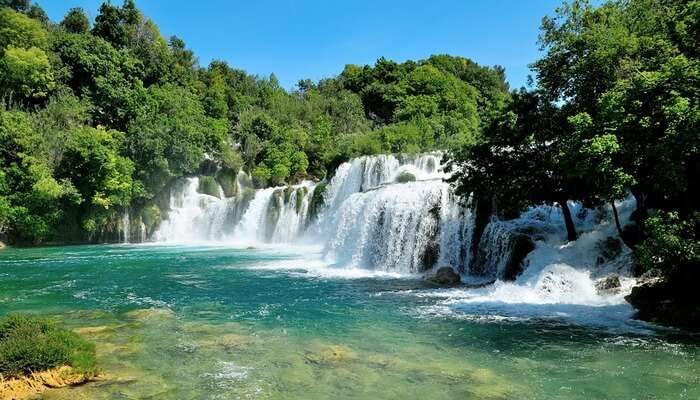
Krka National Park is a collage of wildlife, natural habitat and historical sites located in Central Dalmatia. Krka National Park offers some of the best nature walks and boating opportunities in Croatia. Skradinski Buk is the largest waterfall in Krka National Park. It is an awesome swimming spot that has eateries and souvenir shops on its shores.
Places To Visit In Krka National Park: ● Krka Monastery: Krka Monastery is well renowned all over Croatia for being a Serbian Orthodox Monastery and for its beautiful architectural style. ● Mother of Mercy Franciscan Monastery: It is an amazing spot for watching marsh birds. It is located at the center of Lake Viskovic and can be reached by boat.
Suggested Read: 10 Surreal Things To Do In Zagreb For An Unforgettable Holiday In Croatia
Croatia In April: 4 Popular Activities
So, what can you engage yourself in while exploring all the places in Croatia? Here are 5 amazing things to try in Croatia:
1. Visit The Archaeological Museum

When you are in Zagreb, the capital of Croatia, don’t miss visiting the archaeological museum. It is an amazing place where you can learn so much about Greek, Roman and Egyptian history and artefacts.
Suggested Read: 10 Best Things To Do In Split For Witnessing The Romanesque Wonders Of Croatia
2. Visit The Plitvice National Park

The park is one of the most beautiful national wonders in Europe, owing to its lush greenery, picturesque sceneries, and breath-taking lakes and waterfalls. It is accessible by wooden walkways and boats. Don’t miss indulging in boating as you can have a wonderful time with family here. Additional activities you can indulge yourself in include fishing, sky gazing and camping!
Suggested Read: Croatia National Parks: 10 Escapes To Enjoy The Astounding Wonders Of Nature!
3. Feel Mesmerized At Rovinj
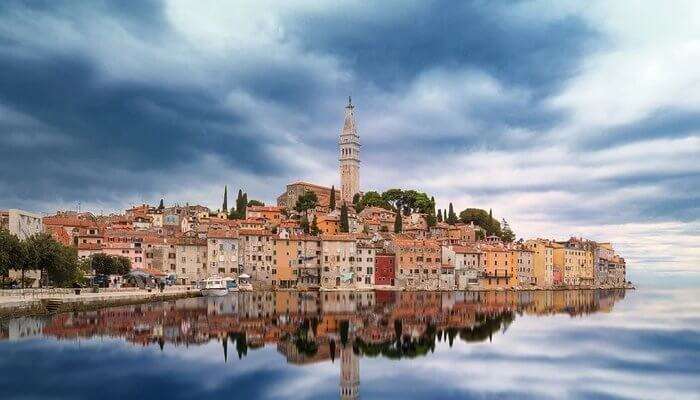
Rovinj is a small city that is, in reality, an archipelago made of 20 small islands. Rovinj is a little known tourist spot in Croatia. It is an architectural masterpiece as it showcases interesting architecture in stairways, cobblestone paths, arches, and buildings. Explore the unexplored as large parts of islands can be an awesome place for isolated and private camping experience.
Suggested Read: Croatia Honeymoon: All You Need To Plan An Incredible Escape
4. Explore The Local Delicacies
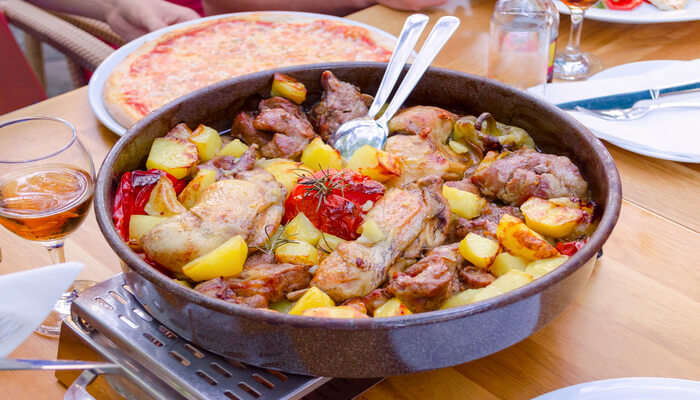
Do taste the authentic local cuisine which includes items like Black risotto , Gregada, Vitalac, Strukli, Scampi, Pasticada with gnocchi and a lot more. If you got a sweet tooth, you will fall in love with the Stukli, it is a type of delicious pastry that is filled with cottage cheese and sour cream.
Further Read: 15 Best Croatian Waterfalls That Are A Perfect Respite From Summer Madness
When you are visiting Croatia in April, make the most of your trip. Each place in Croatia has something beautiful to offer. But you can never really know until you have been there. So you better get packing quickly. The month of April is perfect for a refreshing family trip to Croatia where you can enjoy a variety of activities. Also, don’t forget to comment below for feedback, suggestions or simply if you want to share something.
Disclaimer: TravelTriangle claims no credit for images featured on our blog site unless otherwise noted. All visual content is copyrighted to its respectful owners. We try to link back to original sources whenever possible. If you own the rights to any of the images, and do not wish them to appear on TravelTriangle, please contact us and they will be promptly removed. We believe in providing proper attribution to the original author, artist or photographer.
Please Note: Any information published by TravelTriangle in any form of content is not intended to be a substitute for any kind of medical advice, and one must not take any action before consulting a professional medical expert of their own choice.
Frequently Asked Questions About Croatia in April
Is Croatia a safe place to visit?
Croatia is a safe place for tourists to visit through petty crimes like theft and snatching does take place. But Croatia has a relatively low crime rate.
How to get a visa to visit Croatia?
While citizens of the U.S. do not need a visa to travel to Croatia, tourists from other foreign countries need to get a visa from the Croatian Embassy.
What What are the average daily expenses for a person visiting Croatia?is the best time to visit Rajasthan?
Croatia is a quite expensive place to visit, especially during the summer. Generally, it would cost a person around $ 75 per day in Croatia. But costs are lower in April, due to it being off-season.
What are the most famous beaches in Croatia?
5 of the best beaches in Croatia are: Spiaza Beach, Bačvice Beach, Lovrečina Bay, Uvala Dubovica Beach, and Grebišće Beach.
In which parts of Croatia were Game of Thrones filmed?
Dubrovnik is the main filming location for Game of Thrones in Croatia. Some scenes were shot at Lokrum Island and Split too.
What is the ideal time to visit Croatia?
The month of April is best to visit Croatia, the average temperature is 11°C.
Is Croatia a safe place for a family trip?
Croatia takes good care of their tourists making it one of the safe places for all the solo as well as family travellers.
People Also Read:
Monaco In April Greece In April Finland In April
Recent Posts

5 Best Places To Visit In Hyderabad Within 100 Kms For Adventure Seekers

5 Amazing Places To Visit Near Hyderabad Within 200 kms

5 Places To Visit Near Hyderabad Within 100 Kms
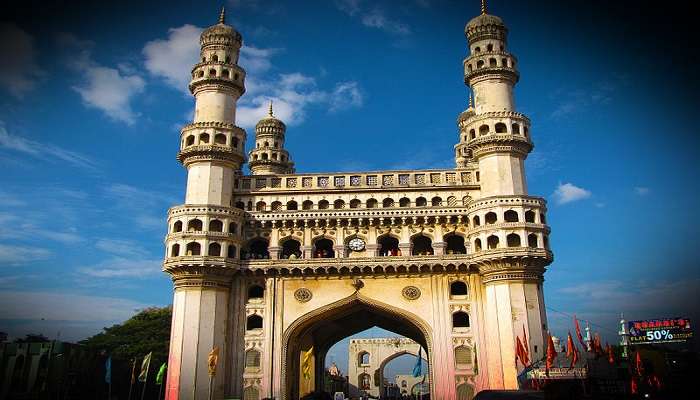
5 Charming Places To Visit Near Hyderabad Within 50 Kms
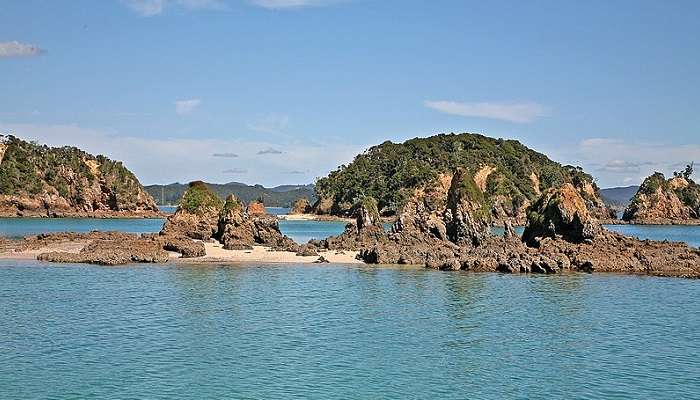
Travel To Bay Of Islands For A Magical Getaway

Explore The Wonders Of Mount Cook
Trending Blogs

20 Mysterious Places In India To Visit In 2024 More Bizarre Than The Bermuda Triangle

10 Scariest Roads In India That Are A Driver’s Nightmare

101 Places To Visit In India Before You Turn 30 in 2024

35 Exotic Places To Visit In December In India 2024 To Enjoy A Surreal Vacation

60 Best Honeymoon Destinations In India In 2024

95 Best Honeymoon Destinations In The World In 2023 For A Romantic Escape!
Best Places To Visit In India By Month
Best places to visit outside india by month.
- TravelTriangle
- International
- Europe » Croatia »
- Tour Packages
- Honeymoon Packages
- Family Packages
- Budget Tour Packages
- Luxury Tour Packages
- Adventure Tour Packages
- Group Tour Packages
- Maldives Tour Packages
- Bali Tour Packages
- Dubai Tour Packages
- Singapore Tour Packages
- Thailand Tour Packages
- Europe Tour Packages
- Sri Lanka Tour Packages
- Tour Packages From Delhi
- Tour Packages From Mumbai
- Tour Packages From Bangalore
- Tour Packages From Chennai
- Tour Packages From Kolkata
- Tour Packages From Hyderabad
- Tour Packages From Ahmedabad
- Thailand Tourism
- Bali Tourism
- Singapore Tourism
- Maldives Tourism
- Mauritius Tourism
- Dubai Tourism
- Europe Tourism
- Hotels in Thailand
- Hotels in Maldives
- Hotels in Mauritius
- Hotels in Bali
- Hotels in Dubai
- Hotels in Singapore
- Hotels in Sri Lanka
Accessibility Links

Best time to visit Croatia: when to go and what to do
We reveal the optimal months for trips to the adriatic nation, so you can skip the ferry queues for island-hopping and see the national parks in full bloom.

C roatia is two countries – the actual one and the imaginary one created in your head from a scrapbook of holiday brochures, hearsay and hope. The trick to matching the two is to time your visit right. Fancy fizzing streetlife in Dalmatia’s historic beauties, Dubrovnik, Split and Hvar Town? July and August are ideal. If you’re after slow island-hopping, late September is your best bet. For walks and cycling visit in late-April and May. Here we reveal how to make Croatia the destination of your dreams. Also when to come for world-class music festivals, village donkey races and city streets filled with Roman soldiers.
When is the best time to visit Croatia?
The best time to visit the Adriatic coast is either between May and mid-June or in September: bright days; warm seas; resorts shifting down a gear after high season.
Main photo: The Makarska Riviera (Alamy)

When is peak season in Croatia?
July and August are the most popular times to travel to the coast. Go then to experience resorts such as Split, Dubrovnik or Hvar Town at their most vivacious. Streetlife sparkles, the evening promenades buzz, and events — from cultural beanos and music festivals to village fetes — pop up across the coast. The flipside, inevitably, is the crowds. You may struggle to find space in restaurants or on the beaches and you should expect long queues for ferries (more below). Conversely, because Croats also decamp to the coast, inland regions and the capital, Zagreb, take on a more peaceful vibe.

When is shoulder season in Croatia?
May to June and September to October. In spring, the islands have reopened after winter shutdown and sunny days are now the default, yet crowds remain relatively low. Early autumn is better still: seas are at their warmest in September. Resorts breathe a sigh of relief after August and warm days remain near-guaranteed. October is cooler and sees the start of truffle and grape-harvest season in Istria. Be aware that islands start to close for winter in October. Both periods are the perfect time of year to see national parks – especially for spring or autumnal colours in the Plitvice Lakes .
Advertisement

When is the rainy season in Croatia?
Croatia sees the rain in November until February. During this time you’ve got a decidedly British 50 per cent chance of rain. That said, it depends on where you go. Destinations beneath the Dinaric Alps — Zadar, Split and especially Dubrovnik — are over twice as wet as Istria’s Pula. Offshore islands Hvar, Vis and Lastovo are the driest in the country. Similarly, capital Zagreb, at the edge of the Panonian Plain, experiences about half the rainfall of Dubrovnik; what it receives instead is snow. It’s worth a dedicated trip in December to fall under the festive spell of one of Europe’s best Christmas markets.

What are the cheapest months to travel?
March and April are the best-kept secrets for trips to Croatia. Sure, sunshine is not guaranteed and restaurant choice remains limited compared with peak season. But accommodation is cheaper and cafes reclaim streets. Best of all, visitor numbers are low — emptied of tour groups , historic cities such as Dubrovnik and Split appear astonishing, like the sets of Italianette operettas. Things are trickier on the islands as all but a handful of hotels and restaurants remain closed until mid-April. If you’re not fussy, this is a great window to walk, cycle and generally rewind to an age of simpler holidays.

What’s the best time to go island-hopping in Croatia?
Stick to the summer months to avoid any logistical headaches. National ferry provider Jadrolinija increases crossings from June to September, with services peaking on popular routes in July and August. In addition, private operators run summer-only passenger services from July to September. The caveat? Queues to popular islands can be long if travelling with a car. The trick is to book ahead or, better still, travel on foot. That way you’re guaranteed passage on car ferries and can take useful inter-island passenger-only vessels to save back-tracking. Local buses and taxis greet ferry arrivals, and tourist agencies rent cars and scooters for travel on islands.

Sunshine and rainfall
The sunniest months in Croatia are July and August; Split in central Dalmatia averages 12 hours daily and temperatures stay close to 26C. Statistically, the wettest month is November; Split receives 12 days of rain, circa 114mm.
Key dates for your calendar

February Carnival is one of the few national events celebrated with gusto. If you’re after noise and colour, head to Rijeka on the Sunday before Shrove Tuesday; its International Carnival is one of the biggest processions in Europe, a three-mile cavalcade of marching bands, costumes and floats, trailed by young men dressed in traditional horned sheepskins. If it’s quirkiness you seek, head to Lastovo where a traditional day-long dance is like some latterday rite. Dubrovnik’s big day is the Feast of St Blaise, traditional city protector, on February 3.
20 of the best luxury villas to rent in Croatia
July Peak season means peak events. Split and Dubrovnik compete in two month-long music festivals: Split Summer Music and the Dubrovnik Summer Festival. Motovun in Istria hosts a prestigious art-film festival which doubles as a five-day party over the last week in July. For tradition, Omis near Split stages traditional folk concerts at weekends during the Klapa Festival. Make a special trip to Korcula on July 29 when a traditional Moreska sword dance usually condensed into 30-minute tourist performances gets its full two-hour outing. Finally, Rab Fair on Rab Island is an eye-popping medieval pageant to honour the town’s patron saints (July 25-27).

The premier traditional event is the Alka on the first Sunday of the month – a medieval joust held in Sinj near Split so popular it’s screened live on national television. Don’t miss Saljske uzance in Sali on Dugi Otok island, either. It’s one of the best local festivals on the Adriatic and is an enjoyably bonkers whirl of fishing-boat parades, donkey races and processions over five days before the Assumption of Mary on August 15. Split’s Days of Diocletian, when costumed Roman events are staged in the old town, peaks in August — show me the kids who aren’t wide-eyed at marching centurions, fire-breathers and gladiators.
Take me there
Inspired to visit Croatia but yet to book your trip? Here are the best packages from Tui* and BA Holidays* . These are the best tours of Croatia from our trusted partners* .
Sign up for the Times Travel Newsletter here .
Related articles

When is the best time to visit Croatia?

The best time to visit Croatia is in the summer (June to September) when the weather is hot and sunny, the glittering coast is at its best and the festival season is in full swing. That being said, figuring out when to visit ultimately depends on what kind of holiday you want. Croatia's climate varies from continental to Mediterranean and there’s plenty to do throughout the year. You also need to factor in if you mind peak season crowds. Let’s break it down.
Best for: skiing and snowboarding, thermal spas.
January is the coldest month with average highs of 41 to 50°F along the coast and 28 to 32°F inland. It's the best month for powder hounds looking to hit the slopes. Plus, popular ski resorts like Sljeme and Platak are usually quieter and more affordable than resorts in France and Switzerland. With little to no crowds, it's an ideal time to explore Plitvice National Park in solitude or gush over Krka's frozen waterfalls (if it’s cold enough). If you prefer R&R over adrenaline-pumping snow sports, the cold weather is the perfect excuse to relax in one of Croatia’s many thermal spas.
Best for: Mardi Gras, skiing and snowboarding.
One word: carnival. Mardi Gras is a big thing in Croatia with vibrant celebrations all over the country. The biggest and boldest festivities take place on the Sunday before Shrove Tuesday in the port city of Rijeka – think colorful float parades, dancers donning glitzy costumes and performers wearing animal head masks to ward off evil spirits. It’s a great opportunity to party with locals and eat traditional foods like krofne (Croatian doughnuts). February is the last month to hit the slopes, though the powder might not be as good as in January.
Best for: exploring with thinner crowds, the Mali Ston Oyster Festival
March kicks off the spring. The weather is unpredictable, but daylight savings means you can get out there and explore Croatia's natural beauty – just make sure you bring warm layers and a waterproof jacket. It’s not quite beach weather and many hotels, restaurants and ferry routes are still closed, but you’ll have Dubrovnik’s charming Old Town, Diocletian’s Palace and other major tourist attractions (almost) all to yourself. There’s also the annual Oyster Festival in the charming coastal village of Mali Ston – if you like seafood, this festival promises to be a treat.
Best for: getting active, the Weekend Food Festival.
The weather can still be a bit iffy in April, though it’s usually warmer and sunnier. If you don’t mind the odd shower, it’s one of the prettiest times to go hiking or cycling with colorful wildflowers dotting the landscape. There’s more of a buzz in the air as ferries, bars and restaurants start opening up, and it’s a good time to strike up a conversation with locals who travel domestically around the Easter weekend. Foodies can head to the Weekend Food Festival held in the picturesque city of Rovinj to enjoy a smorgasbord of local produce, workshops and cooking demos.
Best for: enjoying the beaches and national parks before the summer rush.
With more stable weather and warmer temperatures, beach days are back on (especially towards the end of the month). As May is considered a shoulder month, it’s a fantastic time to hit the trails and waterfalls in Krka and Plitvice, discover Dubrovnik’s ancient city walls or enjoy seafood along Split's promenade without the scorching summer sun and crowds. The cruising season starts mid-May, and while the conditions aren't as good as in June through September, it's a good time for seafarers who prefer cooler temperatures and quieter marinas.
Best for: enjoying Croatia’s beautiful beaches, cruising and sailing.
Hello, summer! With hotter temperatures, it’s prime time to enjoy the sparkling Dalmatian and Adriatic coast, dive into Plitvice’s lakes or appreciate the cool water of Krka’s cascading falls. With a lively, upbeat atmosphere in the air, it’s a great time to set sail on an island-hopping adventure or listen to live music in Dubrovnik’s, Split’s and Zagreb’s squares. Despite an influx of tourists, it’s still not as busy as July and August. Accommodation gets booked up quickly from June, so you might want to plan ahead.
Best for: watersports, enjoying the summer buzz, festivals.
July is one of the hottest and busiest months. It’s particularly hot and sticky in the cities, so sightseeing might be a no-no if you don’t cope well with the heat. Bars, restaurants and hotels along the coast are pumping, and the azure waters are at their most enticing with a wide range of watersports on offer. If you enjoy the summer buzz, it’s a great time to sip cocktails in Hvar, wander Zadar’s cobbled streets or enjoy balmy alfresco dinners – seafood plucked straight from the Adriatic, anyone? The festival calendar is also chockablock with the Dubrovnik Summer Festival, the Split Summer Festival and the Full Moon Festival in Zadar to name a few.
Best for: enjoying the coast, cruising and sailing.
August is the peak of summer. Temperatures soar and large crowds congregate at national parks and tourist attractions (our tip: wake up extra early to avoid long queues). If you want to lap up the beauty of the Croatian summer but without the crowds, get yourself on a small ship cruise or sailing boat to explore where the big ships can't go. With stunning coastal vistas and plenty of adventures waiting for you on and off the water, it’s the perfect way to balance adventure and relaxation.
Best for: enjoying the perks of summer without the crowds, Varaždin Baroque Evenings
Things settle down in September. You’ll still get to enjoy the balmy buzz of summer but with milder temperatures, more room to sprawl on the beach and shorter lines at popular sites. The sea is at its warmest which is great for watersports and it's the last month to enjoy a sailing trip . Plus, you'll benefit from thinner crowds once you drop anchor to explore islands, coastal towns and national parks. Music lovers will also love the Varaždin Baroque Evenings – a world-famous event that takes place in beautiful churches in the historic city of Varaždin.
Best for: hiking, the Zagreb Film Festival, the Good Food Festival
October weather is mild and the sea is still warm enough for swimming, but the days start drawing in earlier and there’s more rain – so you’ll need an umbrella and a hoodie for the evenings. With the changing foliage, it’s one of the best months to go hiking and swimming in Plitvice Lakes National Park. October is also a month for foodies with Dubrovnik’s much-anticipated Good Food Festival – a week-long extravaganza of workshops, cooking demos and tastings. There's also the annual Zagreb Film Festival which features a wide range of film and cultural events all over the city.
Best for: photography in Croatia’s national parks, feasting on local wine and produce
November marks the start of the low season, so bear in mind that ferry timetables may be limited and bars and restaurants along the coast may close. National parks like Krka are a photographer’s dream thanks to dramatic fall foliage, and the turning weather also lends itself to exploring Croatia’s ancient castles. St Martin's Day, known locally as Martinje, is a highlight of November. Join locals to celebrate St Martin, the patron saint of wine and winegrowers, by indulging in local wine, olives and traditional Croatian dishes.
Best for: Dubrovnik Winter Festival, Zagreb Christmas Market
Winter in Croatia can get cold, but don't let that put you off. December is a magical month with the sight of snow-topped mountains and festive cheer flooding the streets. Winter is a time to explore Croatia's cities, enjoy hot beverages in cosy bars and learn about history and culture in galleries and museums. To soak up the seasonal vibes, head to Zagreb (voted one of the best Christmas markets in Europe ) to shop, eat, drink and be merry. Or visit Dubrovnik for the lower-key Dubrovnik Winter Festival to experience more traditional festivities.
Let's create an exclusive trip for your group.
Greece vs Croatia: Where to travel next?
What to expect on an Intrepid Premium trip
9 ways to make meaningful cultural connections through food in 2023
9 ways to get to know a place through multi-active adventures in 2023
A plus-size travel guide to Dubrovnik and Greece
10 things you’ll experience on an Intrepid Retreat in Europe
5 Game of Thrones locations you can actually visit
Busy workaholic? Here’s why a sailing adventure might be just what you need

Best Time to Visit Croatia: For Weather, Island Hopping, Sightseeing & More
By: Author Taylor Lorenz
Posted on Last updated: 03/27/2023
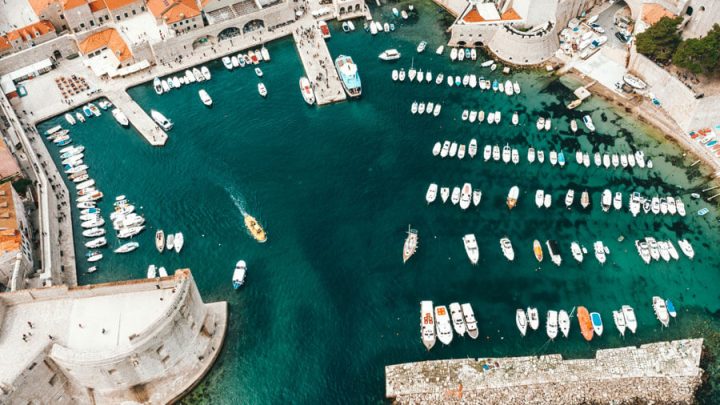
Croatia has been a hotspot on the map of popular European tourist destinations for many years now, and it’s a truly wonderful place to visit for its stunning blue waters, island hopping, and old towns that were a backdrop for films, TV, and tourist pictures alike.
The time of year that you take your Croatia vacation will depend on all kinds of different things, and it can be tricky to choose a month or a season sometimes, especially when you’re going somewhere that has areas that lovely all year round.
To help you out, we’ve written this guide outlining the best time of year to go to Croatia based on factors that can affect your trip.
Table of Contents
Best Time of Year to Visit Croatia
Whenever you choose to go to Croatia depends on your personal preferences, but there are some things that you may wish to consider. Weather, expenses, and crowds can all have an impact on your trip.
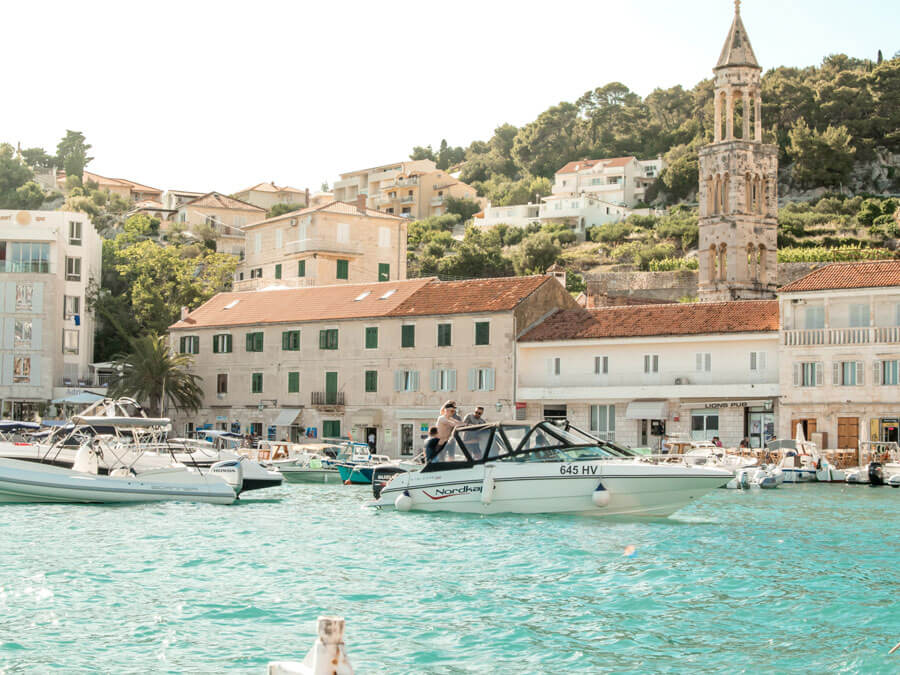
For Weather
Croatia is a country in the Balkans and its weather is mild.
Like most places in the northern hemisphere, Croatia is generally warm and dry in the summer and cool in the winter, but the climate differs from place to place throughout the country.
The closer you are to the Adriatic Sea, the warmer you’ll be. For example, some of Croatia’s most popular cities such as Dubrovnik, Split, and Zadar , are on the coast, so you can expect a typical Mediterranean climate there. While in the capital, Zagreb, which in inland you can expect snow in the winter but hot summers.
The coldest months of the year are January and February, which have temperatures with highs of 10°С and lows of 2°С. On average, December is the rainiest month, with 80mm of rain and 13 rainy days.
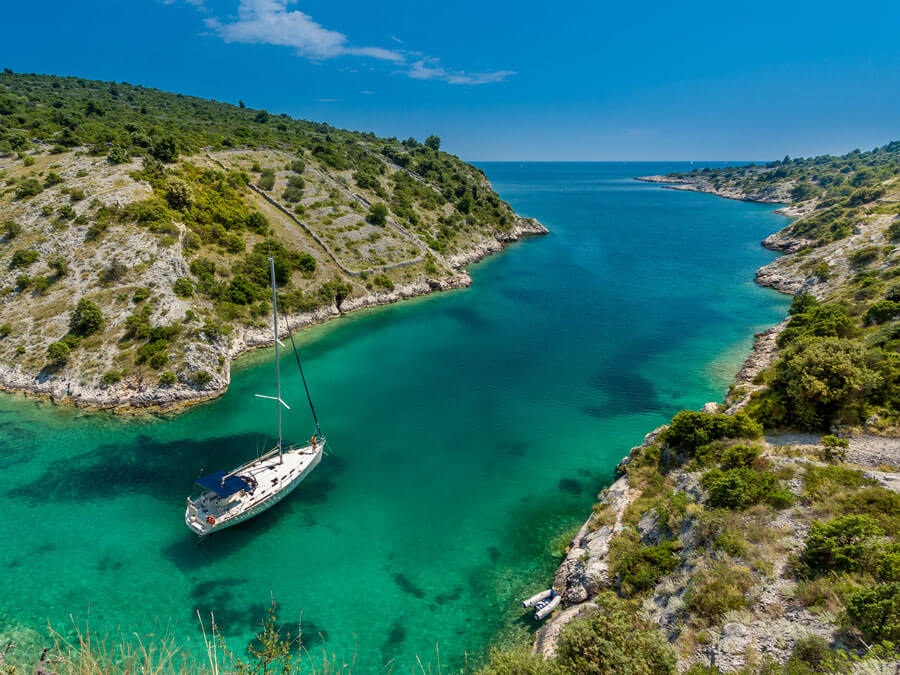
For Budget Conscious Travellers
Those who have a tight budget will benefit from going to Croatia outside of the high season. The high season is June, July, and August, when North American and European schools break for the summer.
If you travel during the shoulder seasons (the months before and after the high season) in May and September, you’ll be able to benefit from cheaper flights and accommodation, as well as having the possibility that prices will be lower at attractions and eateries.
Prices can really shoot up in December over the Christmas period, as this is when people travel to see their family or take Christmas vacations, so avoiding these times can help you save some pennies.
So, the best time to travel to Croatia on a budget is either during the months of May or September, or anywhere outside of June, July, August, and December.
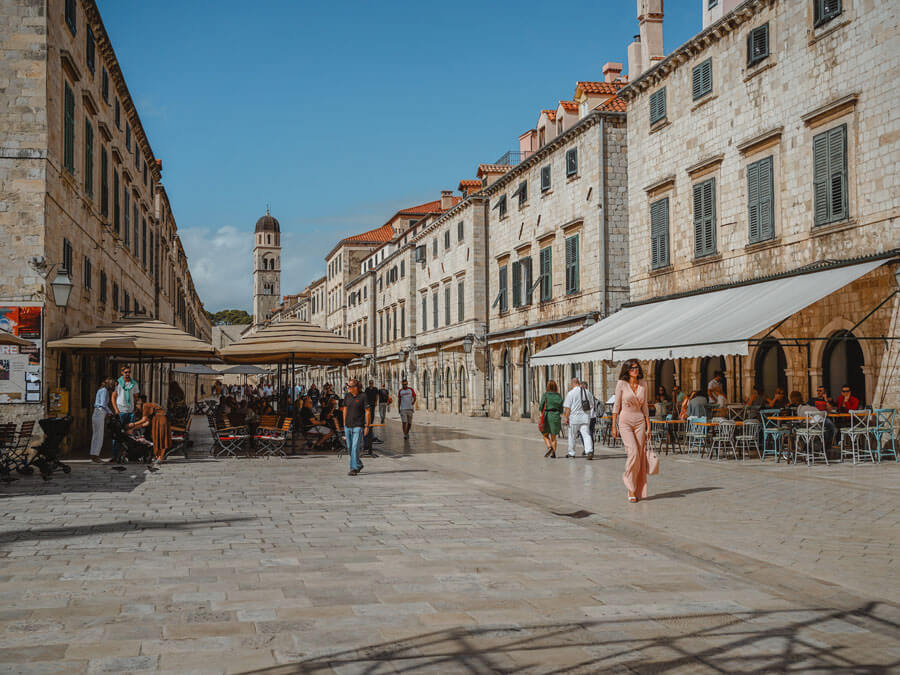
To Avoid Crowds
The best months enjoy all that Croatia has to offer while still avoiding crowds are likely to be May and September. These are the shoulder seasons and they offer you the best of both worlds. You’ll still get to enjoy the weather and events that are available, but there will be fewer people around and prices are often cheaper!
Croatia has some great festivals, many of which are held in the months of July and August, so be aware that there can be even larger crowds than typical summer tourists.
The school holidays, which are usually from mid-July to early September, over the Christmas and Easter periods, in October, and in February, can be incredibly busy times to travel to Croatia, too.
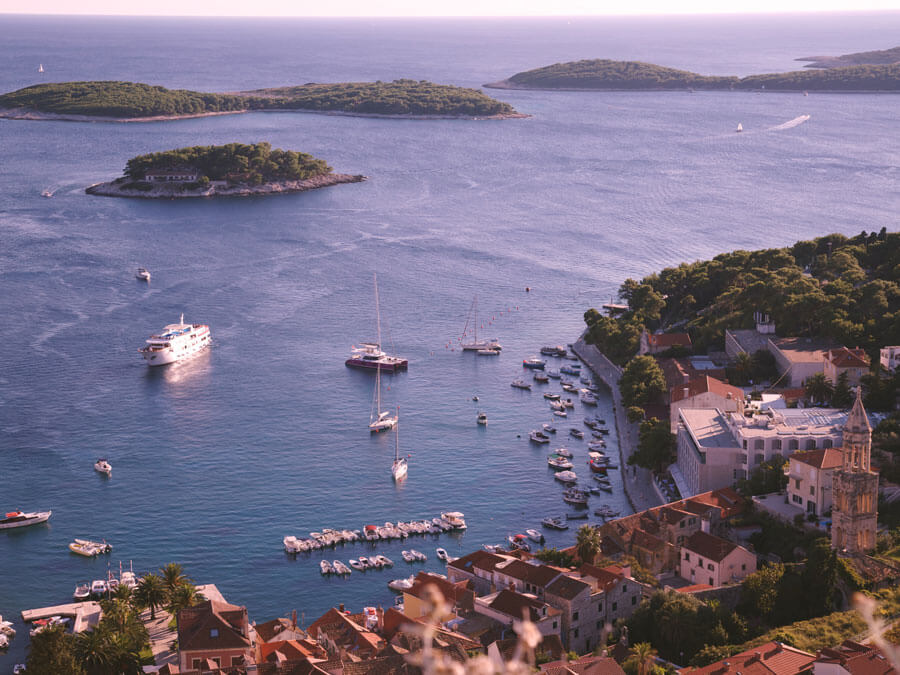
For Island Hopping
Croatia is popular for its island-hopping holidays, which is hardly surprising considering the islands and the surrounding waters are so beautiful.
While it may be a touch on the busy side, the best time to travel to Croatia to go island hopping is the summertime, such as July and August. This is because the weather is warmer, the sea is warmer, and the ferries are more active.
The ferries that can take you from island to island will often have reduced schedules out of peak times, so it can be much easier to island-hop during the summer.
If you really want to avoid the crowds, try going in June or September instead. However, some accommodations, restaurants, clubs, and bars close in the autumn (typically mid-end of September), so we don’t recommend island hopping during the autumn or winter months.
READ MORE: 11 Best Islands in Croatia for a Scenic Visit
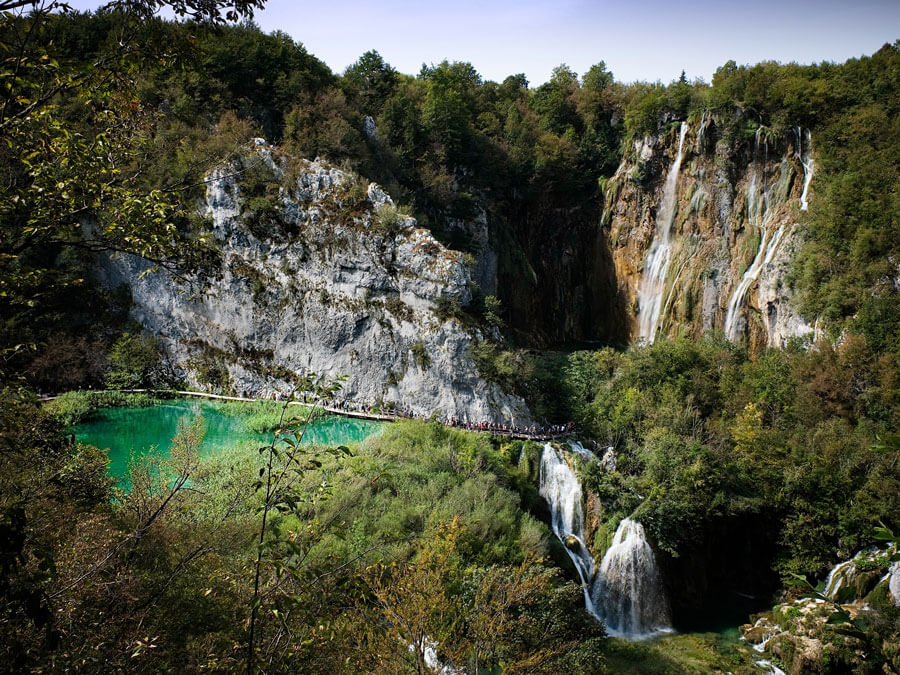
For Sightseeing
There are a great many much-loved beaches in Croatia, such as the most famous beach in all of Croatia, Zlatni Rat Beach in Bol, and Banje in Dubrovnik.
The beaches can get super busy during the peak beach seasons (May-September), but that’s not necessarily a bad thing! If you want to avoid the hustle and bustle, you’ll still get warm weather and sea temperatures at the beaches in April and October too.
The Adriatic Sea is generally warm, apart from during the winter, so swimming when you go to the beach should be on the cards, especially if you go during the warmer summer months.
Croatia is known for its stunning national parks, and spring is a great time to visit them because of the foliage and wildlife that comes to life during that season. If you like hiking, visiting the national parks in spring or early autumn can be perfect because the weather is nice, but it won’t be too hot.
There are a number of popular destinations for tourists in Croatia, including Split and Dubrovnik. Split is Croatia’s second-largest city and is on the Dalmation coast. The best time to visit Split for activities and events is the peak season, but you can actually enjoy what this city has to offer all year round. One of Split’s most popular events is the Split summer festival, which is held in July, and has been running since 1954!
Dubrovnik is perhaps the most famous destination in Croatia, popular with tourists, it’s listed as a UNESCO world heritage site. It has around 2,900 hours of sunshine every year, making Dubrovnik a wonderful place to go if you like to catch rays. With that in mind, we think that the best time to visit Dubrovnik is in the spring and summer months, from April to August, as you’ll see some of the best of nature, as well as experiencing awesome weather.
Croatia is also known for its music festivals, including Hideout Festival (June), Suncebeat Festival (July), and Defected Croatia (August). These music festivals are loved by both visitors and locals and bring music lovers to the country from far and wide.
There isn’t really a bad time to go to Zagreb, the main city to go to that’s inland, but there are some key events that tourists like to attend, such as Dance Week Festival, We Love Sound music festival, and Zagreb Pride, all of which are held in June.
Croatia Travel Insurance
Best Season to Visit Croatia
Croatia isn’t a place of extreme weather, but you can expect four distinct seasons, with hot summers and much cooler winters.
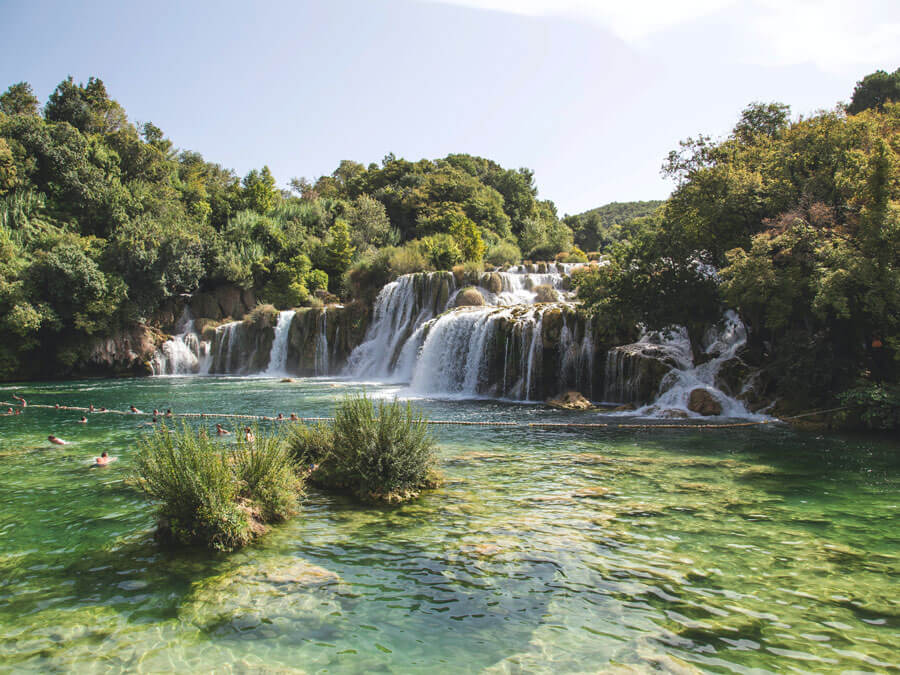
Summer (June-August)
The summer months are the best time to go to Croatia weather-wise, with July and August being the warmest.
The average temperature in June during the day is 26°С and the sea temperature is 23°С. In July, you can expect temperatures of around 29°С and sea temperatures at 25°С. August is the hottest month of the year in Croatia, with average temperatures of 30°С and sea temperatures at 26°С.
This is the high season and is definitely the best time for sun-seekers to take a vacation to Croatia.
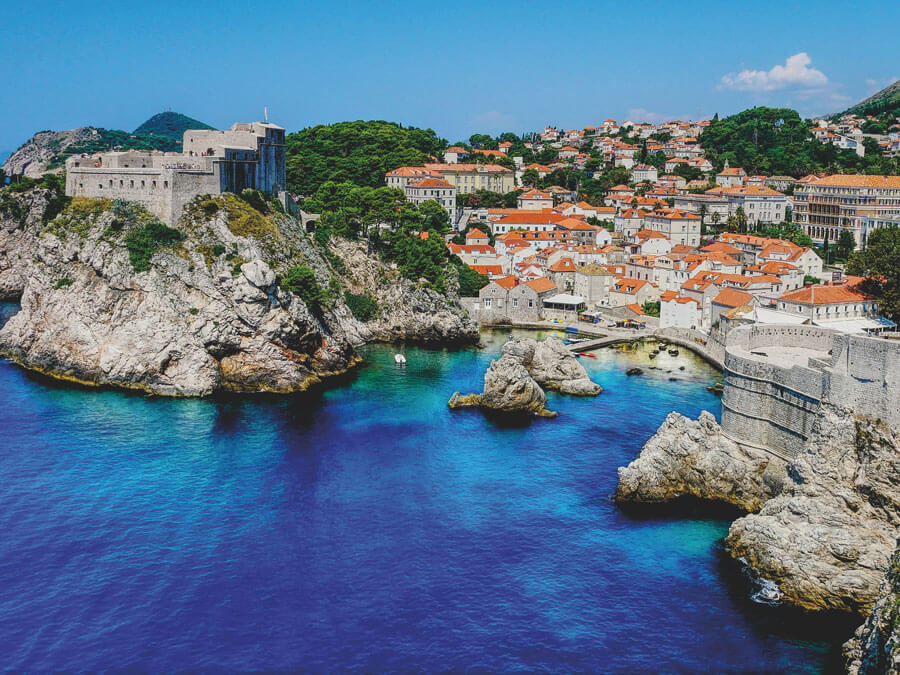
Autumn (September-November)
You’ll still get hot weather when you visit Croatia in the autumn. In fact, you can expect averages of 25°С in September and sea temperatures of 24°С. October has temperature averages of 21°С and 20°С for the sea.
In November, the temperature drops dramatically, with averages of 14°С and the sea at around 17°С. Early autumn can be an awesome time to visit because it’s still warm, but it’s not scorching hot like it can be in the summer.
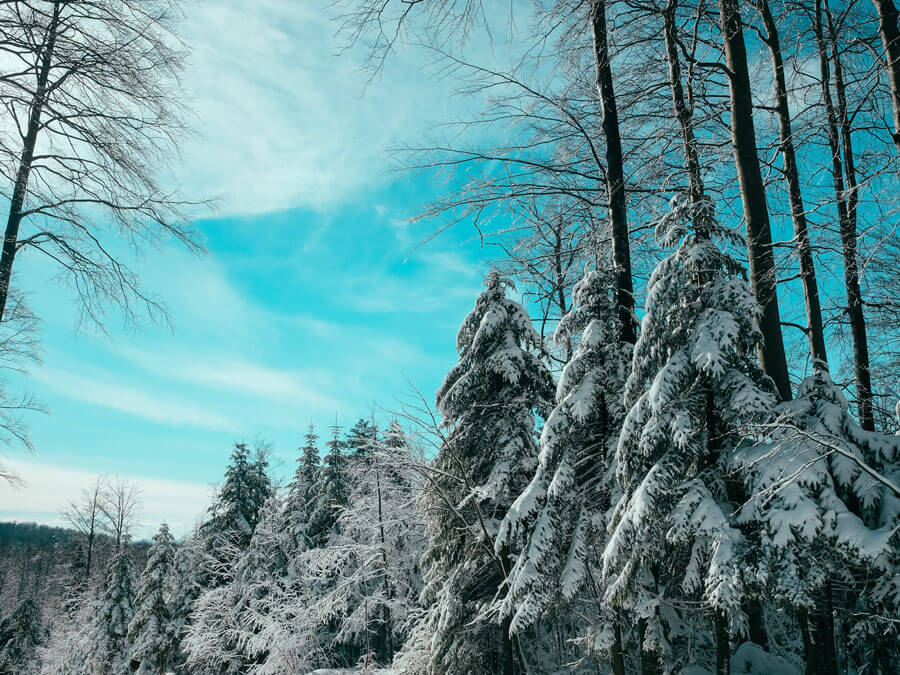
Winter (December-February)
Winter is cool throughout the country, with average temperature highs at 11°С in December, 10°С in January, and 9°С in February. February is the coldest time of year in Croatia. Winter is the only time of year in Croatia that the sea temperature is warmer than the temperature on land.
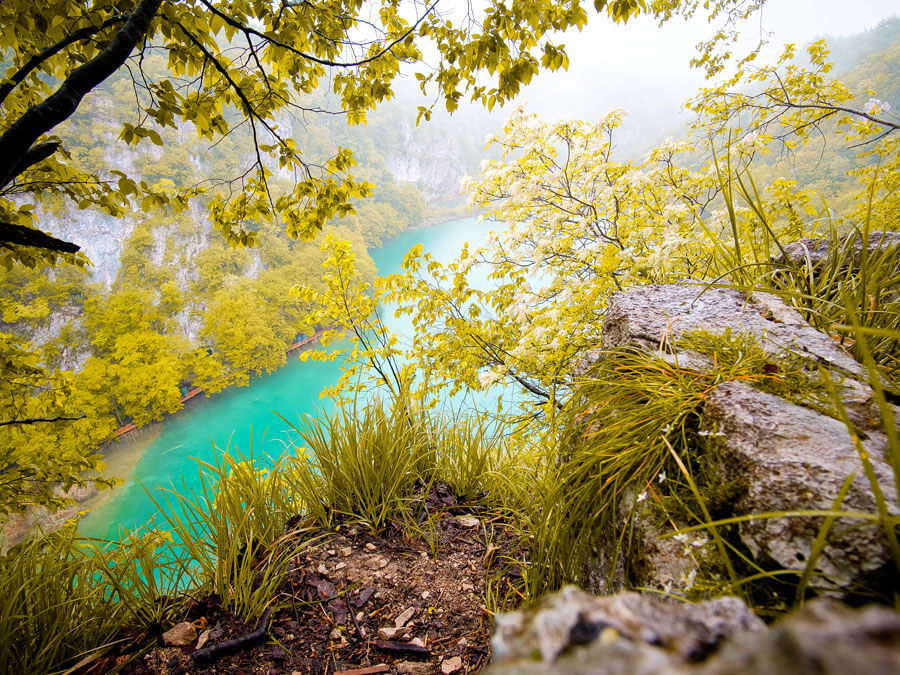
S pring (March-May)
Spring is when you can start to see temperatures rise again. In March, the average temperature during the day is around 13°С, in April it’s 17°С, and in May it’s 23°С.
May is when temperatures really start to get high again and the sea temperature will be around 19°С, so this can be a great time to visit.
When is the best time to go to Croatia?
After taking into consideration everything above, the best month to visit Croatia is June. Other brilliant months to go are May and September (when I personally went and loved). In May and September you can expect fewer crowds and lower prices, but still get warm weather.
If you don’t mind a bit of busyness, going to Croatia in July and August could be a great option for you, especially if you enjoy the hot weather or want to go island hopping. The summer is also a brilliant time to visit Croatia as it’s music festival season. There are some awesome music festivals in the country, but we recommend booking early to avoid disappointment.
Visiting cities such as Zagreb , Split , and Dubrovnik is great throughout the year and you should find that most attractions are open. However, in parts of the low season, bars, restaurants, and clubs close on the islands, even the most popular ones such as Hvar , Brac , and Korcula , so it’s far from an ideal time to go island hopping.
Since Croatia is on the Adriatic coast, it’s great for swimming because the waters are warm almost year-round. The waters are good for swimming, however, it can get windier and wetter during the winter, and the waters are colder, so we don’t recommend swimming in the winter unless you do it for a shock!
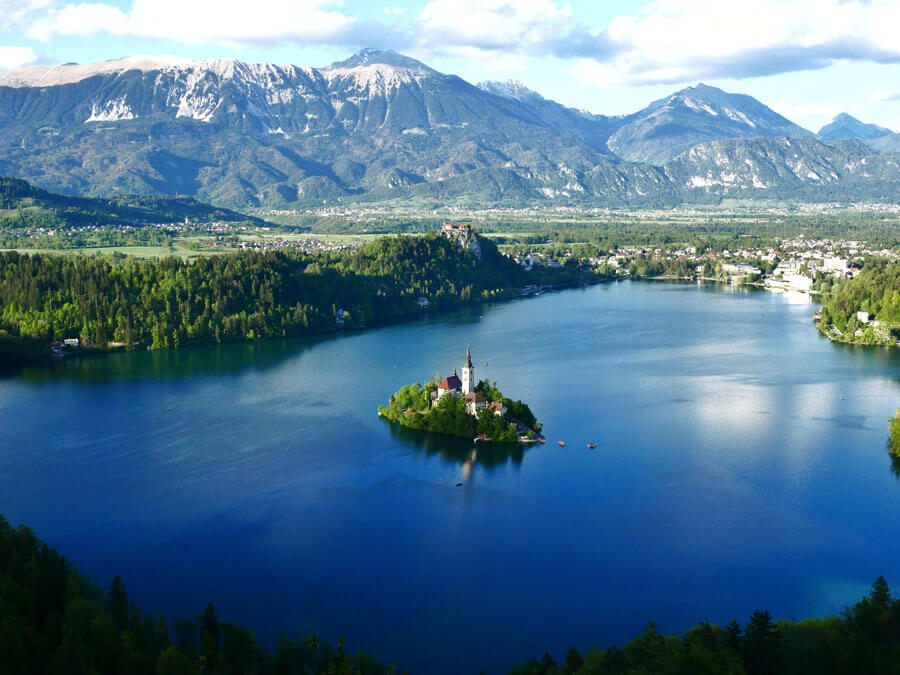
When is the best time to visit Croatia and Slovenia?
Croatia and Slovenia are neighbouring countries and are similar in climate, although Slovenia is a little cooler. The best time to visit Slovenia and Croatia are May and September, the shoulder seasons. Visiting during these months means that you get ideal weather without it being too hot or cold, fewer crowds are around, and prices are typically lower for flights and accommodation. September is your best bet if you want to see fall foliage, especially in hot spots such as Lake Bled in Slovenia , and Plitvice Lakes National Park in Croatia.
Enjoy your visit to Croatia, make sure to give yourself plenty of time, there’s so much to see and do!
Continue planning your trip to Croatia!
- Croatia Travel Tips & Guides
- Slovenia Travel Tips & Guides
Disclaimer: This post may contain affiliate links which I earn a small commission from and are at no additional cost to you. See my disclosure policy for details. Thank you for supporting my small business!
Disclaimer: Taylor’s Tracks is a participant in the Amazon Services LLC Associates Program, an affiliate advertising program designed to provide a means for us to earn fees by linking to Amazon.Com and affiliated sites.

- Living In Croatia
- Croatian Recipes
- Balkan Recipes

Home > When Is The Best Time To Visit Croatia For 2024
When Is The Best Time To Visit Croatia For 2024

Written by our local expert SJ
Sarah-Jane has lived in Croatia for 10+ years. SJ, as she is known, has been traveling the Balkans & beyond since 2000. She now shares her passion for traveling with her husband & kids.
This is the best and only guide that you need to know when the best time to visit Croatia is – written by two locals who have lived in Croatia for more than ten years!
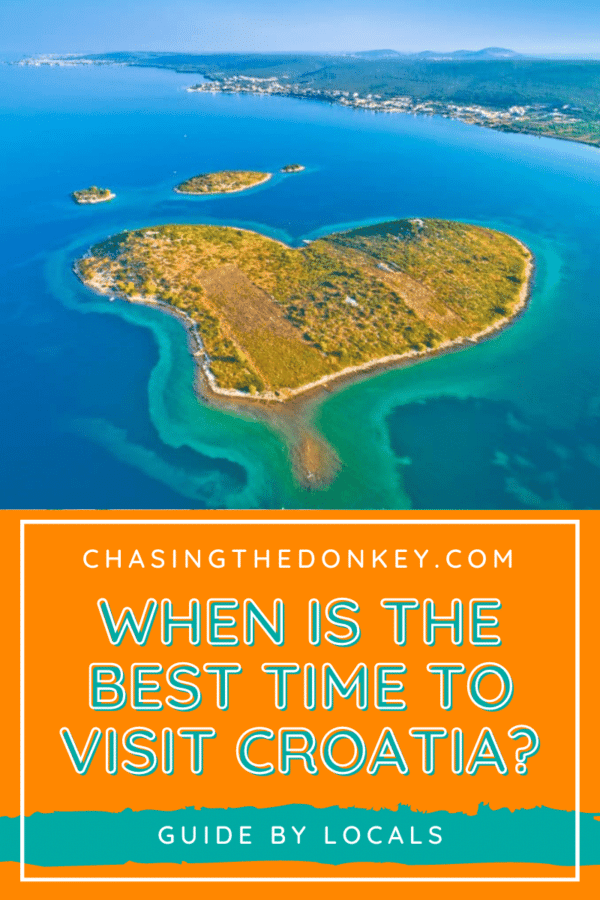
Croatia has become increasingly popular as a tourist destination in Europe over the last decade that I have been living in Croatia, and it’s not surprising!
There are stunning white sand beaches , gorgeous islands with a Mediterranean feel, beautiful lake s and woodlands, and lively historic cities to explore.
There’s not much you can’t do in Croatia, so it’s also an excellent destination for families looking for somewhere with a range of activities to keep everyone happy. Whether you want to be rafting down rivers , hiking in the mountains , or sunbathing on the beach – Croatia is the place to go.
But before you start packing your bags and buying plane tickets, it’s worth considering what you want to do on your holiday so you can figure out the best time to go.
- What To Pack For Croatia
Skip Ahead To My Advice Here!
Croatia Travel Seasons

Most people consider the summer months the best time to visit Croatia. It can get quite hot in summer, but the sunny weather and soaring temperatures are perfect if you plan to sunbathe for most of your holiday and drink cocktails on the beachfront.
On the other hand, spring and autumn have their appeal. While winter can get quite cold, spring is mild and sunny, and autumn is far less crowded, thanks to everyone heading home after the peak summer season.
It’s also worth remembering that the coast is always warmer than inland, even in winter. At this time of year, the coast of Croatia is worth visiting as long as you’re more interested in sightseeing than sunbathing and you don’t mind putting up with occasional rain.
That said, one major drawback of visiting in winter is that you can’t guarantee things will be open. Local business owners tend to take time off in the winter when there aren’t many visitors around, so it’s not unusual for hotels and restaurants to shut down in areas that rely on tourism.
- What To Do In Croatia During Spring
- Best Things To Do In Winter In Croatia
Temperatures In Croatia Throughout The Year
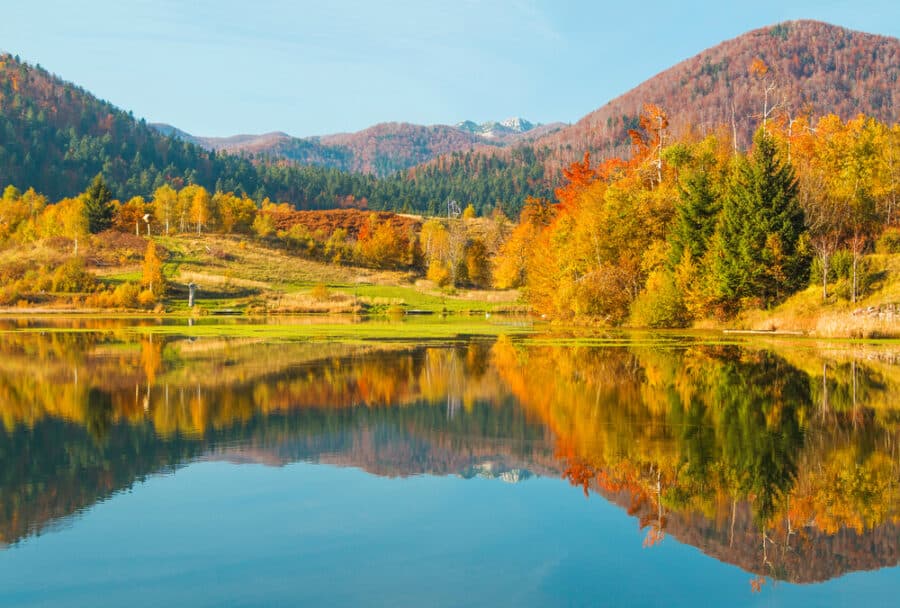
Temperatures vary a lot depending on where you are. To get an idea of the difference in average temperatures in Croatia between the coast and inland, let’s have a look at the temperatures during the year in Split and Zagreb .
Once you know Croatia’s temperatures by month, it’ll be easier for you to decide when the best time to visit is.
December & January Temperatures – Low Season
To start with, December and January are the coldest months of the year, with lows of -2 degrees and highs of 5 degrees in Zagreb. It’s a fair bit warmer along the coast, with lows of 4 degrees and highs of 12 degrees in Split, but it’s definitely not ideal beach or sightseeing weather.
February & March Temperatures
February is slightly warmer, but it’s worth waiting until March when temperatures rise considerably. It’s still chilly in March, with lows close to zero degrees in Zagreb and highs of about 15 degrees even on the warmest days in Split .
April, May & June Temperatures. – Shoulder Season
Ideally, you want to be visiting Croatia in April, May, or June. These are the most pleasant months temperature-wise, with highs oscillating around 20 to 25 degrees and lows of about 7 in April and 14 degrees in June in Zagreb. The coast is warmer again, with highs reaching almost 30 degrees by June and lows staying above 10 degrees throughout April, May, and June.
July & August Temperatures – High Season
In July and August, temperatures don’t drop below 15 degrees in Zagreb, and warm days reach almost 30 degrees. On the other hand, Split doesn’t get cooler than 20 degrees, and super hot days reach over 30 degrees.
September, October & November Temperatures – Shoulder Season
September and October are mild but still holiday-worthy. Split still has highs well over 20 degrees in September, with a slight drop in temperature happening in October, and even the coldest days don’t drop much below 15 degrees.
There’s a noticeable difference in temperatures in Zagreb, though, with lows of 12 degrees in September and 7 degrees by October. However, there are occasional days when the city hits 20 degrees or more in September, and highs in October oscillate around 15 degrees.
November is cooler still, and temperatures drop significantly, especially in Zagreb, in the lead-up to winter.
Overall, the best time to go to Croatia is from April to June , or holding off and visiting in September after most of the big crowds of tourists are gone. May is arguably the best month to visit Croatia, and spring and autumn are the best time of year to see if you want to save money and avoid other tourists.
When To Go To Croatia On A Budget

If money is a big factor in your holiday, and you’re looking to travel on as little as possible, then avoid Croatia in the summer, when all the cruise ships start sailing in, and tourists from around the globe make their way to the coast to enjoy the sun and sand.
It has to be said that Croatia isn’t a seriously expensive destination, which is part of why it’s so attractive compared to other countries in Europe, but prices definitely go up in summer.
Late spring and early autumn are great times to visit Croatia without making a big dent in your bank account. The weather is warm in late spring, and businesses are starting to open back up after the winter, but there aren’t many people around, so prices are much lower.
In autumn, things are starting to cool down after the summer, temperature and crowd-wise, but everything is still open, and it’s warm enough, even in early November, to laze on the beach and snorkel.
One of my first trips to the country was in late September back in 2000; I was on a budget without missing out on anything. I stayed with locals and in the occasional small hotel , cooked when there was a kitchen available but still ate out a fair bit, and traveled to all the major tourist destinations (Plitvice Lakes, Zagreb, Split, and Dubrovnik) without having to miss out on adventure sports or sightseeing.
Of course, I made some compromises, like buying a cheap snorkeling set and exploring the waters closer to shore rather than going on a snorkeling tour. Still, I honestly didn’t feel I missed out on anything on my Croatia bucket list because of my shoestring budget!
- How To Travel Croatia On A Budget
When To Go To Croatia To Party

If anyone knows how to party, it’s the Croatians. They leave it all on the dance floor, and their enthusiasm will keep you up till sunset more than once!
July in Croatia is when most of the nightlife seekers come. University students have finished their exams and are ready to de-stress and go wild while everyone else starts cashing in their time off from work.
While summer is party season around the globe, Croatians have a way of keeping spirits high year-round. So even if you come outside of peak season, you’ll find it hard to avoid the nightlife.
I distinctly remember checking into a hotel in Zagreb in late October to get an early night, only to arrive and find all the locals had shown up for karaoke night!
I’ve never seen anything like it. Safe to say I didn’t make it to bed till after sunset…
Head to Pag, Hvar, Brac, Dubrovnik, or Split if you’re solely in Croatia to party!
- Where To Party In Croatia
Brands We Use And Trust
When to visit croatia for water sports.
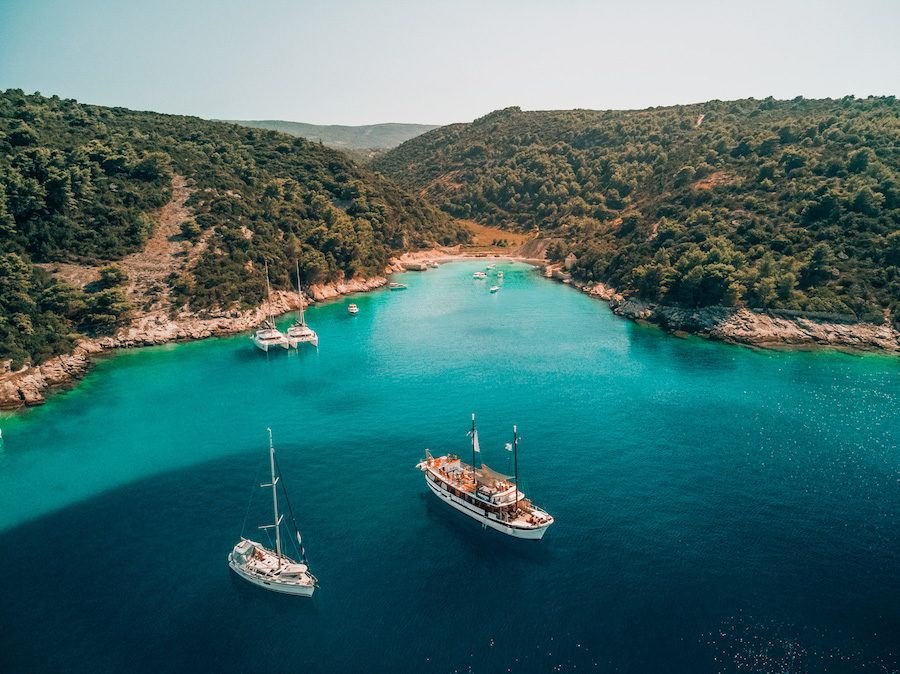
Hello, glorious summer! While late June through to early September aren’t as budget-friendly, it’s definitely the best time of year to visit Croatia for water sports. The warm Adriatic Sea and unique aquatic fauna will make the water hard to resist!
There isn’t just swimming, snorkeling, and scuba-diving , though Croatia is also a hotspot for sailing, rafting, and cruise ships from all over making overnight stops along the coastline.
If you’re planning anything crazy, like renting a yacht for a birthday celebration or going island hopping on a private sailing boat , be sure to book way in advance over the summer months, or slots will get full up – one of the biggest drawbacks of visiting Croatia in the summer.
Outside of peak season, island hopping is also a great thing to do; you’ll get a whole island beach to yourself off the coast of Zadar in October!
If you’re an avid sailor and you want to explore the Adriatic Sea – go sailing in Croatia in September . Lots of sailors will give you this advice, and there’s a good reason for it.
The prices of yachts and sailing boats are lower in September as peak season is over, more rentals are available, the sea and marinas are less busy, and temperatures are still great.
September offers sailors a mix of perfect sailing conditions and fewer crowds, all for a lower price!
- Why You Should Book A Sailing Trip In Croatia
Best Time To Go To Croatia For National Parks
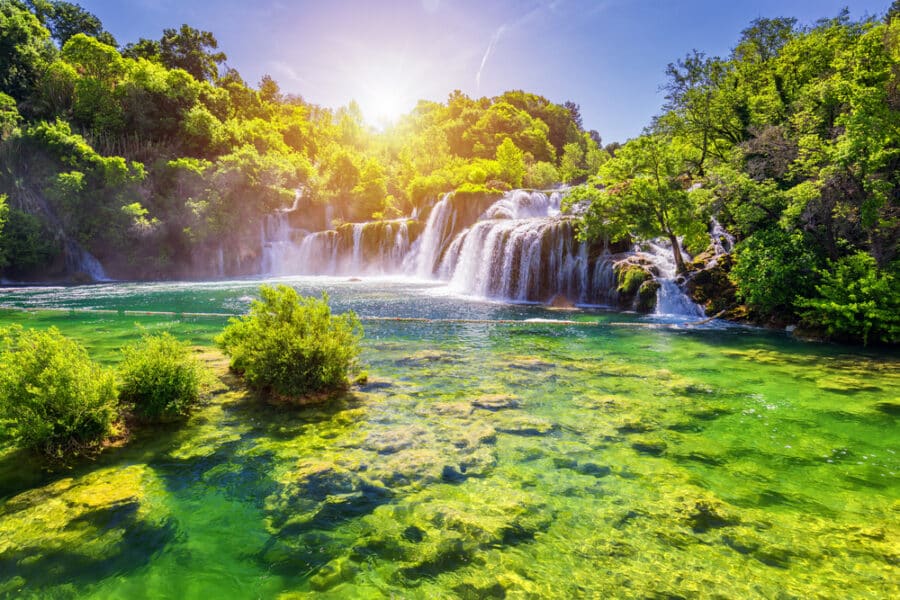
The best time to visit Croatia if you want to visit national parks is spring! It’s not as hot as in the summer, which is a relief if you’re planning on going on long hikes in nature. There’s also very little rainfall in spring, and the lakes and rivers are brimming with water as the winter snow begins to melt.
Suppose you’re planning on going to Croatia in April. In that case, it’s worth checking the temperatures and rainfall in different areas before deciding what national parks you want to go to, as early spring can be a bit hit-and-miss weather-wise. The weather in Croatia in May and June is much more reliable!
Some of the best national parks in Croatia, and there are loads to choose from, are Krka, famous for its stunning clear-blue waterfalls, and Plitvice National Park, a labyrinth of pristine lakes .
Pack your hiking boots and get ready to enjoy Croatia’s incredible national parks without the crowds!
While spring is the best time to visit the country’s national parks overall, some might be worth saving until the summer (but bear in mind there will be more tourists around).
Mljet National Park , which is made up of a network of islands off the coast of Dubrovnik, and Kornati National Park, which is an archipelago in the Northern Dalmatia region known as every sailor’s heaven are hotspots for watersports, so they’re worth visiting in the summer if you want to make the most of the kayaking, sailing, and snorkeling!
- How To Choose Between Krka & Plitvice National Parks
- Where To Stay In Plitvice Lakes
Best Time To Go To Croatia For Festival Season
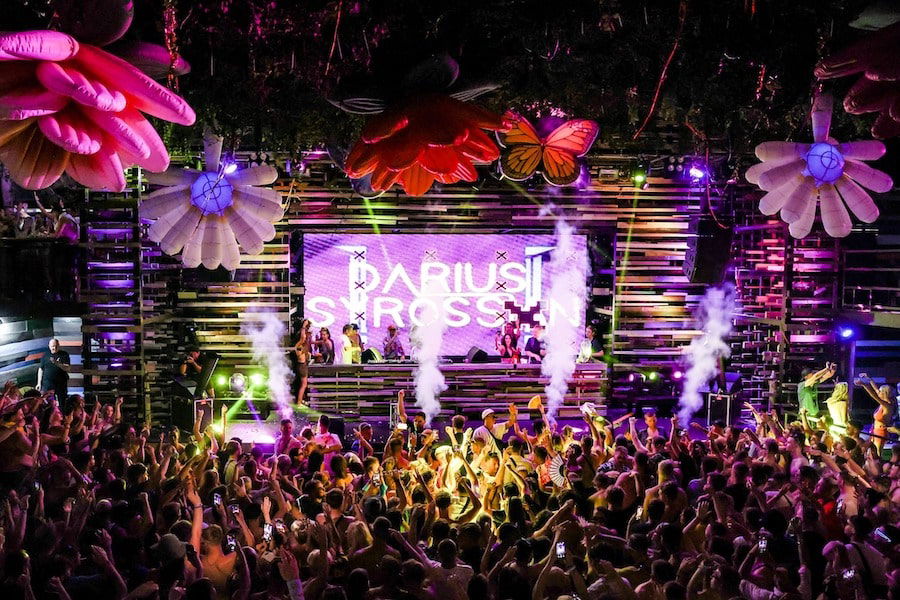
Croatia has a unique culture and heritage, which, mixed with the high spirits of the locals and a few glasses of wine , make their festivals one-of-a-kind. May through September is the best time to visit if you want to dance at music festivals or get an insight into the local culture.
The most well-known festivals are the Nights of Diocletian, the Festival of Flowers, the Dubrovnik Summer Festival, and Zagreb Design Week. They showcase a mixture of Croatia’s old traditions and the country’s modern flare.
There are also a handful of music festivals across the country in spring and summer, like the INmusic Festival, Sonus Festival, and Hideout Festival.
Whether you want to go raving or take part in strange traditions – Croatia has a festival for you.
- Music Festivals In Croatia
- Our Favorite Festivals In Istria
- Festivals In Croatia Not To Miss
Best Time To Go To Croatia With Kids

Traveling with kids can be tricky, especially when they’re little. The tantrums are often as frequent as the memorable moments, so it’s definitely easier to travel to less crowded destinations if you’re going with little ones, and being able to keep things affordable is another plus.
But, with school dates and work, it’s not always easy to go on holiday outside peak season. Ideally, try and make it in late spring or early autumn, and make the most of a half-term week or Easter holidays if you’ve got young children; that way, you’ll avoid being in big crowds or missing out on activities because everything is booked.
On the other hand, if you’re traveling with older kids and you want to do as many activities as possible, summer is the best time to come. It’s worth booking things in advance to avoid disappointment, and the prices increase, but the weather is perfect for beach holidays and water sports!
- What To Expect When Traveling To Croatia With Kids & Babies
- Things To Do In Croatia With Kids
- Backpacking Croatia With Kids
The Best Time To Visit Croatia’s Major Cities
Sightseeing can be super exhausting when it’s really hot, so it’s worth exploring Croatia’s cities in the cooler months. Generally, April, May, September, and October have temperatures ranging from the mid–teens to early twenties, making them the best months for a city break.
On the other hand, if you really want to experience Croatia when no one else is around, then November to March is the best time. Cities along the coast are cool but pretty mild throughout the winter months, though further inland, it is definitely colder.
Another date to consider being in one of Croatia’s major cities is the 25th of June, which is Statehood Day! Locals unite to celebrate the date Croatia gained independence with cultural events and street parties!
Let’s dive deep into the best places to go in Croatia and when!
The Best Time To Visit Dubrovnik
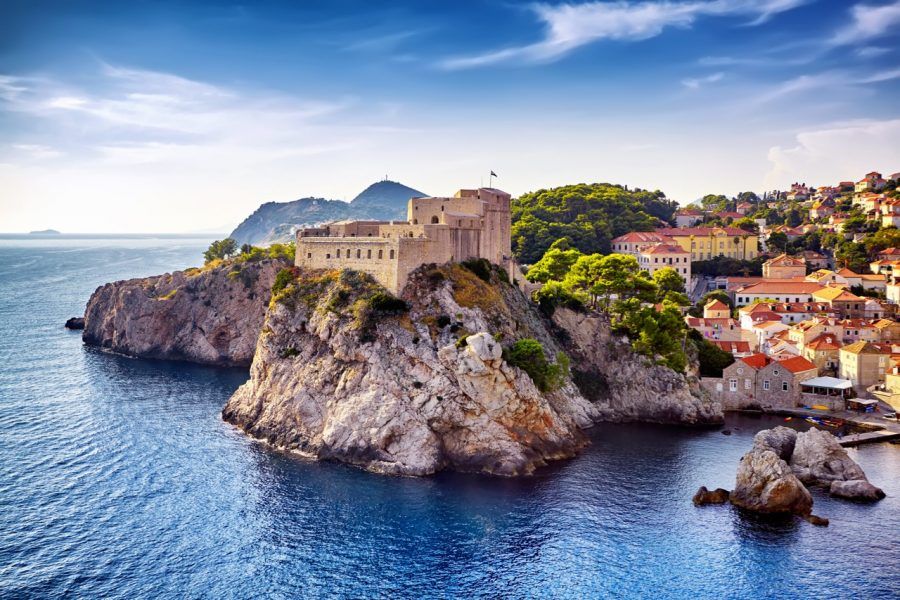
Possibly the most famous city in Croatia, Dubrovnik is as far south along the coast as most travelers go. The city dates as far back as the 7th century and encompasses all the best features of the Dalmatian coast.
The old city walls are a UNESCO World Heritage Site , and as you walk along them, you’ll find lots of artsy cafes, restaurants serving delicious fresh fish, and historical spots.
It’s worth going on a day tour to Lokrum Island and taking the cable car to Mount Srd !
The best time to visit Dubrovnik is off-season , as it’s a super popular destination, and it gets crammed with tourists in the summer. If you’re coming to Croatia in May, during the shoulder season, you’re in luck! This is a great time to head to Dubrovnik – it’s warm, but the cruise ships full of passengers haven’t started rolling in, and hotels won’t be booked out yet.
- Where To Stay In Dubrovnik
- Winter In Dubrovnik? Yes Indeed!
- Best Things To Do In Dubrovnik
The Best Time To Visit Split

Split is the second largest city in Croatia. The old town of Split is a stunning maze of narrow cobbled streets that lead you to open squares and city beaches.
I’d recommend going in the summer to make the most of the city’s beaches, wild nightlife, sightseeing, and outdoor restaurants . Although it’ll be busier than other months, the crowds also mean everything will be open, and more events are on!
If you want to experience a unique cultural event, then you could also come for Saint Domnius Day on the 7th of May and celebrate the city’s patron saint. There are processions, traditional klapa music, street fairs in the evening, and even a rowing contest!
- Where To Stay In Split
- Best Day Trips From Split
- Things To Do In Split
The Best Time To Visit Zagreb

Croatia’s capital city is cute and not as big and overwhelming as some of Europe’s more famous capitals, like Paris and Milan! It’s also much cheaper but still packs a lot of charm and plenty of sightseeing opportunities – making it one of my personal favorites.
It’s one of the colder destinations in Croatia, but coming into the depths of winter is still a top option; autumn is pretty cold and rainy. If you can come in late spring (May and June) or early September, you’ll enjoy the best weather and have the city to yourself!
- Where To Stay In Zagreb
- Zagreb’s Christmas Markets
- Things To Do In Zagreb
The Best Time To Visit Zadar
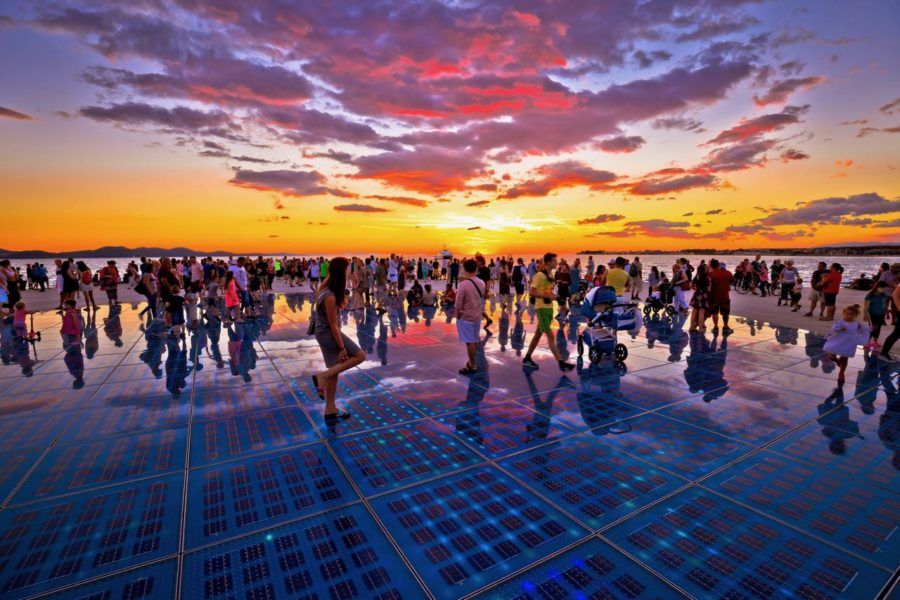
Zadar is less popular than other cities in Croatia, but it’s one of my personal favorites as it’s where I live. It’s surrounded by cute islands with small towns on them that few people visit. The city is riddled with Roman ruins, and it sits at the base of the Velebit mountain range, so there are plenty of hiking trails nearby.
The edge of the city is a long promenade that you can jump off straight into the sea! It boasts some of the best sunsets and is home to the famous Sea Organ and Sun Salutation.
As it’s along the coast, the autumns are warm, and there’s little rain. You can enjoy sunny weather until early November, but it does get ominous quiet! I’d go in late spring when there are still other people out and about and everything is starting to open up.
- Where To Stay In Zadar
- Best Beaches In Zadar
- Things To Do In Zadar
The Best Time To Visit The Coast And Go Island Hopping In Croatia
Croatia has a diverse set of landscapes, and depending on what you want, some seasons are better than others. While hiking in national parks is more enjoyable in autumn, island hopping is a great thing to do in the summer or late spring.
There are about 1,200 islands off the coast of Croatia , so it’s fair to say that wherever you are along the Dalmatian coast, you’ll be able to reach a little island in the Adriatic with a short boat ride. It’s also one of the reasons that Croatia is so popular for sailing!
A great number of the islands are inhabited, so there’s a whole island sub-culture in Croatia that is very different from that of the mainland. The islanders are generally very friendly and generous, too!
One time, I was on a small island off the coast of Zadar, and an older woman came running out of her house and gave me a bag of pomegranates and a smile for no reason!
There’s a huge choice of islands you can go to; some are so small they have little more than a lighthouse turned Airbnb on them designed to accommodate the most solitary holidaymakers; others were once the home of Tito’s political prisoners. Others attract party lovers thanks to their bustling nightlife!
Whichever island you decide to visit if you’re wondering when the best time to visit Croatia’s islands and coast is, you’ve come to the right place.
Best Time To Visit The Dalmatian Coast
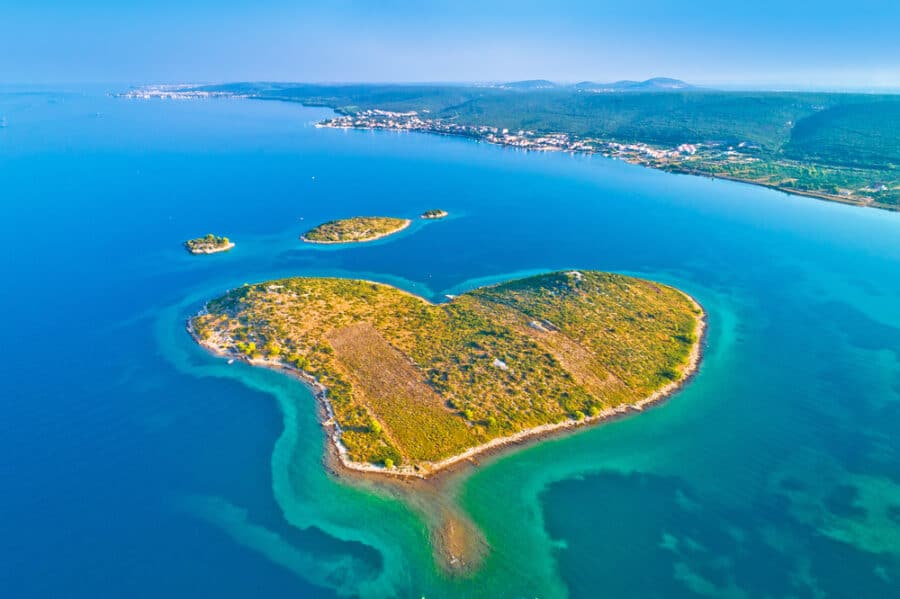
The Dalmatian coast is one of the more year-round, travel-friendly destinations. From warm and mild winters to scorching hot summers, you don’t need to worry about the weather when booking your Dalmatian Coast trip.
If you’re coming over the winter months, pack light layers and a raincoat, but remember to bring warm clothes if you want to head into the mountainous regions along the coast, as the higher up you go, the more likely there’ll be frost and snow.
Spring and autumn have some rainy days, especially in April, September, and October, but they still get a lot of sun, and the drop in temperatures compared to the summer months is no bad thing – July and August really can get too hot!
Over the summer months, it’s usual for it to get to 30 degrees throughout the day, and even at night, temperatures rarely drop below 20 degrees. It’s not hard to see why you’d be looking to catch a summer tan love coming to Croatia in July and August.
Another thing worth thinking about is the sea temperature. If you’re visiting the coast, you’ll want to spend as much time as possible in the water, but snorkeling is far less fun when the water is cold and your lips start turning blue!
From June until October, the sea temperature is consistently above 20 degrees. From November onwards, there’s a drop in temperature, but even in January, February, and March, the water doesn’t drop below around 14 degrees. If you’re used to swimming in the Atlantic, the Adriatic Sea is going to feel more like a bath than a dip in the ocean!
The Dalmatian coast is split up into three regions: northern, central, and southern Dalmatia.
Top destinations along the Dalmatian coast include Zadar (in the north), Split and the islands of Brač (in central Dalmatia), and Dubrovnik and the island of Korčula (in southern Dalmatia).
- Where To Stay In Korcula
Best Time To Visit Hvar Island

The stunning Hvar Island has a lot of historical sites, like the Stari Grad plains, a UNESCO World Heritage Site, and the Hvar theater, constructed in 1612.
The Illyrians, Greeks, Romans, Byzantines, Croatians, Venetians, Austrians, French, and Italians ruled the island. Thanks to the array of civilizations that have influenced the island, it has a unique and diverse set of traditions that have shaped its people – known to be some of the friendliest and warmest around!
There are a few different destinations worth considering for accommodation, like Hvar Town itself, Stari Grad, and Jelsa. They all have a cute fishing-town feel to them and stretches of gorgeous coast to explore.
Hvar town is the busiest and the most expensive – though it does have the best nightlife and the fanciest places to eat and stay. Jelsa has some charming beaches, though they aren’t all sandy, and it’s a lot quieter than Hvar.
On the other hand, there are also a handful of small villages you can choose from, like Vrboska, Milna, and Sveta, if you’re looking for a peaceful island escape.
Weather-wise, the best time to go to Hvar and the surrounding islands is from June through to October.
With temperatures reaching 30 degrees and sea temperatures reaching 25 degrees in July and August, visiting over the peak summer months is tempting. Still, the prices of accommodation and tours really do skyrocket.
- Where To Stay In Hvar
- Secret Things To Do On Hvar
Best Time To Visit Vis Island

The island of Vis is cute and covered in small towns with a very authentic local feel to them. However, the main reason people visit isn’t really the island itself – it’s the blue cave of Biševo just off the island’s shore that has everyone in a craze.
Curiously, the island was the Yugoslav National Army base from 1950 to 1989, during which tourists weren’t allowed on the island. Now, the two hotspots around the island are Vis Town and Komiža.
Like Hvar, late spring is a great time to come to Vis if you want to avoid the crowds and make the most of the cheaper accommodation.
Best Time To Visit Rab

The island of Rab became popular after King Edward VIII took his wife, Wallis Simpson, here in 1936. It’s nestled into Kvarner Bay and popular thanks to its nudist-friendly beaches. According to legend, the tradition was kickstarted by King Edward VIII himself.
Rapska Fjera is the oldest and largest medieval festival in Croatia, and it all began when Rab Town Council decided to pay tribute to King Louis the Great, who freed the island from Venetian rule. It used to last two weeks, but now it lasts just two – from the 25th to the 27th of July. Small artisan stalls and craft workshops pop up around the island’s towns, and everyone dresses up and enjoys vast amounts of wine in true medieval spirit!
Rustic and quaint, the towns here are a patchwork of terracotta roofs and church towers. There are plenty of festivities throughout the summer months, too, and as it’s lesser known than other islands, it’s a popular destination for families especially. It’s worth coming in peak season when the weather is at its best, or for the festival in late July, the first part of August is also ideal!
What is the best time to visit Croatia for a beach vacation?
The best time to visit Croatia for a beach vacation is during the summer months, from June to August. The weather is warm and perfect for swimming in the Adriatic Sea.
When is the ideal time to explore Croatia’s national parks?
The ideal time to explore Croatia’s national parks is during the spring (April to June) and autumn (September to October). The weather is pleasant, and the parks are less crowded compared to the peak summer season.
What is the best time to visit Croatia to avoid crowds?
If you prefer to avoid crowds, consider visiting Croatia in the shoulder seasons of late spring (May) or early autumn (September). During these months, the weather is still pleasant, but tourist numbers are lower.
Is winter a good time to visit Croatia?
Winter can be an excellent time to visit Croatia if you enjoy festive holiday markets and cultural events . Coastal towns and cities like Dubrovnik and Split are less crowded, but some tourist attractions may have reduced operating hours.
What are the weather conditions like in Croatia during the summer?
During the summer, Croatia experiences hot and sunny weather, especially along the coast. Temperatures can reach highs of 30°C (86°F) or more, making it perfect for beach activities and water sports.
When is the best time to visit Croatia for cultural festivals?
If you’re interested in cultural festivals, consider visiting Croatia during the summer months when many cities host events like music festivals, art exhibitions, and traditional celebrations.
What is the rainy season in Croatia?
The rainy season in Croatia typically occurs during the late autumn and early spring months. November and March are known to have increased rainfall, but it can vary each year.
Are there any specific events or activities during the best time to visit Croatia?
Yes, during the best time to visit Croatia, you can enjoy events like the Dubrovnik Summer Festival, Ultra Europe Music Festival in Split, and various water sports and beach activities along the Adriatic coast.
Phew, that was a lot, right? I hope you now feel like you know the best time to go to Croatia for what interests you.
Leave a Reply Cancel reply
Your email address will not be published. Required fields are marked *
Save my name, email, and website in this browser for the next time I comment.
This site uses Akismet to reduce spam. Learn how your comment data is processed .
Move This Adventure To Your Inbox & Get An Instant Freebie
Subscribe To Unlock Your FREE Customizable Travel Packing List & All Our Best Tips!
Unlock Your FREE Customizable Travel Packing List!
Subscribe Now For Instant Access To Stress-Free Packing

IMAGES
VIDEO
COMMENTS
Late spring and early fall are arguably the best times to visit Croatia. Sea temperatures are pleasant, and there's plenty of sunshine, but the country's pebble beaches and rocky coves are relatively quiet. With endless still seas, May and September are great times to sail in Croatia. Onshore, these are the best times to cycle, hike or ...
Don't despair - there are actually many advantages of traveling to Croatia in April, as opposed to high season months. Here are some of the main things that we liked about Croatia in April: 1. There are fewer tourists in Croatia in April than in summer. One of the reasons we chose to visit Croatia in low season was the hope to avoid the crowds.
The best time to visit Croatia is during June, when the weather is nice and businesses return to their summer schedules, but crowds aren't quite in full swing yet. Any time during the shoulder seasons, which run from late April to mid-June for the spring shoulder season and September to October for the fall shoulder season, is a good time to visit.
June is the best time to visit Croatia if you're set on a summer holiday. The summer crowds haven't peaked, but the ferries are fully operating, and the weather is hot and dry. Still be sure to book everything in advance to avoid disappointment. July is the height of the event and festival season in Croatia.
Pula, a beautiful coastal city in Croatia, is a must-visit destination for those seeking history, nature, and Italian-style architecture. The best time to visit Pula is during the summer months, from June to September. The weather during these months is sunny and warm, with temperatures averaging around 26°C.
The best time to visit Croatia is during May, June, September, or October. These are the months when all the tour operators and hotels are open, the weather is warm and pleasant, and the crowds are manageable. I visited Croatia over the entire month of June and found it to be the perfect time to travel to Croatia.
While June and September are still technically considered high season, there is a world of difference in crowd levels in places like Split and Dubrovnik. Shoulder season in Croatia is April to May and late September to October. During this time you have decent prices, few crowds, and zero cruise ships.
Airlines and hotels haven't yet upped their rates, making April a good time to visit. Many Croats will be traveling within the country during this time for Easter celebrations, as well as hitting up the numerous festivals across the country. ... Best Time of Year to Visit Croatia How Many Days to Spend in Croatia. Written by Julia van der Sluis ...
What to pack in Croatia for April. March, April, and May are the spring season in the country. Spring in Croatia is still colder than usual, bit weather is generally mild and perfect for exploring. The items listed here are ideal for still keeping warm, yet comfortable and ensures easy movement. V-neck shirts - bring at least 3, in different ...
December brings festive cheer to Croatia, with twinkling lights and decorations adorning the cities and towns. Average highs range from 9°C to 13°C, with the sea temperature cooling to around 14°C. December is a magical time to visit Croatia, with Christmas markets, concerts, and events celebrating the holiday spirit.
Tourism is on the rise as more people think that now is the best time to visit Croatia. But the country has a long history of enchanting travelers with its natural gems. ... April is a great time of year to do a custom-made trip by train or car to explore all the nooks and crannies of Croatia. There is so much to see and April, being a shoulder ...
Most are marked with FKK - the German phrase "Frei-Körper-Kultur," meaning free body culture - which isn't surprising as Germans make up some of the biggest numbers of tourists in Croatia. Away from the FKK beaches, topless bathing is quite common. 8. Dodge the crowds in Dubrovnik by timing your visit carefully.
The best time to visit Croatia depends on where you're going and what you're hoping to see. Discover the best time of year for travelling to Croatia and start planning your trip with our complete guide. ... Easter aside, April is also the best month to travel to Croatia for a shoulder season flight at bargain prices, and enjoy a city break ...
The best time to visit Croatia is during the summer months, from June to September, when sunlight is plentiful and temperatures are warm, between 66°F and 86°F. These conditions are ideal for boating and swimming in the blue waters around the islands. The cooler conditions of April, May and October lend themselves to a wide range of other ...
Before I tell you the best time to visit Croatia, I am gonna tell you the worst time to visit. ... You'll notice three distinctive seasons in Croatia. A low season in Croatia is from November through April. A shoulder-season includes a period from May to mid-June, and from mid-September through October, while a high season runs from mid-June ...
The best time to visit Croatia is at the beginning of April. The weather is super pleasant and you can get decent sunlight during your entire stay. The average temperature during day time is 12°C, you can expect the temperature to go maximum high as 15°C and 8°C is the minimum temperature. Usually, the weather is pleasant during April when ...
18° average. average temperatures. 11 mm. precipitation. 12h 31m. daylight duration. Due to balmy weather and a diminishing number of tourists, September is deemed to be the best month to visit Croatia. By the time the fall comes, the summer scorcher in the country decreases, but the warmth in the air stays still.
July and August are ideal. If you're after slow island-hopping, late September is your best bet. For walks and cycling visit in late-April and May. Here we reveal how to make Croatia the ...
May and June. May and June are ideal months to visit Croatia if you prefer milder temperatures and fewer tourists. The average temperature during this time ranges from 18°C to 23°C (64°F to 73°F), making it comfortable for exploring the country's stunning landscapes and historical sites.
The best time to visit Croatia is in the summer (June to September) when the weather is hot and sunny, the glittering coast is at its best and the festival season is in full swing. That being said, figuring out when to visit ultimately depends on what kind of holiday you want. Croatia's climate varies from continental to Mediterranean and there ...
The summer months are the best time to go to Croatia weather-wise, with July and August being the warmest. The average temperature in June during the day is 26°С and the sea temperature is 23°С. In July, you can expect temperatures of around 29°С and sea temperatures at 25°С. August is the hottest month of the year in Croatia, with ...
Tourist traffic in Slovenia and Croatia (especially the coastal towns) is extremely seasonal. The peak season hits suddenly and floods the towns like a tidal wave, only to recede a couple months later — leaving empty streets and dazed locals. In general, the tourist season runs roughly from mid-May through early October, peaking in early August.
Overall, the best time to go to Croatia is from April to June, or holding off and visiting in September after most of the big crowds of tourists are gone. May is arguably the best month to visit Croatia, and spring and autumn are the best time of year to see if you want to save money and avoid other tourists.